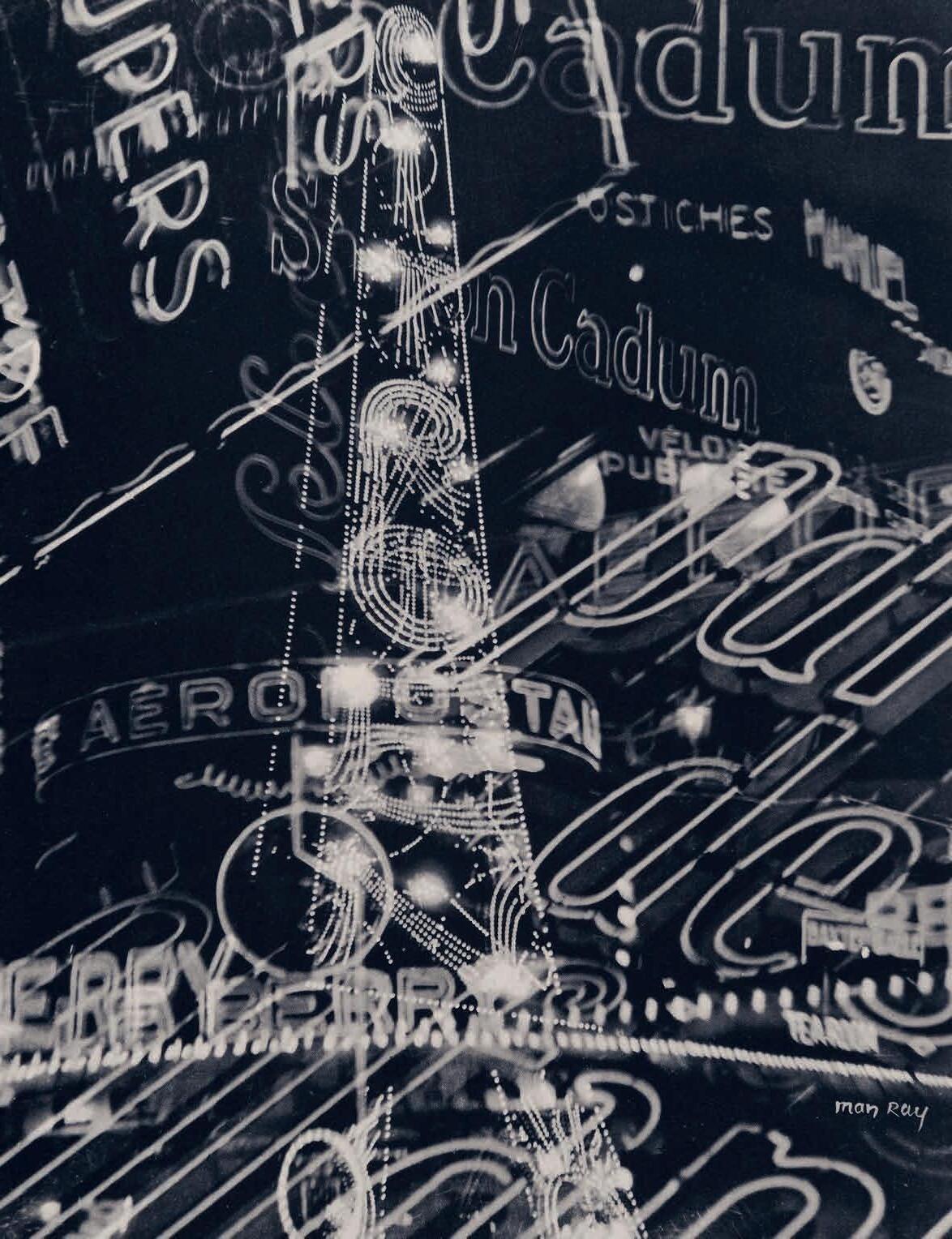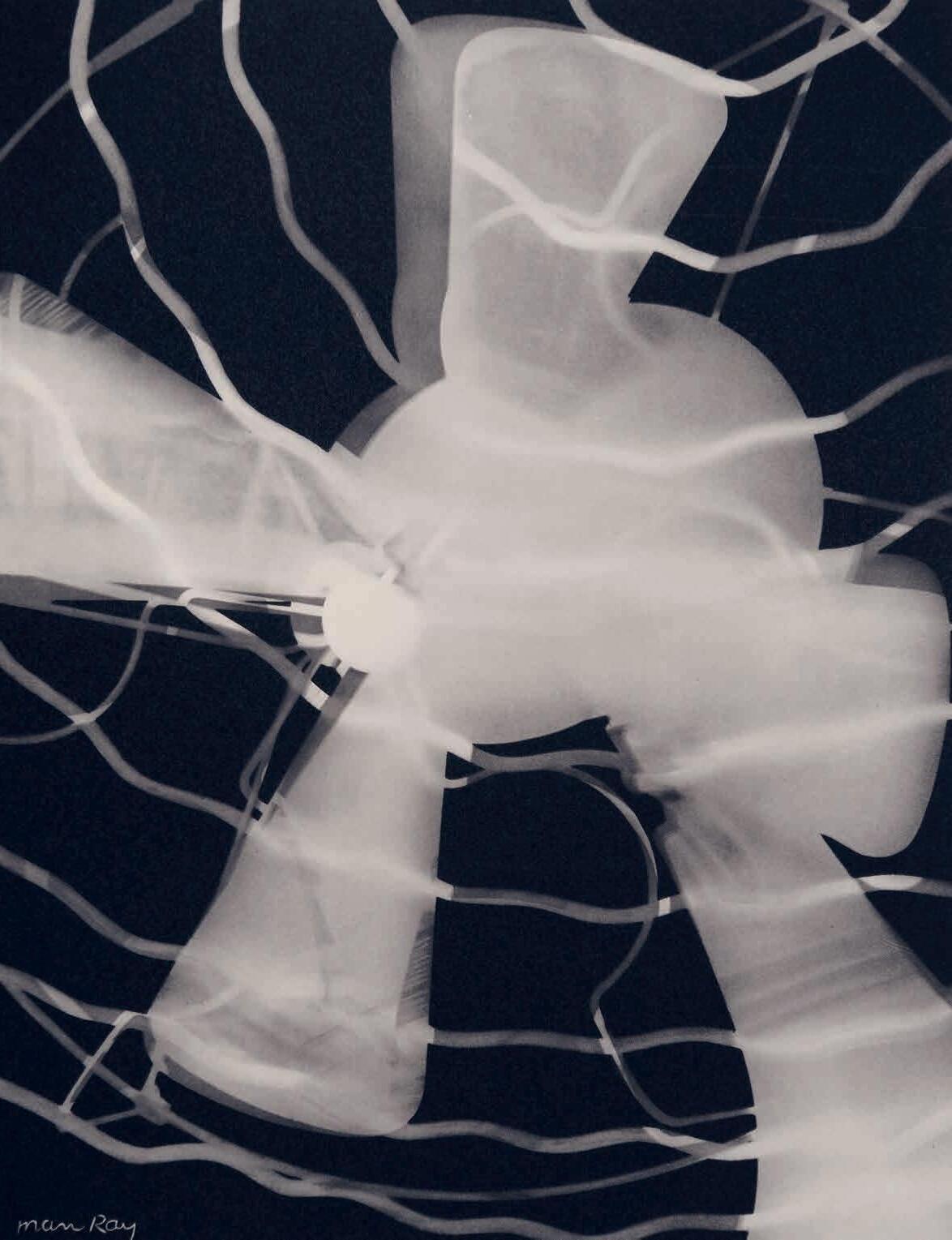

PHOTOGRAPHY BOOKS & EPHEMERA

PHOTOGRAPHY BOOKS & EPHEMERA Shapero Rare Books

PRESENTATION COPY
ABBOTT, Berenice. Greenwich Village Today & Yesterday. Photographs by Berenice Abbott. Text by Henry Wysham Lanier. New York, Harper & Brothers Publishers, 1949. [ref. 111377] £3500
Presentation copy, inscribed by Abbott to her friend Marjorie C. Fairbanks: ‘For Marge / With my love / Berenice’. With Fairbanks’s ownership signature, brief marginal notes to two pages, and a note below the inscription: ‘N.Y.C. Jan ’51 – and she’s right to crab about / the cover – an awful mess – the beautiful flying / deer (pg 115) would have been so much better. / Text not as bad as she said – but difficult / to read.’
Marjorie Crocker Fairbanks was born in Boston and travelled widely throughout Europe, working in Paris as a volunteer with the ambulance service to aid in relief work during the First World War. She and Berenice Abbott met in Paris in the 1920s and remained close when they returned to the United States. Fairbanks had a wide circle of friends in Paris and
New York literary, artistic, and culinary circles. For a time after the Second World War, she and her son Austin managed the folk and blues singer Lead Belly (Huddie Ledbetter), organising an ambitious world tour cut short when Lead Belly died in 1949. Abbott’s portrait of him was used on the posthumous album Take This Hammer (1950).
First edition, presentation copy inscribed on the front free endpaper, with a note by the recipient below; 8vo (235 x 157 mm, 9¼ x 6¼ in); black-and-white photographs printed in gravure in 4 gatherings of 16pp, edges a little dusty; plain endpapers, black cloth-covered boards, titles to spine and upper side in yellow and green, light rubbing to extremities, photo-illustrated dust-jacket printed in green and black, spine lightly faded, light wear to edges, short tear and related crease to rear panel, near-fine in a very good dust-jacket; xi, [iii], 161, [1]pp.
Provenance: Marjorie C. Fairbanks (author’s presentation inscription).
02
ABBOTT, Berenice. Autograph Letter Signed [with] two signed cards to Edna Bennett. Blanchard, Maine, 19 June 1977. [ref. 111313] £975
The recipient, Edna ‘Bennie’ Bennett, was a photographer, writer, naturalist, an editor of US Camera and contributor to Aperture, and later a used bookseller on Long Island, and a friend of Berenice Abbott and Lisette Model (see item 73).
ALS; US Letter (279 x 215 mm, 11 x 8½ in); one page in red ink on Abbott’s headed paper with a copy of Bennett’s TL reply to Abbott attached; [with] 2 undated folding greetings cards from Abbott to Bennett illustrated with Abbott’s photographs, the first reproducing ‘New York City at Night, 1933’ (141 x 117 mm, 5½ x 4½ in), pin holes to corners and light wear, the second reproducing ‘Berenice Abbott, Untitled (Reindeer in shop window). N.d. (163 x 125 mm, 6½ x 5 in) with light spotting.
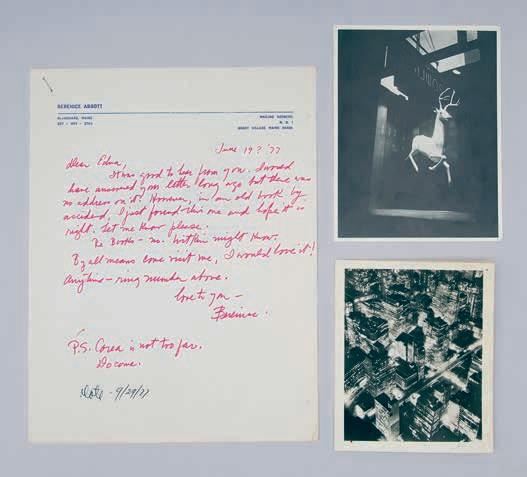
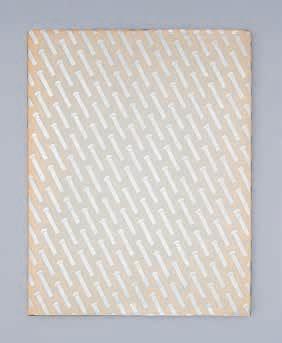
03
ABBOTT, Berenice; BOURKE-WHITE , Margaret et al. The Last Rivet. 1939 [-] 1940. The Story of Rockefeller Center, a city within a city, as told at the ceremony in which John D. Rockefeller Jr., drove the last rivet of the last building, November 1, 1939. New York, Columbia University Press, 1940. [ref. 111715] £975
The Last Rivet was produced to celebrate the completion of the Rockefeller Center. It contains photographs by Berenice Abbott, Margaret Bourke-White, Brown Brothers, J. Walker
Grimm, Fritz Henle, Wendell Macrae, Newspictures Inc., New York Herald Tribune, Edward Ratcliffe, and Paul J. Woolf. While copies are often accompanied by a standard letter from John D. Rockefeller, this copy has a letter from Nelson Rockefeller apologising on his father’s behalf for not inviting the recipient to the rivet-driving ceremony.
First edition with a personalised ALS from Nelson Rockefeller on Rockefeller Center, Inc., headed paper; 4to (279 x 218 mm, 11 x 8½ in); black-and-white photographs printed in relief halftone; illustrated endpapers, green flock-covered boards, brown cloth spine, titles stamped in silver on spine, minor shelfwear, inlaid ‘rivet’ in silver card on upper side, illustrated dust-jacket printed in silver, spine and edges lightly toned, short tear and crease to bottom edge and crease to top edge of upper panel, an excellent copy; 45, [3]pp.
04
ARAKI , Nobuyoshi. Small collection of printed ephemera. Tokyo, 1970-76. [ref. 110665] £20,000
A small collection of nine pieces of printed ephemera relating to Araki’s books, exhibitions, and performances in Tokyo (197076), including two invitations comprising original photographs.
Photographic invitation, Araki Nobuyoshi Kitchen Ramen Series 5th installment, Woman – Ikuyo Shoko, Lover – Otsuka WESE. October 3, 1970. [Tokyo], 1970. Vintage gelatin silver

photograph (102 X 232 mm, 4 X 9¼ in), sheet of photocopied text trimmed to the same size and stapled to the front. [with:] Photographic exhibition invitation, Nobuyoshi Araki's Letter Art 5 Technicolour Paid Photo Exhibition Foreplay, April 28 to May 23. kebukuro Art Theater Coloring Book illustration exhibition at the men's and Women's toilets [Tokyo], [1971]. Vintage gelatin silver photograph (102 X 232 mm, 4 X 9¼ in), partially coloured in ink, sheet of photocopied text trimmed to the same size and stapled to the front. [And:] Poster for Spaceship '72 Free Tatsumi Shiro, Araki Nobuyoshi Exhibition June 21st 1972. Tokyo, 1972. (284 X 387 mm, 11¼ X 15¼ in). [And:] Flyer for Super Photographic Concert. Araki in collaboration with Shoji Sakamoto, Aoyama Tower Hall, Tokyo. July 3-4, 1972. (257 X 182 mm, 10 X 7¼ in). Tokyo, [1972]. [And:] Two tickets for Super Photographic Concert. Araki in collaboration with Shoji Sakamoto, Aoyama Tower Hall, Tokyo. July 3-4, 1972. (93 X 188mm, 3¾ X 7½ in). Tokyo, [1972]. [And:] Flyer for Pseudo Documentary Silver Halide Exhibition: Voice of a Cicada / Kinokuniya Gallery, Tokyo. August 13-14, 1973. [Tokyo], [1973]. Flyer (185 X 252 mm, 7¼ X 10 in). Contemporary photocopy on blue paper as issued, folded twice. Both items in the original printed Kinokuniya, envelope slit open along one short edge, addressed to Miyahiko. Miki with Araki's. name written at the bottom left corner. [And:] announcement postcard for Tokyo: Araki Nobuyoshi Photobook 3 [1973]. Postcard (101 X 149 mm, 4 X 5¾ in) printed in offset. [And:] Invitation for Notes on Taeko, Seibu Book Center, Tokyo, November 26 – December 9 1976. Tokyo, 1976. Flyer (198 X 169 mm, 7¾ X 6¾ in) printed in offset.

ARAKI , Nobuyoshi.
Senchimentaru na Tabi [Sentimental Journey]. Tokyo, privately printed, 1971. [ref. 111533] £8750
An early presentation copy of Araki Nobuyoshi’s most important work, inscribed to Asahi Sonorama Chief Editor Tatsuo Shira with a drawing of a three-trunked elephant, which was Araki’s preferred method of embellishment in the 1970s. Sentimental Journey is Araki’s signature work, comprising photographs made while on honeymoon with his wife Yoko in Yanagawa on Japan’s Kyushu island. Araki’s exposure of this
most intimate of occasions attracted much criticism in a country which still valued a strict code of behaviour, but ultimately, by putting his private life forward for public scrutiny, he paved the way for successive generations of Japanese photographers to work in a similar vein.
Initially, Araki had intended for Sentimental Journey to contain no text. However, after publication and at the request of the bookshop Kinokuniya, he wrote a short introduction that rejects the falseness and insincerity of much photography and compares his work to the popular post-war literary form of the ‘I’ novel. This text was printed on a green leaf of paper and laid into the book.
First edition, presentation copy inscribed by Araki on the upper wrapper with a drawing, his address on the lower side crossed out; 4to (238 x 238 mm, 9¼ x 9¼ in); black-and-white photographs printed in offset; wire-stitched with white photoillustrated card wrappers, printed in black, light rubbing and soiling, minor foxing to sides and edges, a near-fine copy with the printed leaf of green paper added by Araki shortly after publication at a bookshop’s request; [108]pp.
Provoke pp11-12; The Book of 101 Books pp206-7; The Photobook: A History I, p295; The Open Book pp268-9; Auer Collection p527; Self Life Death p694; A Book of Araki Books pp3845; Japanese Photobooks of the 1960s and ’70s pp108-115; The Japanese Photobook 321.

06
INSCRIBED WITH A DRAWING ARAKI , Nobuyoshi.
Okinawa, Araki Nobuyoshi Shashinshu 2, Zoku Senchimentaru na tabi [Okinawa: Araki Nobuyoshi Photobook 2. Sentimental Journey Continued]. Tokyo, privately printed, 1971. [ref. 110664] £2500
Presentation copy, likely contemporary, inscribed with a drawing of a three-trunked elephant, which was Araki’s preferred method of embellishment in the 1970s. Although the title suggests that it is a continuation of the work he made during his honeymoon in Sentimental Journey (1971), the work is, in fact, unrelated and consists of a series of street scenes, some nudes and a few photographs of his wife, Yoko. Araki made the photographs during a visit to Okinawa for the Dentsu advertising agency while working on a poster campaign for the Japanese Government to mark the return of Okinawa Island to Japanese administration after 27 years of United States control. This is the last book Araki produced before leaving his advertising job at the Dentsu agency in 1972.
First edition, presentation copy, likely contemporary, inscribed with a drawing of a three-trunked elephant; oblong 8vo (126 x 182 mm, 5 x 7¼ in); black-and-white photographs printed in offset, light spotting to edges; wire stitched with white photo-illustrated wrappers, printed in black, minor wear, light spotting to sides, light crease along the upper fold, a very good copy; [200]pp.
The Open Book pp270–1; Self Life Death p694; A Book of Araki Books! p50; Japanese Photobooks of the 1960s and ’70s pp108–115.

07
ARAKI , Nobuyoshi. Senchimentaru na tabi fuyu no tabi [Sentimental Journey, Winter Journey]. Tokyo, Shinchosha, 1991. [ref. 111202] £375
Sentimental Journey, Winter Journey consists of two parts, starting with a selection from Sentimental Journey (1971), photographs Araki took on honeymoon with his wife, Yoko. The remainder of the book documents the last six months of Yoko’s life, beginning with a photograph taken on her birthday, May 17 1989. These photographs include moments between hospital visits and end with Yoko’s funeral. Araki and Yoko’s cat Chiro features prominently, and the final four photographs, taken on the day of the funeral, show Chiro in their apartment, staring out of the window and jumping outside in the snow.
First edition; oblong 8vo (182 x 252 mm, 7¼ x 10 in); black-andwhite photographs printed in offset, design by Suzuki Seiichi; plain endpapers, red cloth-covered boards spine stamped in black, lower board in clear foil, publisher’s illustrated slipcase, fine, publisher’s ephemera laid in, fine; [124]pp.
Self Life Death p698; A Book of Araki Books! pp176–181.
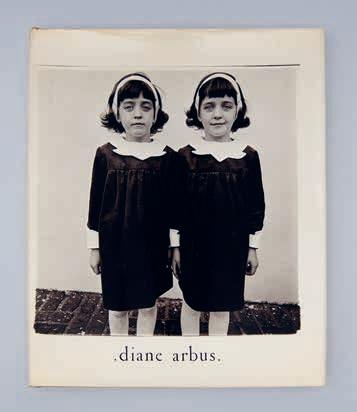
08
INSCRIBED BY ONE OF ARBUS’S SUBJECTS AT THEIR PAGE ARBUS , Diane. Diane Arbus. Millerton, New York, An Aperture Monograph, 1972. [ref. 111534] £2250
Inscribed on the page featuring the photograph ‘Transvestite at a drag ball, N.Y.C. 1970’ :‘Thanks for your warmness / & friendship / Le Ray R. [?] / [Maine?] x / 3/13/76’. The following page with the photograph ‘Two girls in identical raincoats, Central Park, N.Y.C. 1969’ which was removed from some subsequent printings.
In February 1971, Diane Arbus wrote to John Szarkowski asking him to serve as a reference for the Ingram Merrill Foundation and enclosed her proposal for a new project called The Quiet Minorities: ‘The sign for a minority is the Difference. Those of birth, accident, choice, belief, predilection, inertia. (Some are partial and temporary, others irrevocable...) Every difference is a Likeness too... Not to ignore them, not to lump them all together, but to watch them, to take notice, to pay attention.’
Four months later, Arbus took her own life at the age of 48. In the following months, plans were made for the present book, edited by her friend Marvin Israel with her eldest daughter Doon, to accompany an exhibition at the Museum of Modern Art, New York (7 November 1972–21 January 1973), curated by John Szarkowski.
First edition, inscribed by one of Arbus’s subjects at their page with their photograph; 4to (278 x 232 mm, 11 x 9¼ in); blackand-white photographs in offset printed by Rapoport Printing Corporation, text edited from tape recordings of a series of classes Arbus gave in 1971 as well as from interviews and her writings, edges toned, occasional marks; plain endpapers, white photo-illustrated paper-covered boards printed in black, light toning, light wear to extremities, top corner tapped, edges toned, white photo-illustrated dust-jacket printed in black, light toning, small mark at foot, light creasing to flaps, short tear to head of lower spine-fold strengthened internally, a close to near-fine copy; [viii], 15, [161]pp.
Regards à travers Le Livre 149; The Book of 101 Books pp214–5; The Photobook: A History I, pp258–9; The Open Book pp284–5; Auer Collection p546; What They Saw: Historical Photobooks by Women pp198–9.

09
INSCRIBED TO HILARY GERRARD
ARMSTRONG-JONES , Tony (Lord Snowdon). London. London, Weidenfeld & Nicholson, 1958. [ref. 111724] £400
First edition, presentation copy, inscribed: ‘To Hilary / With best wishes / from / Tony Armstrong-Jones – / Snowdon’. This is the second issue of dust-jacket, produced at the photographer’s request after he expressed dissatisfaction with the original.
First edition, presentation copy inscribed on dedication page; 4to (292 x 229 mm, 11½ x 9 in); black-and-white photographs printed in relief halftone, design by Mark Boxer; photo-illustrated endpapers, light blue cloth-covered boards, titles stamped to spine in gold, spine leaning, light shelfwear and a small mark on upper side, white printed dust-jacket, titles in blue and red, lightly toned, chip and creasing to top edge of upper panel, short tear to bottom edge of rear panel, a very good copy; [142]pp.
Provenance: Hilary Gerrard (author’s inscription).
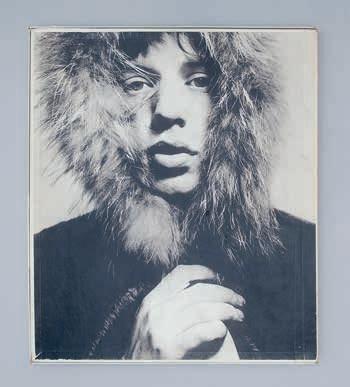
10
BAILEY, David. David Bailey’s box of pin-ups. London, Weidenfeld & Nicolson, 1965. [ref. 111697] £12,500
On the lower ‘David Bailey is fascinated by tinsel – a bright, brittle quality, the more appealing because it tarnishes so soon. He has photographed the people who in England today seem glamorous to him. Some of them happen to be famous – John
Lennon, Paul McCartney, Mick Jagger, Jean Shrimpton, Lord Snowdon, Cecil Beaton, Nuryev. Others operate behind the scenes – film producers, art directors, advertising executives, designers, photographers, nightclub owners. Suprisingly few are female – Bailey’s standards here are so rigorous that only four girls qualify, all of whom are professional models. But in the age of Mick Jagger, it is the boys who are the pin-ups: and Bailey’s pictures give them all the inward , self-sufficient look of Narcissus.’
First edition; original photo-illustrated paper-covered card drop spine box containing 36 loose prints (380 x 330 mm, 15 x 13 in), a brown leaf of paper and a piece of cardboard stamped ‘packing piece to be thrown away’; black-and-white halftone photographs with biographical notes by Francis Wyndham on verso, design by Mark Boxer and David Hillman; light wear, minor creasing, one corner of lid split, the other partially split, a superior copy of Bailey’s most desirable publication.
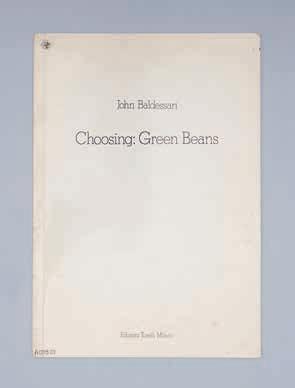
11
BALDESSARI , John. Choosing: Green Beans. Milano, Edizioni Toselli, 1972. [ref. 111122] £750
An exhibited copy of this 1970s conceptual artists’ book. In the introduction, Baldessari explains that Choosing: Green Beans documents a game devised for two players: ‘This work is part of a series of works about choosing. In this version a group of green beans was available from which to choose. A participant was asked to choose any three beans from the group for whatever reasons he/she might have at that moment. A photograph was taken of the selection process. The chosen bean was carried over; the other two beans not chosen were discarded; two new beans were added. The next choice was made, and so on. Each of the participants develops strategies unknown to the other player as the selection process continues until all the beans are used.’
This copy has the ink stamp dated 27 Juli 1974 of the Art Information Centre (1969-1993), a non-profit organisation established by Peter van Beveren in Middelburg, Holland, which collected printed material related to contemporary art (see item 14). The hole punched through one corner allowed the book to be suspended from the ceiling when exhibited.
First edition; 4to (296 x 207 mm, 11¾ x 8¼ in); colour photographs printed in offset, introduction by Baldessari in Italian
and English, design by A. Sganzerla; side-stapled, printed card wrappers, text in black, lightly toned, light spotting, handling creases, hole punched through one corner to facilitate display in an exhibition, ‘Art Information Centre’ ink stamp on first page, a very good copy; [28]pp.
Provenance: Peter van Beveren / Art Information Centre (ownership stamp).
Book as Artwork pp93; Esthétique du Livre d’Artiste pp276; The Photobook A History II, pp146–7.
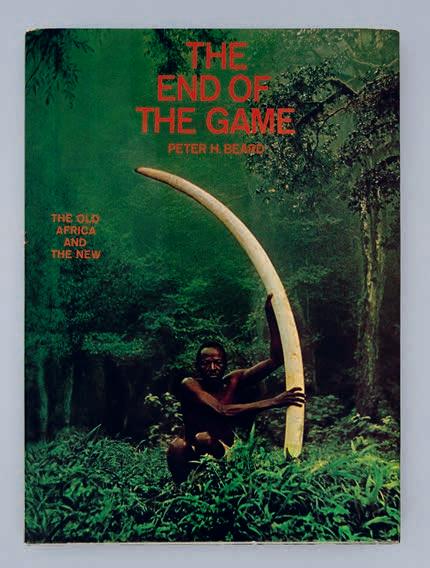
12
BEARD, Peter. The End of the Game. Text and photographs by Peter Hill Beard. New York, The Viking Press, 1965. [ref. 111535] £500
The End of the Game is Peter Beard’s first and most important book, a powerful account of the gradual and relentless destruction of East African wildlife. Widely regarded as a seminal work on conservation, it also serves as a moving tribute to the devastating impact of loss and the fragility of life. In his introduction, Beard writes: ‘A book about Africa is necessarily a book about many things, and this one hopes to be precisely that; a memory of the past, a record of the present, and an image of the future… Fifty years ago men had to be protected from the beasts; today the beasts must somehow be protected from man.’
First edition; 4to (279 x 202 mm, 11 x 8 in); black-and-white and colour photographs, drawings, and maps in offset and gravure, printed by C.J. Bucher Ltd., Lucerne; plain endpapers, grey clothcovered boards, titles stamped in gold on spine and upper side, foxing to top edge and pastedowns, pages lightly toned, photoillustrated dust-jacket printed in orange and black, foxing on verso, minor wear, near-fine; 256pp.
The Book of 101 Books pp170–1; The Open Book pp208–9; Auer Collection p448.

13 PRESENTATION COPY WITH AN ORIGINAL PHOTOGRAPH AND A DRAWING BEARD, PETER. Longing for Darkness. Kamante’s Tales from Out of Africa. With original photographs (January 1914–July 1931) and quotations from Isak Dinesen (Karen Blixen). Collected by Peter Beard. New York and London, Harcourt Brace Jovanovich, 1975. [ref. 111536] £2750
Presentation copy inscribed: ‘D [drawing of an ear] Patrick: Merry Christmas & Happy new year / (at which pt. you’ll be getting 2 more of these overdue offerings) / [drawing of gift box and a crocodile] / warm regards / Peter (Beard)’. Below this is a gelatin silver photograph of Beard with Karen Blixen mounted inside a’ Seasons Greetings’ book of matches.
Peter Beard first visited Africa at seventeen and, when returning a few years later he read Out of Africa (1937), the book Karen Blixen wrote under the pseudonym Isak Dinensen, on the boat over. Captivated by the book, he travelled to Copenhagen to visit Blixen in 1961 and again in 1962. During this second visit, Blixen gave Beard a letter of introduction to her former majordomo, Kamante Gatura, a Kenyan national of the Kikuyu tribespeople. Beard suggested that Kamante write a book about his life with Njeri wa Kahuga (the Kikuyu name given to Karen Blixen). Longing for Darkness, which takes its title from Blixen’s Shadows on the Grass (1960), features Kamante Gatura’s recollections of his time with Blixen and folk tales of his people; these were spoken into a tape recorder and were translated and transcribed by his sons, the book also includes his drawings, Karen Blixen’s archival photographs and Peter Beard’s photographs.
First edition, presentation copy with a drawing and a gelatin silver photograph mounted within a book of matches on the front free endpaper; 4to (303 x 202 mm, 12 x 8 in); black-and-white
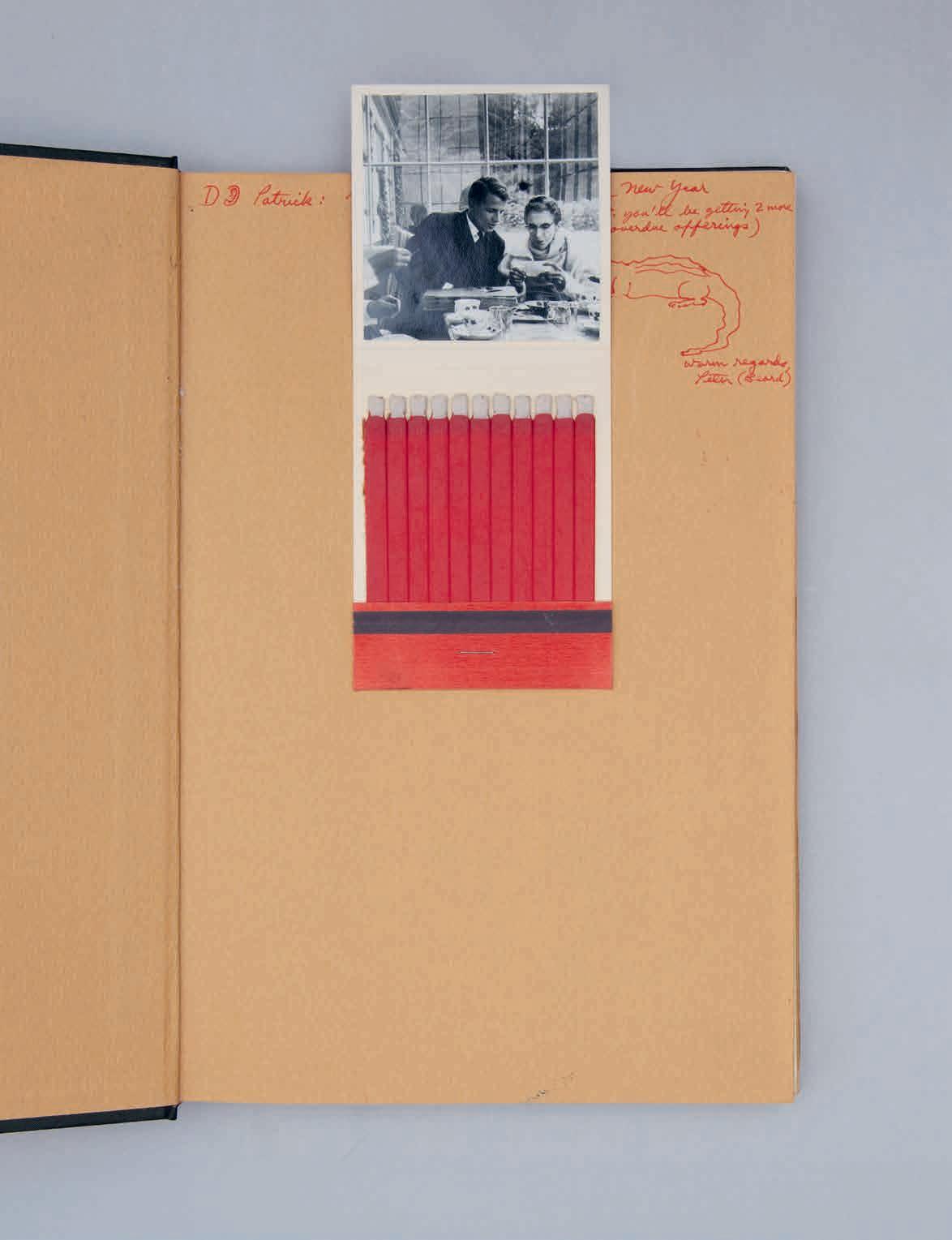
photographs by Peter Beard and Karen Blixen, facsimile pages from Kamante Gatura’s recollections with photographs and colour drawings, layout and design by Peter Beard and Marvin Israel, afterword by Jacqueline Bouvier Onassis, toning to pages; tan endpapers, photo-illustrated paper-covered boards, dark grey, light rubbing to spine-ends and tips, illustrated price-clipped dust-jacket, light fading to spine, wear along top edge with a small chip to lower panel, a very good copy; [364]pp.

14
BECHER , B[ernd] & H[illa]. Bernd & Hilla Becher. Genova, Minetti-Rebora Editori, 1973. [ref. 111223] £750
This book was issued in the ‘Flying Artbooks’ series curated by Germano Celant to coincide with an exhibition of Bernd & Hilla Becher’s photographs at Galleriaforma, Genoa, which opened on 19 April 1973, their first exhibition in Italy. It is a collaboration with Sonnabend Gallery, Paris, which showed the Becher’s work in February of the same year, having first showed them at Sonnabend, New York, in 1972.
This copy has Peter van Beveren’s ownership signature with an ink stamp dated 11. Okt 1973. Peter van Beveren established and ran the Art Information Centre (1969-1993), a non-profit organisation in Middelburg, Holland, which collected printed material related to contemporary art (see item 11).
First edition, number 53 of 1000 copies; 8vo (208 x 150 mm, 8¼ x 6 in); black-and-white photographs printed in offset, minor toning to edges; white photo-illustrated wrappers printed in black, spine toned and lightly soiled with minor wear to extremities, foot cocked, library number in black ink on spine and upper wrapper, Peter van Beveren’s ownership signature and date stamp on first page, a very good copy; [48]pp.
Provenance: Peter van Beveren / Art Information Centre (ownership signature and stamp).
Becher: Printed Matter 28
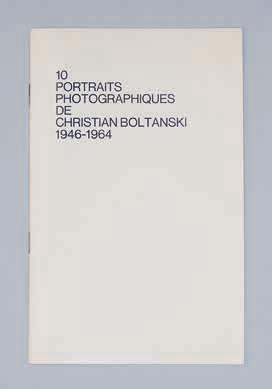
15
SIGNED
BOLTANSKI , Christian. 10 Portraits Photographiques de Christian Boltanski 1946-1964. Paris, Multiplicata, 1972. [ref. 111221] £675
Signed copy of this artists’ book, which contains a series of portraits purportedly showing Christian Boltanski aged 2, 3, 5, 7, 9, 10, 11, 14, 17, and 20. Annette Messager took these photographs one afternoon in the Parc Montsouris in Paris when Boltanski enlisted strangers and friend’s children to pose; Boltanski himself only features in the final portrait, but aged 28, not 20.
First edition, one of 500 copies, signed on verso of the front wrapper; 8vo (210 x 134 mm, 8¼ x 5¼ in); black-and-white photographs printed in offset; white printed wire-stitched wrappers, printed in black, minor toning, rubbing, and handling marks, near-fine; [24]pp (incl. covers).
Boltanski Artists’ Books pp26–7.

16
[
BOURKE-WHITE , Margaret]. Coffee Through the Camera’s Lens. A Project on Brazil. New York, Home Economics Department, American Can Company, 1936. [ref. 111664] £875
This scarce Depression-era ephemeral publication resulted from an assignment by the American Can Company, for whom Margaret Bourke-White spent two months in Brazil, photographing the coffee industry. Coffee Through the Camera’s Lens contains eleven of Bourke-White’s photographs and was distributed to American schoolchildren in an attempt, one might assume, to shape their future drinking habits. Also included are sheets with classroom assignments on the history, cultivation, and production of coffee and a card that asks: ‘Is Mother Interested in Coffee too?’ Giving the option to order a further publication titled Coffee Facts for Homemakers.
First edition; printed green card small folio (175 x 128 mm, 7 x 5 in) with a pocket holding a post-paid business reply card and sixteen loose leaves (165 × 95 mm, 6½ x 3¾ in); 11 of these cards reproduce captioned photographs by Margaret BourkeWhite printed in relief halftone, the others feature a map of Brazil, information on the coffee industry in the United States, instructions for making a 'Coffee Project Book', a 'True-False Test', and a Multiple-Choice Test’, tear to opening, light crease at head, near-fine.
First edition; 4to (275 x 240 mm, 10¾ x 9½ in); black-andwhite photographs printed in gravure, bend to top corner; printed paper-covered boards, titles to spine and upper side in red, top corners bumped, dent to fore-edges, photo-illustrated dustjacket, laminate lifting at spine, nicks fore-edge to lower panel, creasing to top corners, two short tears to upper and lower panels strengthened with tape on verso, near-fine; 14, [106]pp.
The Book of 101 Books pp160–1; The Photobook: A History I, p216.

The Photobook: A History III, p184. 17
BRANDT, Bill. Perspective of Nudes. With a Preface by Lawrence Durrell and an Introduction by Chapman Mortimer. London, The Bodley Head, 1961. [ref. 111657] £875
Bill Brandt found his first attempts at photographing the nude frustrating and sought something that would give him a less conventional image. He subsequently purchased a nineteenthcentury view camera with a wide-angle lens. ‘When I began to photograph nudes, I let myself be guided by this camera, and instead of photographing what I saw, I photographed what the camera was seeing. I interfered very little, and the lens produced anatomical images and shapes which my eyes had never observed. I felt that I understood what Orson Welles meant when he said “the camera is much more than a recording more than a recording apparatus. It is a medium via which messages reach us from another world.”

18
BRASSAÏ’S FIRST TWO BOOKS INSCRIBED TO EMIEL VAN MOERKERKEN
BRASSAÏ (pseud. HALASZ , Gyula). Paris de Nuit [with] Voluptes de Paris; [and] VAN MOERKERKEN, Emiel. Portrait of Brassaï; [and] BRASSAÏ. Paris de Nuit. Paris, 1932; 1934; 1936 but printed 1991; 1932. [ref. 111551] £9750
Presentation copies of Brassaï’s first two books, inscribed to Dutch photographer and filmmaker Emile van Moerkerken. This copy of Paris de Nuit inscribed: ‘a Van Moerkerken ces quelques nuits / Parisiennes retrouvées en amical souvenir / de Brassaï / Paris [1]937.’ Either Brassaï or Van Moerkerken has removed and discarded the text pages with Paul Morand’s introduction, and has placed black tape over Morand’s name on the cover. Brassaï was furious that Morand’s name was printed on the cover in a typeface almost twice the size as the rest of the text, suggesting that Morand was the book’s author. Contemporary reviews of Paris de Nuit pointed out that Brassaï’s photographs were far superior to Morand’s text, with Le Temps stating, ‘When the name of Paul Morand will be long forgotten, Brassaï’s photographs will still be living and precious documents.’
Voluptés de Paris is inscribed: ‘à mon cher Van Moerkerken / ces malheureux ""plasirs"" qui ont mérités / un meilleur sort / Brassaï / Paris [1]938.’ ['to my dear Van Moerkerken / these unfortunate ""pleasures"" who deserved / a better fate / Brassaï / Paris [1]938.’]. Voluptés de Paris is Brassaï's scarcest title. Disappointed after the publication of Paris de Nuit (1932) failed to bring either the extra income or new commissions that he had hoped for, Brassaï began publishing some of his more risqué photographs in magazines such as Scandale, Secrets de Paris, and Paris Magazine. The publisher of Paris Magazine was Léon Vidal, who also owned Librairie de la Lune and the Diana Slip lingerie company; for a time, he was Brassaï’s best customer. In August 1932, Vidal and Brassai signed a contract

to publish a book called 'Paris Intime', intended to be similar in format to Paris de Nuit with a text by Pierre Mac Orlan. The project drifted as the relationship between Brassai and Vidal deteriorated, and two years later, Vidal published Voluptes de Paris without any involvement on Brassaï's part. Brassaï disowned the book, as inferred in the inscription, and when many of these photographs were later included in The Secret Paris of the Thirties (1976), he claimed that this would be the first time they were published.
Copies of Voluptés de Paris exist in versions comprising either 48 or 40 pages. Although the exact reason and time this censorship or change occurred is unclear, being ring-bound, removing four leaves without disturbing the others would have been easy. This copy has the full complement of 48 pages.
‘Paris de Nuit. Paris, Édition Arts et Métiers Graphiques, [1932]’: First edition, presentation copy inscribed by Brassaï on the first page with a gelatin silver photograph by Emiel van Moerkerken mounted on the front cover, verso (107 x 77 mm, 4¼ x 3 in); 4to (248 x 192 mm, 9¾ x 7½ in); black-and-white photographs printed in gravure by Draeger, light offsetting to first page, four leaves with Morand's text removed; photo-illustrated spiral-bound card covers, titles printed in red, wear to edges, handling creases, top and bottom tabs lost, Morand's name and the editor and series information on the upper side covered in black tape; Emiel Van Moerkenen's ownership signature and bookplate on the first page; [76]pp.
‘Voluptés de Paris. Paris, Paris-Publications, [1934]’: First edition, the complete version with 46 photographs, presentation copy inscribed on rear cover, recto; 4to (271 x 209 mm, 10¾ x 8¼ in); black-and-white photographs printed in relief halftone by G. Desgrandchamps, tabs torn; printed card covers, red, title in white and black, light fading to edges, chip to top corner at head, originally bound with five plastic rings, now missing and partially tied with thread, Emiel Van Moerkenen's bookplate to verso of front cover, his ownership signature dated Paris Sep '38 to first page; [48]pp.
Portrait of Brassaï: Gelatin silver photograph (244 x 347 mm, 9½ x 13¾ in), signed and titled in pencil on verso.
‘Paris de Nuit’: First edition; 4to (248 x 192 mm, 9¾ x 7½ in); black-and-white photographs printed in gravure by Draeger, light offsetting to first page; photo-illustrated spiral-bound card covers, titles printed in red, light wear, handling creases, tear to first tab, a very good copy; [76]pp.’
Provenance: Emiel van Moerkerken (inscribed by Brassai).
[Paris de Nuit] Regards à travers Le Livre 57; Brassai: Letters to My Parents pp207–8; Fotografia Pública 100–3; The Book of 101 Books pp76–7; The Photobook: A History I, p134; The Open Book pp110–1; Auer Collection p198; Paris: Les Livres de photographies pp116–21; [Volupté de Paris] Regards à travers Le Livre 61; Auer Collection p214; Paris: Les Livres de photographies pp136–7.

19
BRASSAÏ (pseud. HALASZ , Gyula); MORAND, Paul. Paris after Dark. Paris de Nuit. 60 photos inédites de Brassai publiées dans la Collection “Réalités” sous la direction de J. Bernier. Paris, Édition Arts et Métiers Graphiques, 1933. [ref. 111537] £2500
The scarce English edition of Brassaï’s Paris de Nuit, issued shortly after the French (and from the same plates) to coincide with an exhibition held at the Batsford Gallery, London, [before June-July 1933]. For this edition, Stuart Gilbert, a pioneering James Joyce scholar, translates Morand’s text into English. Gilbert’s copy of this book is now in the Harry Ransom Center, Texas, and like ours, it has the first plate bound out of sequence, consistent with other examined copies.
Paris after Dark contains Brassaï’s nocturnal photographs of Parisian streets, bars, cafés, and clubs as the city transitioned from the Belle Époque to the modern era, from gas lighting to electricity. After studying painting in Budapest and Berlin, Brassaï settled in Paris in early 1924. He enjoyed exploring Paris at night, roaming the mostly empty streets, parks, cafes, and bars, occasionally accompanied by companions such as the writers Léon-Paul Fargue and Raymond Queneau, or his friend and fellow Hungarian émigré, André Kertész, who taught him the basic principles of photographing at night..
Brassaï was not happy with the use of red ink on the original cover, writing in a letter to his parents that the printer had promised to switch to white or silver ink after printing the first thousand copies, a change which does not appear to have been enacted.
First edition in English; 4to (248 x 192 mm, 9¾ x 7½ in); blackand-white photographs printed in gravure by Draeger; photoillustrated spiral-bound card covers, titles printed in green and red, minor wear, fine; [76]pp.
[French Edition] Regards à travers Le Livre 57; Brassai: Letters to My Parents pp207–8; Fotografia Pública 100–3; The Book of 101 Books pp76–7; The Photobook: A History I, p134; The Open Book pp110–1; Auer Collection p198; Paris: Les Livres de photographies pp116–21.

20
ONE OF 99 SIGNED CLOTHBOUND COPIES
BRAVO, Manuel Alvarez. Revelaciones. The Art of Manuel Alvarez Bravo. San Diego, Museum of Photographic Arts, 1990. [ref. 111312] £875
Revelaciones was issued to accompany a retrospective exhibition which toured the United States between 1990-92. These signed clothbound copies were probably produced for use by American Express, which sponsored the exhibition.
First edition, number 83 of 99 cloth-bound copies signed by Bravo on the first page; 4to (280 x 215 mm, 11 x 8½ in); blackand-white photographs printed in offset duotone, texts by Arthur Ollmam and Nissan N. Perez, design by Joseph Bellowes; black endpapers, grey cloth-covered boards, titles to spine in black, black-and-white photographic reproduction mounted on upper side, fine; [ii], 134pp.

21
ONE OF 100 COPIES SIGNED BY BOTH ARTISTS
BROOMBERG , Adam & CHANARIN , Oliver; BRECHT, Bertolt. War Primer 2. London, Mack, 2011. [ref. 110758] £6500
German poet and dramatist Bertold Brecht’s Kriegsfibel [War Primer] was first published in 1955. Brecht’s mistrust of the press imagery emerging from the Second World War led him to compose four-line poems, which he juxtaposed with photographs sourced from newspapers and magazines, many of which were from LIFE magazine as Brecht was living in the United States in exile from Nazi Germany. Broomberg & Chanarin, concerned with the proliferation of imagery relating to the ‘War on Terror’ that began with 9/11, have taken copies of the 1998 first English edition of Brecht’s War Primer as the starting point for this revised version. Keeping the original captions intact, they have partially overlaid the original photographs selected by Brecht with contemporary imagery from both sides of the recent conflict drawn from online sources. The URL for each image is provided with a caption in a new set of notes, screenprinted over the originals. Broomberg & Chanarin were awarded the 2013 Deutsche Börse Photography Prize for this work.
First edition, an altered artists' book, number 68 of 100 copies signed by both artists on the front free endpaper; 4to (294 x 243 mm, 11½ x 9½ in); 85 black-and-white photographs printed in offset, each with a new photographic reproduction partially pasted over it by hand, the final image with a screen printed red square, new notes screen printed in red over the original text section; plain endpapers, grey cloth-covered boards, original titles stamped on spine in silver, new titles screen printed in red on upper side, starting at head, near-fine; [176], xxivpp.
The Photobook: A History III, p285.

22
PRESENTATION COPY
BURDEKIN , Harold; MORRISON , John. London Night. London, Collins, 1934. [ref. 111725] £475
Presentation copy of this collaboration between Harold Burdekin and John Morrison, who assisted him in making the photographs. In his introduction, Morrison writes, ‘Night, M. Paul Morand has remarked with Gallic shrewdness, is not the
negative of day,’ a reference to Brassaï’s Paris de Nuit (see items 18 & 19), which influenced several similar publications, including the present work and Bill Brandt’s A Night in London (1938).
First edition, presentation copy signed by John Morrison on the title-page and inscribed opposite; 4to (312 x 245 mm, 12¼ x 9¾ in); black-and-white photographs by Harold Budekin assisted by John Morrison printed in photogravure by Vandyck Printers, Bristol and London, introduction by John Morrison; photoillustrated endpapers, blue cloth-covered boards, titles stamped in silver on spine and to with a starry night design on upper side, light shelwear, illustrated blue/grey dust-jacket printed in blue, minor wear to extremities, nick and crease to bottom edge of upper panel, upper flapfold, and to top edge of lower panel, light toning to spine, publisher’s note offering signed prints of these photographs laid in, an excellent copy; [112]pp.
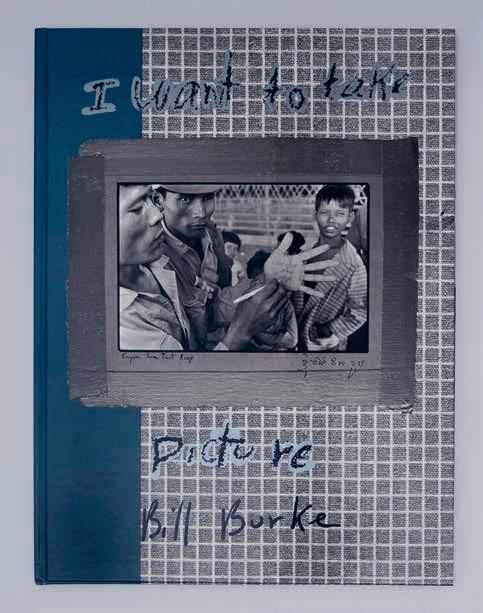
23
SIGNED
BURKE , Bill. I Want to Take Picture. Atlanta, Nexus Press, 1987. [ref. 111695] £875
Bill Burke studied Far Eastern art and religion at university while the United States was engaged in the Vietnam War. In the early 1980s, he travelled through Southeast Asia, particularly Thailand and Burma, where he photographed refugees fleeing there from Pol Pot’s brutal regime in Cambodia. He subsequently entered Cambodia and took photographs of people there, including members of the Khmer Rouge. Burke used a Leica and a large-format Polaroid camera, reminiscent of the cameras that 19th-century colonial photographers had used, and the layout incorporates photographs of pieces ephemera from his travels such as beer bottle labels, bottle caps, cards from massage
parlours, and journal pages. In The Book of 101 Books, David Levi Strauss writes that ‘The triumph of this book is that it manages to reflect the mad experience of travelling in Southeast Asia while still reflecting on what it all means.’
First edition, signed within an outline of Burke’s hand on verso of the front free endpaper; folio (380 x 285 mm, 15 x 11¼ in); blackand-white photographs and colour reproductions of ephemeral items, printed in offset; endpapers illustrated with a montage of press cuttings, photo-illustrated glazed paper-covered boards, fine; [60]pp.
The Book of 101 Books pp.258–9; The Open Book pp334–5; The Photobook: A History I, pp40–1.
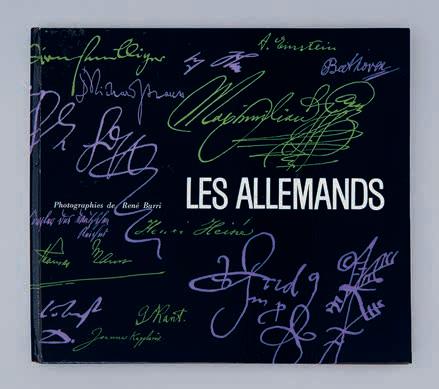
24 SIGNED
BURRI , René. Les Allemands. Photographies de René Burri. Paris, Encyclopédie Essentielle, Robert Delpire Éditeur, 1963. [ref. 111538] £400
René Burri’s first book was published by Fretz & Wasmuth Verlag in Zurich as Die Deutschen and by Robert Delpire in Paris as Les Allemands. Imago printed both editions, but Die Deutschen was delivered earlier and bore a publishing date of 1962. Robert Delpire published this edition as part of his Encyclopédie essentielle series, which included Robert Frank’s 1958 book Les Américains (see item 39). Burri’s book mirrors his fellow Swiss in concept and format, with an extended photo essay accompanied by extracted texts by various authors.
First edition, signed opposite the title-page; oblong 8vo (185 x 210 mm, 7¼ x 8¼ in); black-and-white photographs printed in gravure by Imago, Zurich, texts by various authors selected by Jean Baudrillard; plain endpapers, illustrated laminated papercovered boards printed in black, purple, and green, laminate lifting at joints, corners rubbed, near-fine; [ii], 166pp.
The Photobook: A History I, p218; Swiss Photobooks pp244–51, pp668–9.

25
ONE OF 200 WITH AN ORIGINAL PHOTOGRAPH
CALLAHAN , Harry. Water’s Edge. With an introductory poem by A.R. Ammons and an afterword by Harry Callahan. Connecticut, Callaway Editions distributed by the Viking Press, 1980. [ref. 111744] £2000
Callahan informally began his series of beach photographs in 1938 at Lake Hutton, where his wife’s family had a cottage. But it wasn’t until 1946, when he started teaching at the Chicago Institute of Design (The New Bauhaus), that he felt he had taken his first good pictures of the subject, taking photographs on the shore of Lake Michigan, just three blocks from his house. The series took shape when Callahan moved to New England to teach at Rhode Island School of Design, Providence, in 1961. In his afterword, he writes: ‘I think that nearly every artist continually wants to reach the edge of nothingness — the point where you can’t go any farther. I feel I have come close to that at various times with the Beach Series photographs. A determined single-mindedness and an insistent inner need has led me to that point. That is why I have always kept going back, and that is what still keeps me going today – keeps me alive?’
First edition, number 30 of 50 signed copies in set II (of IV), each with a different gelatin silver photograph in an edition of 50 (200 copies in total with an additional 16 hors commerce); folio (340 x 278 mm, 13½ x 11 in); black-and-white photographs printed in duotone offset; cream endpapers, natural linen-covered boards; original gelatin silver photograph (150 x 150 mm, 5 x 5 in) mounted on to rag paper, signed and numbered in pencil in the mount, print laid in to the publisher’s grey paper portfolio with title to front in blind, housed together in the publisher’s quarter vellum over linen drop spine box with titles stamped in blind on spine, fine; [76]pp.
The Photobook: A History II, p33.

26
WITH THE SCARCE DUST-JACKET
COBURN , Alvin Langdon. Men of Mark. London & New York, Duckworth & Co and Mitchell Kennerley, 1913. [ref. 111050] £3750
Alvin Langdon Coburn began gathering these portraits in 1904 when, shortly before sailing to London, he asked Perrirton Maxwell, editor of the Metropolitan Magazine of New York, for a list of authors and artists to photograph during his visit. Coburn’s first sitter was George Bernard Shaw, who was particularly helpful in making introductions to potential subjects on Coburn’s behalf, and the two became friends. Other sitters include Frank Brangwyn, H. G. Wells, Auguste Rodin, Henry James, Arthur Symons, Theodore Roosevelt, W. B Yeats, Mark Twain, Clarence H. White, Roger Fry, and Henri Matisse. The portraits are reproduced chronologically, the photogravures printed under Coburn’s supervision on his own press. The day, month, and year for each sitter are included in the index, with Coburn insisting that these facts added a ‘very considerable interest to a portrait considered as a “human document.”
First edition; 4to (304 x 238 mm, 12 x 9¼ in); 33 tippedin photogravures from plates prepared by Coburn, with the subject's facsimile signatures in the margins, light spotting and cockling to top edge, guards toned, occasional light wear, one with a short tear; endpapers browned, linen-backed grey cloth, titles to the front in gilt; printed dust-jacket, toned, spine slightly darkened, rubbing to lower panel, edges chipped, a near-fine copy in a very good example of the scarce dust-jacket; 29, [1], [66]pp.
The Truthful Lens 37; Imagining Paradise p23.


DELUXE LIMITED ISSUE WITH A SIGNED ORIGINAL PHOTOGRAPH
CUNNINGHAM , Imogen. Imogen! Imogen Cunningham Photographs 1910-1973. Introduction by Margery Mann. Seattle & London, University of Washington Press for the Henry Art Gallery, 1974. [ref. 110910] £1500
Deluxe signed issue with a signed original photograph ‘False Hellebore, 1926’. Imogen Cunningham’s first monograph, a comprehensive, chronological survey of her diverse career, was published to mark her ninety-first birthday and coincide with two exhibitions: ‘Imogen! Imogen Cunningham Photographs 1910-1973’ and ‘Images of Imogen, 1903-1973’, both at the Henry Art Gallery, University of Washington, Seattle.
Imogen Cunningham’s career in photography spanned 70 years. In 1910, she established a studio in Seattle before moving to San Francisco in 1917, where she met a circle of like-minded photographers and became a founding member of Group f/64, an informal group including Ansel Adams, Sonya Noskowiak, and Edward Weston, who challenged the prevalent pictorialist aesthetic. Close to half of the members were women, making Group f/64 one of the first modern art movements equally run by women.
‘That it took almost seventy years for a monograph to be published on Cunningham’s ground-breaking career is reflective of the uphill battle that began to be undertaken in the 1970s, when several early-20th-century female photographers finally began to be more permanently written into photographic history’ (What They Saw: Historical Photobooks by Women).
First edition, number 78 of 150 signed copies with a gelatin silver photograph (sheet: 253 x 200 mm, 10 x 7 ¾ in; image: 172 x 153 mm, 6¾ x 6 in) signed in ink in the lower margin, with a printed title label on the verso, handling crease to top edge, impression lines to corners from mount, tape hinges to verso, in the publisher’s black card mount; black-and-white photographs printed in offset; original quarter black morocco over black clothcovered boards, titles stamped to spine in silver, publisher’s black cloth-covered board slipcase, rubbed and a little dust-soiled; [ii], 110, [2]pp.
What They Saw: Historical Photobooks by Women p194.
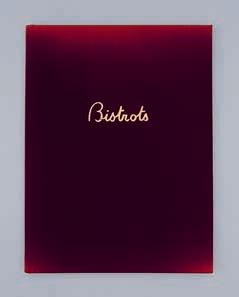
DELUXE ISSUE SIGNED BY ALL THREE CONTRIBUTORS
DOISNEAU, Robert; PRÉVERT, Jacques; GIRAUD, Robert. Bistrots. Souillac & Mulhouse, Le Point, 1960. [ref. 110775] £1250
Deluxe issue of 200 copies signed by Robert Doisneau, Jacques Prévert, and Robert Giraud, this copy printed for ‘Monsieur Love’. The ordinary edition was published as number 57 of the quarterly artistic and literary journal Le Point, this issue focusing on French bistros.
First edition, number 23 of 200 copies on Velin d’Arches, signed by Robert Doisneau, Jacques Prévert, and Robert Giraud on the colophon; 8vo (254 x 191 mm, 10 x 7½ in); black-and-white photographs by Doisneau printed in gravure, texts by Prévert and Giraud; plain endpapers, burgundy silk-covered boards, spine and upper side stamped in gold, light fading toward edges, publisher’s acetate dust-jacket, toned and lightly scuffed, near-fine; [iv], 48, [4]pp.
Eyes on Paris pp298–301.

29
DOMELA-NIEUWENHUIS , César. Ausstellung Fotomontage im Lichthof des ehemaligen Kunstgewerbemuseums, Prinz Albrechtstr. 7. 25. April bis 31. Mai 1931. Staatliche Museen
Staatliche Kunstbibliothek. Berlin, Staatliche Museen, Staatliche Kunstbibliothek, 1931. [ref. 111375] £5000
The scarce catalogue for the pivotal exhibition Fotomontage at Staatliche Kunstbibliothek, Berlin (25 April – 31 May 1931), organised by César Domela, who also designed this catalogue and the poster. This was the first exhibition dedicated to photomontage, featuring Domela’s own work, as well as examples by El Lissitsky, Aleksandr Rodchenko, Gustav Klutsis, Kurt Schwitters, John Heartfield, Raoul Hausmann, Hannah Höch, Herbert Bayer, Oskar Nerlinger, Jan Tschichold (see items 74, 75 & 93), László Moholy-Nagy, Friedrich VordembergeGildewart, Paul Schuitema, and Piet Zwart.
César Domela-Nieuwenhuis was a Dutch painter, sculptor, typographer, and designer, and an important member of De Stijl. In 1923 he relocated to Berlin and established a graphic design studio specialising in photomontage. In 1929 he joined the Ring neue Werbegestalter, a society founded by Kurt Schwitters dedicated to promoting modern graphic design. In 1933 Domela fled Germany, emigrating to Paris, where he established a screenprinting studio.
First edition; 8vo (208 x 145 mm, 8¼ x 5¾ in); black-andwhite photomontages printed in relief halftone, preface by Kurt Glaser, texts by César Domela and Gustav Klutsis; white photoillustrated wire-stitched wrappers printed in black and grey, light wear, shallow crease to lower corner, adhesive along spine, short split to head and foot, in a custom chemise and slipcase by Alain Devauchelle, a very good copy; [26]pp.
Fotografía Pública 154.
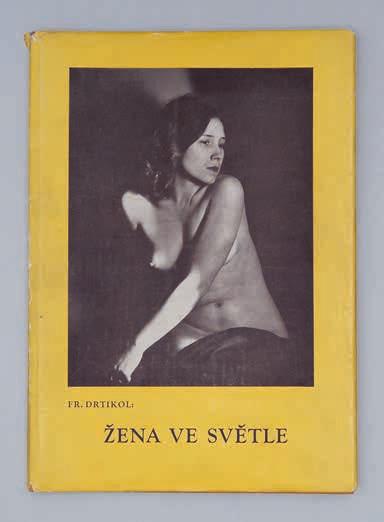
DRTIKOL , Fr[antisek]. Zena ve Svetle. Vyber 46 Aktu [Women in Light. 46 Selected Nudes]. Úvod napsal J. R. Marek. Praha, Nakladatelství E. Beaufort A. S., 1938. [ref. 111552] £4500
Frantisek Drtikol is one of the founders of modern Czech photography. Before the First World War, he was a renowned portrait photographer; after the war, he concentrated on
nude studies, a selection of which were published in Zena ve Svetle. In the 1920s, he developed the style for which he is best known, using elements of expressionist dance in his posing and incorporating geometric plywood sets and props lit with a single arc lamp and photographed from dynamic angles. In 1935, at the height of his international fame, Drtikol sold his studio and gave his photographs and documents to the Museum of Arts and Crafts in Prague in order to concentrate on painting, meditation, and Eastern philosophy, having long maintained an interest in Theosophy, Buddhism and Anthroposophy.
First edition; 8vo (244 x 166 mm, 9½ x 6½ in); 49 black-andwhite photographs printed in relief halftone on warm cream paper, small abrasion to one page; textured tan endpapers, corner of rear free endpaper turned, orange cloth-covered boards, cream title-label printed in brown and mounted on upper side, photo-illustrated dust-jacket, printed in yellow and black, lightly marked, small abrasion on the lower panel, rubbing along spine folds, small tears and tiny chips to head and foot of spine, a near-fine copy in the scarce dust-jacket; [xvi], 46, [2]pp.
The Open Book pp94–6; The Book of 101 Books p64 (incorrectly giving 1930 as the date of publication); The Photobook: A History I, p79 (incorrect date); Auer Collection p268; Czech and Slovak Photo Publications 75

31
ELSKEN , Ed van der. Sweet Life. New York, Harry N. Abrams, 1966. [ref. 111656] £575
Sweet Life takes its title from the name of a steamboat photographed in the Philippines. Van der Elsken photographed this sprawling odyssey between 1959 and 1960 while travelling with his wife Gerda through Africa, Asia and America. He funded the trip by soliciting two magazine commissions to work along the route and with a stipend from Dutch Television. It is partly devoted to documenting the struggle for independence of the first African nations, done with a certain degree of optimism. Van der Elsken intended for the photograph used on the cover, which shows a man repairing a machine, to symbolise regained autonomy, and in his captions, van der Elsken was critical of the apartheid regime in South Africa and racial segregation in the United States.

First American edition (published simultaneously in Dutch, German, German book club, and Spanish editions, and two years later in French and Japanese editions); 4to (292 x 295 mm, 11½ x 11½ in); black-and-white photographs printed in gravure, light toning to edges and to first image page from text leaves as usual; endpapers illustrated with images from contact sheets, black cloth-covered boards, spine and upper side stamped in white, shelfwear to bottom edge, photo-illustrated dust-jacket, abrasion to head of spine, nick to upper panel top edge, minor rubbing and toning to lower panel, near-fine; [28], 179, [1]pp.
The Photobook A History I, pp254–5; The Dutch Photobook pp120–1; Errata Editions Books on Books no. 13
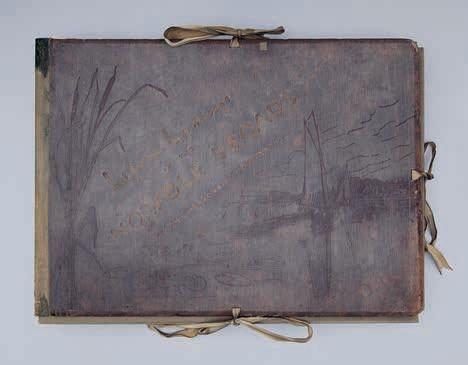
32
AN ‘EPOCH MAKING’ PHOTOGRAPHIC ALBUM
EMERSON , Peter Henry; GOODALL , Thomas Frederick. Life and Landscape on the Norfolk Broads. Illustrated with Forty Beautiful Plates from Nature Executed in Platinotype [The Plates are Absolutely Permanent]. With General and Descriptive Text. London, Sampson Low, Marston, Searle, and Rivington, 1886. [ref. 102980] £87,500
Of the utmost rarity – Emerson’s first publication comprising 40 platinum prints.Peter Henry Emerson is a crucial figure in the evolution of fine art photography, from its roots in the nineteenth century to its modernist manifestation in the early twentieth century. In Life and Landscape on the Norfolk Broads, his first and most important book, Emerson, accompanied by his friend, the artist Thomas Goodall, sought to document the disappearing traditions of rural working life. They capture scenes of reed harvesters, marshmen, and eel catchers, balancing scientific and artistic developments in photography, social reportage, and natural history. The photographs, twenty-seven by Emerson and Goodall and thirteen by Emerson alone, are accompanied by a text describing aspects of life in and around the inland waterways of the Norfolk Broads.
‘The subtle prints and insightful handling of the subjects combine to make this the most important of Emerson’s illustrated books. The text gives sociological dimension to photographs that are cornerstones of British photographic estheticism’ (Truthful Lens).
According to Robert S. Kahan and J.B. Colson in their bibliography, a deluxe edition of 100 copies with a vellum
cover decorated in black and gold and 750 ordinary copies in green cloth were initially advertised, but only twenty-five of the deluxe edition and 175 copies of the ordinary edition were issued.
First edition; oblong folio (300 x 420 mm, 11¾ x 16½ in); frontispiece and 39 platinum prints made by Valentine & Son, Dundee, mounted on card, printed guard sheets, accompanied by descriptive letterpress, disbound for display, repairs to title-page and text leaves, some foxing, lacking half-title, prints are in fresh condition; modern cloth portfolio incorporating the original clothcovered boards with a pictorial image and title in gilt on upper side; 3-81, [1]pp.
Peter Henry Emerson: An Annotated Bibliography p77; The Truthful Lens 50; The Photobook: A History I, pp70-1; Imagining Paradise pp186–8.

33
EVANS , Walker; BEALS , Carleton. The Crime of Cuba. With 31 aquatone illustrations from photographs by Walker Evans. Philadelphia & London, J.B. Lippincott Company, 1933. [ref. 111540] £750
These photographs represent the only period Walker Evans spent working as a photographer outside the United States. Carleton Beals wrote The Crime of Cuba out of anger for the political situation in Cuba and disapproval of the way America managed its relations with Latin American countries. He originally wanted his book to be illustrated with news photographs of demonstrations and violence on the streets of Cuba. Literary agent Ernestine Evans (no relation) suggested to Lippincott’s art department that instead, they send Walker Evans to Havana, and they agreed.
Few of Evans’s photographs could be said to show the oppression or poverty Beals writes about; Evans later claimed not to have read the book, apparently treating the project as an
entirely commercial venture. However, he himself selected and sequenced the final thirty-one photographs, inserting a few pictures from news agencies to supplement the photography section, a signal of Evans’s growing interest in anonymous imagery; he was a regular visitor, with Ben Shahn, to the New York Public Library’s picture collection.
First edition; 8vo (218 x 145 mm, 8½ x 5¾ in); black-and-white photographs printed in aquatone, red topstain; red endpapers, black cloth-covered boards, spine and upper board stamped in silver, head bumped, photo-illustrated price-clipped dust-jacket, silver and black, light wear to extremities, lightly soiled, nicked with small chips and light creasing to head and edges, Gas Company leaflet laid in, near-fine in a very good dust-jacket; [ii], 441, [1], [64]pp.
Regards à travers Le Livre 57; Auer Collection p205.
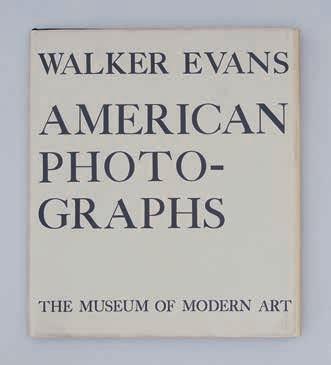
34
EVANS , Walker. American Photographs. With an Essay by Lincoln Kirstein. New York, The Museum of Modern Art, 1938. [ref. 111717] £2750
In 1938, the Museum of Modern Art staged an exhibition of Evans’ photographs, the first exhibition at the museum to be devoted to the work of a single photographer. Evans worked closely with Lincoln Kirstein on the edit and sequence of the photographs, both for the exhibition and in the accompanying book American Photographs, for which Kirstein also provided the essay. Kirstein writes, ‘In Evans’s pictures of temples or shelters the presence or absence of the people who created them is the most important thing… The structures are social rather than artistic monuments. The photographs are social documents!’
Evans and Kirstein divided the book into two thoughtfully sequenced sections. The first shows American citizens, or their representations, alone, in groups, and often within the context of their built environments. The second shows these environments and comprises the ‘streets and storefronts, homes and graveyards, industrial plants and roadside stands [that] are frozen in time, many of them in a permanent state of decay.’
First edition; 4to (222 x 199 mm, 8¾ x 7¾ in); black-andwhite photographs printed in relief halftone by The Spiral Press, New York from plates made by Beck Engraving Company; cream endpapers, black cloth-covered boards, border in blind, printed
title-label mounted on spine, minor scratch, printed dust-jacket, grey with text in black, minor toning and small chip to spine, light marking to edges, errata slip tipped on to copyright page, without the band, fine in a near-fine dust-jacket; [ii], 198, [8]pp.
Regards à travers Le Livre 69; The Book of 101 Books pp98–9; The Open Book pp128–9; The Photobook: A History I, pp114–5

35
EVANS, Walker; AGEE , James. Let Us Now Praise Famous Men. Three Tenant Families. Boston, Houghton Mifflin Company, The Riverside Press Cambridge, 1941. [ref. 111553] £2500
Let Us Now Praise Famous Men chronicles the lives of three sharecropper families in Alabama during the Depression. Its origins lie in a 1936 assignment for Fortune magazine, which James Agee only accepted on the condition that Walker Evans accompanied him as the photographer. Evans was granted leave without pay from his role with the Resettlement Administration (precursor of the Farm Security Administration, see items 42 & 43) for July and August of that year, with the understanding that while Fortune would have first refusal on this set of photographs, they would ultimately, as was the case with all work Evans undertook for the Resettlement Administration, belong to the United States government.
Fortune ultimately decided not to run the story and released it to Agee and Evans. In the spring of 1938, they reached an agreement with Harper and Brothers to expand the same material into book form. But, after a year and a half of discussions, Agee’s refusal to change the text resulted in the withdrawal of the publishing offer. The project languished until Houghton Mifflin of Boston stepped in on the condition that certain Agee remove certain words that were illegal in Massachusetts. A suite of Evans’s direct, unadorned photographs precede Agee’s inventive stream-of-consciousness prose. The book was well received, but sales were poor; only around 600 copies were sold in a year and it was remaindered. In the Winter 1942 issue of the Kenyon Review, Lionel Trilling described Let Us Now Praise famous Men as being ‘the most important moral effort of our American generation.’
First edition, 8vo (205 x 138 mm, 8 x 5½ in); black-and-white photographs printed in relief halftone, toning to edges, occasional minor marks; plain endpapers, light toning from flaps, black
cloth-covered boards, titles stamped on spine in silver, toning to spine and edges, rubbing to bottom edges, pulling to head of spine, photo-illustrated dust-jacket, wear to edges with tiny chips, short tear to upper panel, short tear and crease to rear, toned and lightly marked, spine faded, a very good copy; [32], [ii], xvi, 471, [3]pp.
Photographers of the FSA III-A1; Regards à travers Le Livre 78; The Book of 101 Books pp108-9; Auer Collection p293; The Photobook: A History I, p144.

36
EVANS , Walker. The Mangrove Coast. The Story of the West Coast of Florida by Karl A. Bickel. Photographs by Walker Evans. New York, Coward-McCann, Inc., 1942. [ref. 111541]
£450
As with The Crime of Cuba (see item 33), this book originated with literary agent Ernestine Evans, who had wanted to engage Walker Evans in another project. Karl Bickel, a retired journalist, was writing a history of the Gulf Coast of Florida, and Ernestine unequivocally recommended Walker, who needed the money; his 1940 Guggenheim Fellowship was running out, and sales of Let Us Now Praise Famous Men (see item 35) had been disappointing. He had also recently married and saw the six-week Florida trip as an opportunity to combine work with his honeymoon. These photographs are probably the least-known of Walker Evans’s pre-1945 photographs; the few existing prints are mostly held at the Getty Museum, and the publishers removed Evans’s photographs from this book’s second and subsequent editions.
First edition; 8vo (212 x 141 mm, 8¼ x 5½ in); black-and-white photographs in relief halftone, design by Robert Josephy, orange topstain; plain endpapers, minor browning, grey-green clothcovered boards, photo-illustrated title-label printed in orange and black mounted on front, similar label without the illustration mounted on spine, light spotting, spine lightly toned through the jacket, photo-illustrated dust-jacket printed in red and black, lightly toned and rubbed, minor fading to spine, light wear to edges, light foxing and small adhesive strip on verso, corner of two flaps turned, a very good copy; viii, 312, 32pp.
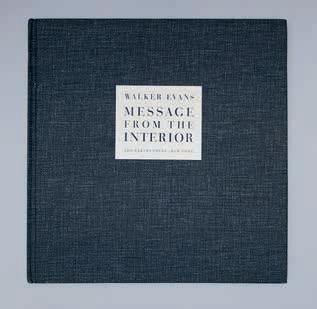
37
EVANS , Walker. Message from the Interior. New York, The Eakins Press, 1966. [ref. 111723] £625
These twelve photographs of domestic interiors are richly suggestive of the lives of those who live or lived in them. In the afterword, John Szarkowski describes Evans’ style as seeming ‘as inevitable and as anonymous as that of the early daguerreotypists, yet the character of his imagery – frontal, concisely plain, remotely passionate – is unchallengeably his own.’
First edition; square folio (360 x 355 mm, 14¼ x 14 in); blackand-white photographs printed in gravure by Photogravure and Color Company, Moonachie, New Jersey with glassine leaves, afterword by John Szarkowski; tan endleaves, grey mottled cloth-covered boards, printed title label mounted on front, titles stamped in white on spine, fine; [32]pp.
Regards à travers Le Livre 137; The Open Book pp220–1.

38
SIGNED
FORD, Charles Henri. Spare Parts. New York, A New View Book (printed by Vassily Papachrysanthou in Athens, Greece), 1966. [ref. 111102] £1500
Spare Parts is the first published edition of Charles Henri Ford’s paste-up poster poems (graphi-poems, or Fordographs), with boards designed by Stan Brakhage. In a contemporary advertisement for this book, Allen Ginsberg describes ‘diction

so common it’s cut out of mass print, then shuffled on the table and recomposed according to Ford’s private significances. Spare Parts is genitals. Awareness of the implicit bias and camp of marketplace yatter emerges after decades of unconscious commerce. What’s further odd is the surreal charm of the phrasal juxtapositions; eccentric orthography of multitudinous type-fonts accentuates the charm: Ford is a practiced old connoisseur of XX Century ready-made speech. Everything from rosejoint to King Lear’s unforgettable cry.’
Ford occupies an interesting position in twentieth-century American art and literary circles. He was a poet, artist, and filmmaker who, with Parker Tyler, edited and published View (1942-1947), the influential art and literary magazine. Ford befriended Andy Warhol in the early 1960s, and the two started attending film screenings together, with Ford introducing Warhol to Jack Smith and other underground filmmakers (see items 98 & 106).
First edition of 850 numbered copies and 100 hors de commerce copies numbered I – C, this copy designated an ‘artists’ copy and signed by Charles Henri Ford in pencil on colophon; 4to (343 x 245 mm, 13½ x 9¾ in); collages, photographs, and paste-up poems printed as lithographs on various coloured paper stock; illustrated endpapers, illustrated paper-covered boards designed by Stan Brakhage, wear along edges, illustrated dust-jacket, light wear to outer corners, nick to top edge of lower panel, a near-fine copy; [160]pp.

39
‘A SAD POEM FOR SICK PEOPLE’
FRANK , Robert. Les Américains. Photographies de Robert Frank. Paris, Encyclopédie Essentielle, Robert Delpire Éditeur, 1958. [ref. 111542] £3750
An uncommonly fine copy of the first published edition of Robert Frank’s The Americans, a book that altered the course of twentieth-century photography and held a mirror to the American people. In his successful application for a Guggenheim grant, Frank wrote:
‘The project I have in mind is one that will shape itself as it proceeds… The material is there; the practice will be in the photographer’s hand, the vision in his mind.’ Between April 1955 and June 1956, he set out on a series of trips across America. He aimed to complete a body of work that would be ’a broad, voluminous picture record of things American, past and present... A visual study of a civilisation.’
Les Américains follows a careful and complex sequence, with four chapters, each exploring a different aspect of American culture and introduced by a photograph of the American flag. In this, the first edition, the photographs are accompanied by a series of texts by various writers selected by Alain Bosquet.
First edition; oblong 8vo (185 x 210 mm, 7¼ x 8¼ in); blackand-white photographs printed in gravure by Draeger Frères, Montrouge, texts by various authors selected by Alain Bosquet; plain endpapers, laminated white paper-covered boards illustrated with an illustration by Saul Steinberg printed in light blue, black, and red, spine leaning, head and foot of spine tapped, fine; 172, [2]pp.
Regards à travers Le Livre 120; The Open Book pp172–3; The Photobook: A History I, p247; Auer Collection p375; Swiss Photobooks pp218–227, pp666–7.

40
FRANK , Robert. The Lines of My Hand. Tokyo, Yugensha / Kazuhiko Motomura, 1972. [ref. 111194] £3000
This is Robert Frank’s photographic autobiography, dedicated to his two children, Pablo and Andrea, ‘who are trying to find a better way to live.’ The photographs represent every stage of his work to the time of publishing, presented chronologically and selected less for their historic or aesthetic significance than their personal meaning. The Lines of My Hand is the first of three books Frank made with Motomura Kazuhiko, a collector of photographs and photography books and occasional publisher, each designed by Sugiura Kohei who was responsible for several of the most striking Japanese photobooks of the 1960s and ’70s. It was issued in two variants, each with a black-and-white photographic reproduction on the slipcase, the present copy with ‘Platte River, Tennessee’. On page 75, a photograph of a postcard sent to Frank by Jack Kerouac references this photograph as used on the cover. Kerouac writes: ‘Dear Robert – That photo you sent me of a guy looking over his cow on the
Platte River is to me a photo of a man recognizing his own mind’s essence, no matter what — Jean ton copain’..
Specks of dust falling on the plates during printing led to occasional tiny white marks on some pages. The publisher, Motomura Kazuhiko, would only sell copies once he had examined them and spotted out any marks by hand. After Motomura passed away in 2014, a number of unsold copies with white spots on the pages were made available for sale. The copy offered here was purchased before Motomura passed away and had, therefore, been spotted and approved by him (see items 41 & 77).
First edition; folio (341 x 253 mm, 13½ x 10 in); black-and-white photographs printed in offset, design by Sugiura Kohei and Tsuji Syuhei, layout by Sugiura and Ralph Gibson, occasional light dust speckle marks spotted out by hand by Motomura; black rough cloth-covered boards, titles stamped in white to spine and upper side, 32pp text booklet laid in as issued, publisher’s black clothcovered board slipcase, titles to spine in white, photographic reproduction mounted on upper side, minor wear, original shipping carton with title stencilled to spine, a fine copy; [v], 119pp (incl. 2 folding).
The Photobook: A History I, p261; The Open Book pp286–7; Auer Collection p544; Swiss Photobooks pp304–13, pp675–6.
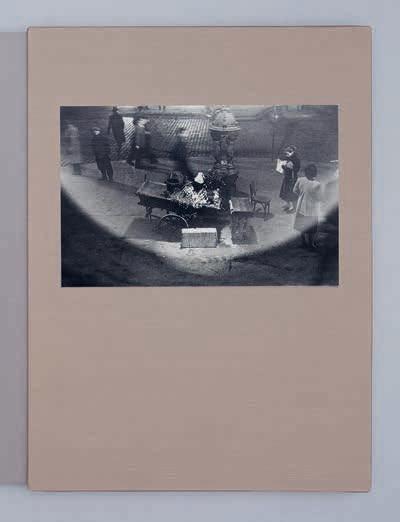
41
FRANK , Robert. Flower Is. Tokyo, Yugensha / Kazuhiko Motomura, 1987. [ref. 111195] £4500
Flower Is contains three bodies of work: photographs taken in Paris of flowers, flower sellers, and chance encounters on the street, the River Rouge car factory in Detroit, and polaroids made in Mabou Mines, Nova Scotia. It is the second of three books Frank made with Motomura Kazuhiko, a collector of photographs and photography books and occasional publisher, each designed by Sugiura Kohei.
‘By 1949 I had lived in New York City for two years. When
I returned to Paris, I was 26. The beauty of that city touched me... Returning to America I began to look at Americans... and began to photograph the city and factory which produced the American car. The summer of 1955 was hot and after two days at the River Rouge Plant in Detroit I was told to leave the factory. I travelled south and was astonished to see black people treated as inferiors. I experienced the suspicion against anything not “American”. I was learning about American determination to win... Flowers of Paris is memory... After the publication of The Americans in 1959, a slow fade begins. Filmmaking replaces the single frame photograph!’
First edition; folio (342 x 251 mm, 13½ x 10 in); black-and-white photographs printed in offset, design by Sugiura Kohei and Sato Atsushi, occasional light dust speckle marks spotted out by hand by Motomura; grey silk-covered boards, titles stamped in dark grey on spine and upper side, publisher’s grey paper-covered board slipcase with titles stamped in dark grey on spine, original shipping carton, fine; [112]pp.
The Photobook: A History I, p264; Auer Collection p670.

42
[FSA] ANDERSON , Sherwood; ROSSKAM Edwin (editor).
Home Town. Photographs by Farm Security Photographers. The Face of America [series]. New York, Alliance Book Corporation, 1940. [ref. 111677] £375
Home Town comprises photographs taken for the Farm Security Administration (FSA) by Arthur Rothstein, Russell Lee, Walker Evans, Ben Shahn, Edwin Rosskam, John Vachon, Dorothea Lange, Marion Post, Carl Mydans, selected by FSA editor Edwin Rosskam, paired with a series of essays by Sherwood Anderson reflecting on life in small American towns. It was published shortly before Anderson departed for Latin America on assignment for Reader’s Digest, where he was also travelling as an unofficial goodwill ambassador for the U.S. State Department as the threat of war intensified for the United States.
Edwin Rosskam began working for Roy Stryker as a visual aid specialist in 1938, designing layouts for the Farm Security
Administration and making photographs for Stryker’s Standard Oil project. The following year, he made another book using FSA photographs, 12 Million Black Voices (see item 43) with Richard Wright.
First edition; 8vo (255 x 174 mm, 10 x 6¾ in); black-and-white photographs by FSA photographers printed in gravure, note about the photographs by Edwin Rosskam, production crease to one leaf; cream endpapers with light toning at gutter, light blue cloth-covered boards, titles stamped in green on spine and upper side, lightly faded with spotting along joints, photo-illustrated yellow dust-jacket, printed in green and black, light wear to extremities, tiny chips to head and foot of spine, short tear to bottom edge upper panel and upper spinefold, shallow crease to spine, small bookselller’s label to front free endpaper, near-fine; [iv], 145, [3]pp.
Photographers of the FSA P2.

43
[FSA] WRIGHT, Richard; ROSSKAM , Edwin. 12 Million Black Voices. A Folk History of the Negro in the United States. Text by Richard Wright. Photo-Direction by Edwin Rosskam. New York, The Viking Press, 1941. [ref. 111716] £1500
Richard Wright was asked to write a book on the plight of African Americans living in poverty during the Great Depression following the Great Migration. 12 Million Black Voices is divided into four sections: ‘Our Strange Birth,’ ‘Inheritors of Slavery,’ ‘Death on the City Pavements,’ and ‘Men in the Making’’ with Wright’s text accompanied by Farm Security Administration (FSA) photographs selected by Edwin Rosskam (see item 42), many of which were not published elsewhere. The contributing photographers are Rosskam himself, Dorothea Lange, Jack Delano, Carl Mydans, Arthur Rothstein, Russell Lee, Ben Shahn, Marion Post, John Vachon, with additional press photographs of a lynching in Georgia, the Harlem riots in New York, the Ford Riots in Dearborn,
Michigan, and a demonstration in Washington D.C. The cover features Walker Evans’ photograph ‘Flood Refugees, Alabama’ on both sides.
First edition; 8vo (254 x 174 mm, 10 x 6¾ in); black-and-white photographs printed in gravure, black topstain, occasional light foxing; plain endpapers with toning to pastedowns and gutter, natural linen-covered boards, titles stamped to spine in red, lightly toned, photo-illustrated dust-jacket, printed in black and red, light toning at fore-edge, minor wear to edges with a short tear to top edge of upper panel, short tear and crease at lower flapfold, bookplate of Robert E. Reid on front pastedown, a superior copy; 152pp.
Photographers of the FSA P23; Auer Collection p291.

44
ONE OF 78 WITH AN ORIGINAL PHOTOGRAPH
GALJAARD, David. Concresco. N.p., self-published, 2012. [ref. 111492]
£975
In Concresco, David Galjaard explores the social and symbolic significance of the numerous concrete bunkers built in Albania during the rule of dictator Ever Hoxha and the role they now play in the modern landscape. Hoxha, who was in power from 1944 to 1985, had approximately 750,000 bunkers constructed between 1967 and 1985 on the pretext of Albania needing to prepare for a possible attack from overseas, though ultimately, no actual conflict occurred. Concresco was awarded the Paris Photo—Aperture Foundation First PhotoBook Award, 2012.
First edition, number 13 of 26 copies with an original photograph (there was a choice of three prints, each in an edition of 26) from a total edition of 750, signed on the front flap; 4to (341 x 213 mm, 13½ x 8½ in); colour photographs printed in offset, text in English by Slavenka Drakulic and Jaap Scholten, design by Katie McGonigal; red card wrappers with flaps, upper side embossed and with titles in black, colour photograph (245 x 304 mm, 9¾ x 12 in) signed, numbered, and stamped on verso, publisher’s brown card folding case printed in black, closed with thread and rivet fastenings. fine; [136]pp with [36]pp of smaller leaves bound in.
The Photobook: A History III, p210.

45
GHIRRI , Luigi. Kodachrome. Modena, Punto e Virgola, 1978. [ref. 111311] £1000
Kodachrome is a pioneering work of colour photography. In the foreword, Ghirri writes, ‘The meaning I try to give to my work is that of the verification of how it is still possible to wish to face the way of knowledge, to make it possible at last to tell the real identity of man, of thigs, of life, from the image of man, of things, of life... but above all as a search for identity in a reality which is often tragically absurd in its cruel and brutalizing pretences and surrogates, which appear in the present, but which do not forget the past... An examination of the world and its conventional representation, the limits of reality and imagination.’
First edition; 4to (271 × 210 mm, 10¾ x 8¼ in); colour photographs printed in offset, introduction by Piero Berengo Gardin and foreword by Luigi Ghirri, both in Italian and English, design by Paola Borgonzoni and Luigi Ghirri, minor toning to first illustrated page consistent with other copies we have seen; illustrated white wrappers, text in black, colour photograph and illustration, light toning, minor wear to extremities, shallow handling crease to rear corner, near-fine; 103, [1]pp.
The Photobook: A History I, p231; Auer Collection p613.
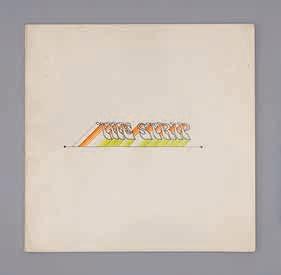
46
GIBSON , Ralph. The Strip. A graphic portrait of Sunset Boulevard / Fall, 1966. Photographed by Ralph Gibson. Designed by Roger Kennedy. Los Angeles, Roger Kennedy Graphics, 1966. [ref. 111543] £500
Ralph Gibson’s first book features photographs of the clubs, restaurants, shops, and people on Sunset Boulevard, Los Angeles, in the autumn of 1966.
First edition; 4to (232 x 232 mm, 9¼ x 9¼ in); black-and-white photographs printed in relief duotone; illustrated white wrappers, printed in orange, green, and black, lightly toned and marked, very good; [ii], 48, [2]pp.

47
INSCRIBED TO PETER ORLOVSKY
GINSBERG , Allen. Photographs. Altedena, California, Twelvetrees Press, 1990. [ref. 111658] £5000
Presentation copy inscribed by Ginsberg to his long-time partner Peter Orlovsky with a large, accomplished drawing over two pages: ‘E. 12 St / New York June 30, 1991 / For Beloved / Peter Orlovsky / whose form reappears decade after decade / on these phantom pages / Tyger! Tyger! Tyger! / 437 E12 / Apt 23 / Allen Ginsberg / 4:30 AM.’
First edition, presentation copy inscribed to Peter Orlovsky with a large drawing; 4to (355 x 280 mm, 14 x 11 in); black-andwhite photographs printed in gravure by Toppan, Tokyo; black endpapers, grey cloth-covered boards, titles stamped in blind to spine and sides, slightly cocked, printed dust-jacket, black, light wear to edges, lightly marked, publisher’s printed vertical wraparound band, black, an excellent copy; [120]pp.
Provenance: Peter Orlovsky (author’s presentation inscription).
The Book of 101 Books p266–7.
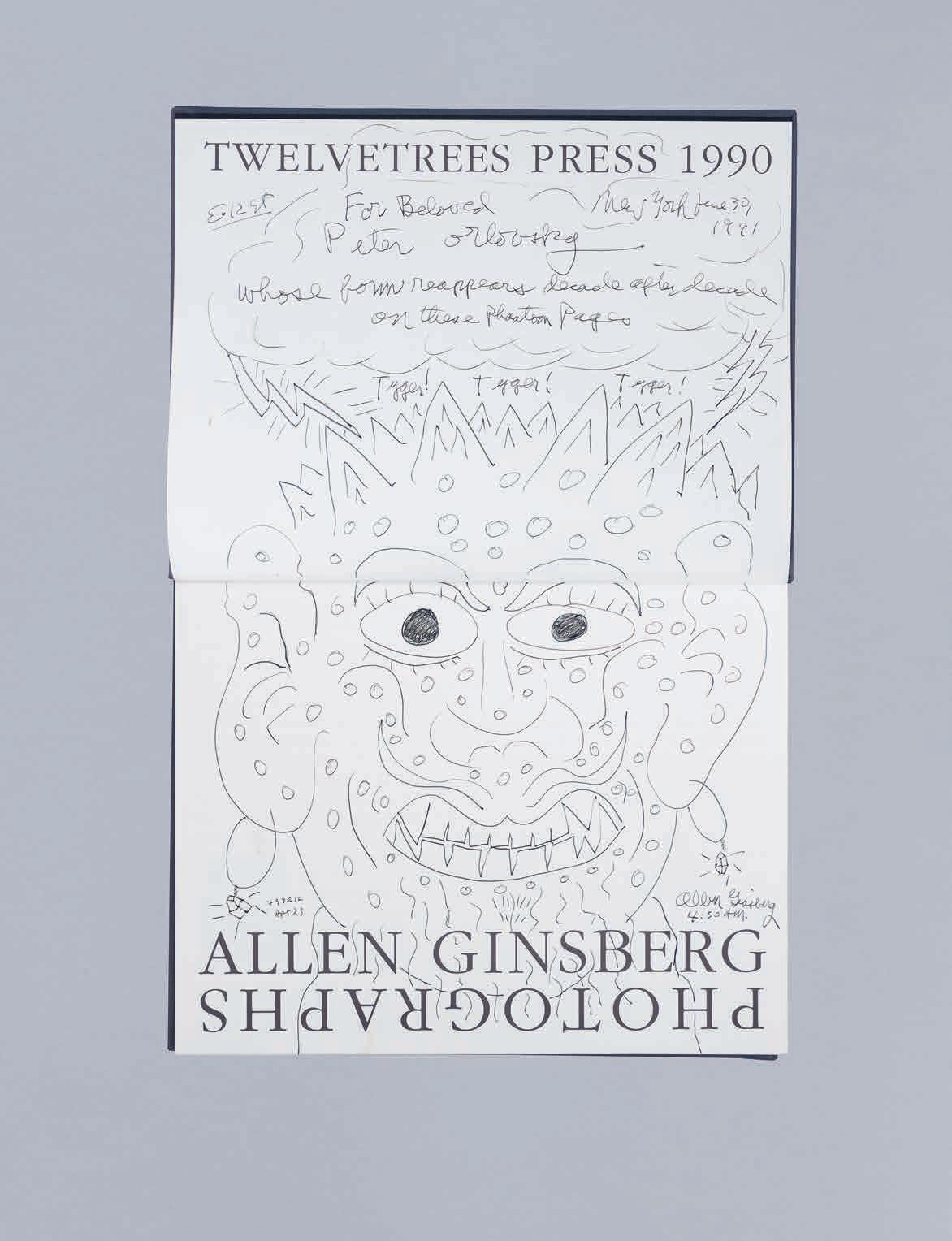
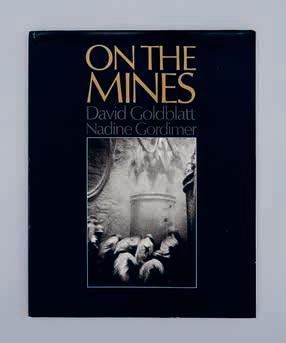
48
GOLDBLATT, David; GORDIMER , Nadine. On the Mines. Cape Town, C. Struik (PTY) Ltd., 1973. [ref. 111707] £675
David Goldblatt made a broad and objective body of work documenting life in South Africa for over fifty years. On the Mines is his first book; these photographs examine the goldmining industry in Witwatersrand; he grew up in the West Rand mining town of Randfontein. It includes photographs of architectural details and interiors, miners sinking a shaft and finally, portraits of men working in the mining industry.
First edition; 4to (292 x 228 mm, 11½ x 9 in); black-and-white photographs printed in offset; cream endpapers with light offsetting, grey cloth-covered boards, titles stamped to spine in gold, photo-illustrated dust-jacket, printed in black, gold, and grey, minor wear to extremities, fine; [136]pp. Auer Collection p569.
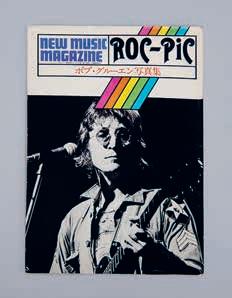
49 INSCRIBED TO HILARY GERRARD WITH BOB GRUEN’S PHOTOGRAPHIC BUSINESS
CARD
GRUEN , Bob. Roc-Pic. New Music Magazine April 1975 [special issue] Bob Gruen Photo Collection. Tokyo, New Music Magazine Co., Ltd., 1975. [ref. 111114] £500
Presentation copy inscribed to Hilary Gerrard, Ringo Starr’s manager for over thirty years and a director of the Beatles company Apple Corps.: ‘for Hilary / with my thanks / Bob Gruen’, with Gruen’s gelatin silver photographic business card laid in. This special issue of New Music Magazine is dedicated to Bob Gruen’s photography. His subjects include John Lennon and
Yoko Ono, The Rolling Stones, David Bowie, Bob Dylan, New York Dolls, Sly Stone, Ike and Tina Turner, and Elton John.
Provenance: Hilary Gerrard (author’s inscription).
Special issue, presentation copy inscribed by Bob Gruen in blue ink on title-page, with his gelatin silver photographic business card (55 x 76 mm, 2¼ x 3 in) laid in with notes in ink on verso; 4to (297 x 207 mm, 11¾ x 8¼ in); black-and-white photographs printed in offset; wire-stitched photo-illustrated wrappers, minor wear to edges, photo-illustrated dust-jacket, light wear to extremities, lightly stained, handling crease to spine, near-fine in a very good dust-jacket; 61, [11]pp.

50 WITH A SIGNED EXHIBITION ANNOUNCEMENT CARD
HAMILTON , Richard. Man, Machine & Motion. [Newcastle Upon Tyne]: Kings College Printing Section, 1955. [ref: 111891] £5000
The scarce catalogue for Man, Machine & Motion, an exhibition conceived, designed, and organised by Richard Hamilton at the Hatton Gallery, University of Durham, Newcastle upon Tyne, where he taught between 1953 and 1966 before travelling to the Institute of Contemporary Arts (ICA), London in July of the same year. With a signed exhibition announcement card for the ICA exhibition.
Hamilton collected photographs and reproductions of drawings showing vehicles and equipment that ‘extend the powers of the human body, enabling aquatic, terrestrial, aerial and interplanetary movement’—sourcing the images from various magazines and books. Hamilton then selected 223 images from this collection and divided them into four sections: land, sea, air, and space. These images spanned 200 or so years of human history, with prominence given to photographs contemporary to the advent of mechanical transport.
First edition; 8vo (229 x 148 mm, 9 x 5¾ in); black-and-white photographs and illustrations, introduction by Richard Hamilton and Lawrence Gowing, catalogue notes by Rainer Banham, design by Anthony Froshuag, shallow indentation to several leaves; grey illustrated wire-stitched wrappers printed in black, minor toning, oxidation to staples, small chip to bottom corner of upper, shallow crease to top corner of lower wrapper, an excellent copy; [56]pp. [With:] Folding exhibition announcement card signed by Hamilton in pencil.



51
[HAMILTON , Richard]. FAULKNER , Derek. Polarvoid Portraits. Edited by Derek Faulkner Vol. 1 No. 1. For Dick Rivers after Richard Hamilton. N.p., ca. 1977. [ref. 111158] £500
Artists’ book, likely unique; a play on Richard Hamilton’s series of polaroid portraits. Here a series of polaroid photographs are reproduced with a title opposite each: Richard Hamilton, Dieter Rot, Andy Warhol, Jasper Johns, Larry Rivers, Robin Crozier, Robert Morris, Robert Rauschenberg, self portrait, Dick Rivers, Robert Filliou. Dick Rivers is a pseudonym used by Faulkner in his work; it was also the name chosen by French singer Hervé Forneri, adapted from the character Deke Rivers played by Elvis Presley in his 1957 film Loving You. Ulises Carrión’s assembling magazine Ephemera #2 (Amsterdam, Other Books & So, December 1977), a monthly journal of mail and ephemeral works, reproduces a series of images with the title ‘“Dick Rivers, Private Investigator”, Derek Faulkner, Newcastle.’

Artists’ book, likely unique, signed on the first page with the note ‘prototype only’; 11 gelatin silver photographs (123 x 85 mm, 4¾ x 3¼ in) mounted on card; comb-bound, lightly toned and marked with light wear; [26]pp. 52
INSCRIBED TO HILARY GERRARD HEATH , Dave. A Dialogue with Solitude. Culpeper, A Community Press Publication distributed by Horizon Press, New York, 1965. [ref. 111117] £1250
Presentation copy inscribed to Hilary Gerrard, Ringo Starr’s manager for over thirty years and a director of the Beatles
company Apple Corps.: ‘To Hilary – / with warm regards, in appreciation / of your regard for my work – / Dave Heath’.
Dave Heath’s reputation largely rests on this book, in which he reflects and responds to the alienation that was particularly prevalent in post-war North American society. It was published in 1965, but most of the photographs were taken earlier, including several that he made in Korea in 1953 while serving in the US Army. Heath briefly studied at the Art Institute of Chicago and was strongly influenced by W. Eugene Smith (see item 99), dedicating A Dialogue with Solitude to him.
First edition, presentation copy inscribed in black ink on titlepage; 4to (280 x 210 mm, 11 8¼ in); black-and-white photographs printed in offset, foreword by Huw Edwards, several literary quotes, preface and design by Dave Heath, minor toning to edges; tan cloth-covered boards, titles stamped to spine in brown, photo-illustrated dust-jacket, white, text in black, light rubbing and toning, light wear to extremities, near-fine in an excellent dustjacket; [100]pp.
Provenance: Hilary Gerrard (author’s inscription).
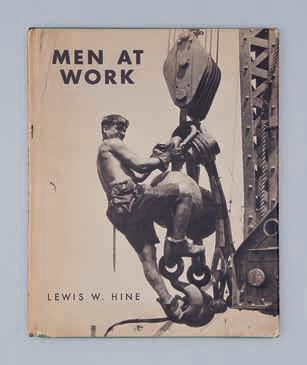
53
INSCRIBED TO OWEN R. LOVEJOY
HINE , Lewis W[ickes]. Men at Work. Photographic Studies of Modern Men and Machines. New York, The Macmillan Company, 1932. [ref. 111371] £15,000
An important presentation copy in a remarkable example of the rare dust-jacket, inscribed: ’To Owen R. Lovejoy / for his never-failing appreciation / of our work, – many of the results / being the direct outgrowth of his / suggestions and optimistic criticism. / May his vision never grow dim.’ Owen R. Lovejoy was a vehement opposer of child labour. He served as the general secretary of the National Child Labor Committee from 1907 to 1926, where Lewis Hine was a staff photographer and art director of their magazine Charities and Commons (later The Survey) between 1908 and 1917.
Men at Work contains photographs made between 1920 and 1931, issued amid the worst employment crisis the United States had ever known. Hine saw it as a way of reaching out to schoolchildren, providing them with constructive role models and emphasising the human element of industry, with photographs of railroad employees, coal miners, aeroplane assemblers, steelworkers, and others. Among the most striking
photographs are Hine’s images of the construction of the Empire State Building, which Empire State, Incorporated, had used widely for publicity purposes..
Hine always insisted on exerting control over the layout of his photographs, regularly requesting to see magazine proofs before publication. It is probably for this reason that he was not selected to work for the Farm Security Administration (see items 42 & 43) during the 1930s, with Roy Stryker, head of the Historical Division of the FSA, expressing concern that Hine may be difficult to employ and that it would be impossible to make the type of arrangements that he would have found satisfactory. Men at Work is the only book of Hine’s photographs published in his lifetime.
First edition, presentation copy inscribed on the front free endpaper; 4to (253 x 203 mm, 10 x 8 in); black-and-white photographs printed in gravure; minor foxing to endpapers, green cloth-covered boards, titles to upper side in black, mottling to boards along fore-edge, photo-illustrated dust-jacket, minor wear to edges, minor foxing to verso, price-clipped for presentation, a near-fine copy in a remarkable example of the rare dust-jacket; [48]pp.
Provenance: Owen R. Lovejoy (inscribed)
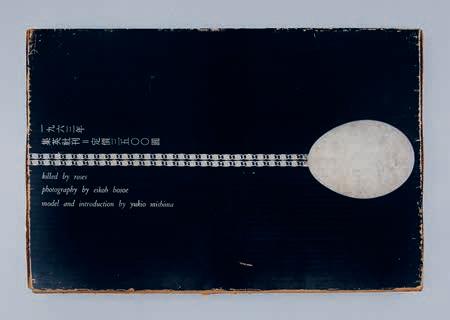
The Photobook: A History I, p126; The Open Book pp108–9; Auer Collection p187. 54
bookseller’s ticket to front free endpaper; illustrated clothcovered boards, original plastic dust-jacket, shrunken slightly as usual, a near-fine copy in the publisher’s very good illustrated cardboard box with rubbing and wear to extremities; [102]pp (incl. two folding, limitation leaf, and four printed rice paper leaves).
The Open Book pp194–5; The Photobook A History I, pp 280–1; The Book of 101 Books pp164–7; The Japanese Photobook pp368–9.

55
INSCRIBED BY HUGNET TO EMIEL VAN MOERKERKEN
HUGNET, Georges; DUCHAMP, Marcel (cover). La Septième face du dé. Poëmes – Découpages. Couverture de Marcel Duchamp. Paris, Éditions Jeanne Bucher, 1936. [ref. 111554] £17,500
Barakei is Hosoe Eikoh’s masterpiece, a collaboration with the novelist Mishima Yukio. Mishima saw and was impressed by Hosoe Eikoh’s photographs of the Butoh dancer Hijkata Tatsumi and subsequently asked Hosoe to take a publicity portrait for him. The two men were pleased with the results, and for several months, from Autumn 1961 until Summer 1962, they worked together on the photographs that would form Barakei. These images display a provocative blend of Eastern and Western influences, featuring Mishima in a series of provocative poses exploring themes of birth, death, sex, entrapment, and isolation, with references to the martyrdom of Saint Sebastian.
First edition, number 1392 of 1500 copies, signed by Hosoe and Mishima in black ink on limitation; Folio (420 x 270 mm, 16½ x 10¾ in); preface by Mishima, black-and-white photographs by Hosoe printed in sheet-fed gravure, design by Sugiura Kohei,
Presentation copy of one of the most beautiful Surrealist books, inscribed: ‘à E. van Moerkerken / en hommage sympathetique de / Georges Hugnet / Amsterdam 1938’. This copy was most likely inscribed at or around the Exposition Internationale du Surréalisme organised by Hugnet, Paul Eluard, André Breton, Roland Penrose, E. L. T. Messens, and Kristians Tonny at Galerie Robert, Amsterdam, in Spring 1938. Whilst Surrealism never became a large or cohesive movement in the Netherlands, it did inspire artists, including Emiel van Moerkerken (see item 18), a Dutch photographer and filmmaker who was deeply impressed by this exhibition and became one of the most prominent exponents of Surrealism in the Netherlands, contributing poems and photographs to the journal De Schone Zakdoek (1941-44).
La Septième face du dé is Georges Hugnet’s first volume of ‘poémes-dé-coupages’ comprising twenty of his Surrealist poem-collages featuring images and typographic elements cut from risqué magazines, including Paris Magazine, Paris Sex Appeal and Allô Paris. Marcel Duchamp’s cover features a photograph of his 1921 readymade sculpture ‘Why Not Sneeze, Rrose Sélavy?’ with the title composed of letters featuring the names of literary or historical figures of importance to the Surrealist movement, including Sade, Freud, Rimbaud, Paracelsus, Swift, Heraclitus, Roussel, Chaplin, Jarry, Uccello, and Saint-Just.
First edition, inscribed by Georges Hugnet to Emiel van Moerkerken in red ink on the half-title, with van Moerkerken’s ownership signature in pencil on the first page and his ex libris
SIGNED BY HOSOE AND MISHIMA HOSOE , Eikoh. Barakei / Killed by Roses. Tokyo, Shueisha, 1963. [ref. 110943] £3500
on the half-title, number 230 of 250 copies on vélin, from a total edition of 270 with 24 hors commerce; 4to (289 x 212 mm, 11½ x 8 in); 20 collages in colours printed in collotype by Duval accompanying 20 poems printed in black and green printed by Grou-Radenez; card upper and lower covers, upper cover designed by Marcel Duchamp, printed in green with a mounted photograph of ‘Why Not Sneeze Rose Sélavy’ reproduced on card with part of the image embossed, five-hole stab-bound with green thread, “douanes exposition paris” stamp to verso of front cover, light wear to edges, light toning, an excellent copy in a custom drop spine box; [90]pp.
Provenance: Emil van Moerkeren (inscription to half-title)
The Complete Work of Marcel Duchamp 444; Fotografía Pública 241–250; The Book of 101 Books pp92–3; Paris: Les Livre de photographie pp192–5.

56
ISHIMOTO, Yasuhiro. Aru hi Aru tokoro. Someday, Somewhere. Tokyo, Geibi Shuppansha, 1958. [ref. 111693] £2500
Ishimoto participated in the first and third The Eyes of Ten exhibitions in May 1957 and July 1959. In between, he published this, his first book and the first significant work to emerge from the group. Ishimoto occupies an interesting position in the history of Japanese photography and was another important link between the East and West. Born in San Francisco in 1921, he moved to Japan at age three with his family. After graduating high school, he returned to San Francisco to study. A year later, as a result of the war, he was sent to an internment camp in Colorado for Japanese citizens and those of Japanese descent. It was here that his interest in photography began. After the war, Ishimoto went to Chicago and studied at the Institute of Design under Harry Callahan and Aaron Siskind. He graduated in 1952 and returned to Japan the following year, although he continued to travel between the two countries. Someday, Somewhere contains photographs from Chicago and Tokyo, clearly showing the influence of his time studying with Callahan and Siskind (see items 25 & 97).
First edition; 4to (279 x 224 mm, 11 x 8¾ in); colour and blackand-white photographs printed in relief halftone, black-and-white photographs printed in gravure, texts by Watanabe Tsutomu and Ishimoto Yasuhiro in Japanese and English, design by Yamashiro
Ryoichi, imprint printed in black on yellow paper with Ishimoto’s chop in red ink tipped on to final leaf as issued, occasional minor offsetting; yellow endpapers, navy cloth-covered boards, yellow cloth spine with titles stamped in black, minor wear to corners, colour photo-illustrated dust-jacket printed in black, light wear and creasing to edges, short tear to top edge and chip to bottom edge of rear panel, two pieces of publisher’s ephemera laid in, near-fine in an excellent dust-jacket; [168]pp (two of which are folding).
The Photobook: A History I, pp272–3; Japanese Photobooks of the 1960s and ’70s pp40–5; The Japanese Photobook 184.

57
PRESENTATION COPY
ISHIUCHI , Miyako. Yokosuka Story. Tokyo, Shashin Tsushinsha, 1979. [ref. 111054] £2500
Presentation copy, inscribed: ‘To Mr. Ikeda Shinichi / Ishiuchi Miyako / 1981.5.16 / 2nd Yokosuka 1:2’. ‘Ishiuchi Miyako grew up in Yokosuka, near the US Navy base, and left for Tokyo at nineteen... For her debut series, Yokosuka Story, Ishiuchi documented her hometown in an unsentimental but not impersonal style, combining observation and bittersweet memory.’
Ishiuchi Miyako is one of Japan’s leading photographers. She grew up in Yokosuka, the port town near one of the largest US Naval bases in the Pacific during the 1950s and ’60s, and left for Tokyo at age nineteen. For this, her debut series, she returned some nine years after leaving and photographed her hometown, lured by ‘Yokosuka Story,’ a popular song by Momoe Yamaguchi, to revisit memories from her childhood. Yokosuka was transformed in the post-war period into one of the largest American naval bases in the Pacific. This military occupation led to a proliferation of American culture in Yokosuka, and Ishiuchi’s photographs hint at the tension between local and foreign interests.
First edition, presentation copy inscribed on the halftitle; oblong 4to (235 x 288 mm, 9¼ x 11¼ in); black-and-white photographs printed in offset, text by Araki Nobuyoshi in Japanese, and by Ken Bloom and Ishiuchi Miyako in Japanese and English, light foxing to preliminary and end pages, light toning to edges; photo-illustrated wrappers, without the printed wraparound band, near-fine; [120]pp.
The Photobook A History I, p304; For a New World to Come 77; What They Saw: Photobooks by Women pp250–1.
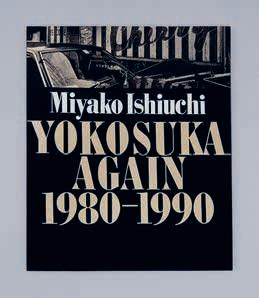
58
SIGNED
ISHIUCHI , Miyako. Yokosuka Again 1980-1990. Tokyo, Sokyu-Sha & Mole, 1998. [ref. 111055]
£300
Signed copy of Ishiuchi Miyako’s Yokosuka Again 1980-1990. In 1977, Ishiuchi photographed Yokosuka, the port town in Japan where she grew up during the 1950s and ’60s, returning some nine years after leaving to revisit memories from her childhood. This work was published as Yokosuka Story (1979), which hinted at the tensions arising from the United States Naval base, which came to dominate the town. The photographs in Yokosuka Again were made after the publication of Yokosuka Story and are focused more directly on the area around the Naval base, which, while hinted at, was not featured in the earlier book.
First edition, signed; 4to (278 x 230 mm, 11 x 9 in); black-andwhite photographs printed in offset; photo-illustrated wrappers, fine in the publisher’s near-fine cardboard slipcase with a printed label, indentation marks on the rear; [104]pp.

59
INSCRIBED TO JAMES BALDWIN
JARING , Cor. Amsterdam. Huizen, nvTritonpers, 1969. [ref. 111110]
£750
Presentation copy of Cor Jaring’s book of photographs showing the various subcultures, protests, and happenings in Amsterdam during the 1960s, inscribed: ‘For James Baldwin, with great respect / Cor, Paris 1969’.
In 1948, James Baldwin, aged 24, left New York and moved to Paris. In the spring of 1984, during an interview for The Paris Review, Baldwin was asked why he had chosen to live in France, to which he replied: ‘It wasn’t so much a matter of choosing France – it was a matter of getting out of America.’ Disillusioned with the prejudices he faced, Baldwin feared that he would not have survived should he have stayed and certainly could not sufficiently isolate himself to focus on writing. In New York, the eldest of nine children, he worked several jobs to provide for his family. Baldwin spent nine years living in Paris, returning to the United States in 1957 as the Civil Rights Movement gained momentum. He returned to France in 1970, first to Paris, then settling in Saint-Paul-de-Vence.
First edition, inscribed to James Baldwin; 4to (279 x 210 mm, 11 x 8¼ in); black-and-white photographs printed in offset, text in Dutch, German, French, and English, light toning to edges; photo-illustrated paper-covered boards, light wear to extremities, laminate lifting at joints, publisher’s printed orange wraparound band, a very good copy; 126, [2]pp.
Provenance: James Baldwin (author’s inscription)

60
KAWADA , Kikuji. The Map / Chizu. Tokyo, Bijutsu ShuppanSha, 1965. [ref. 111372]
£15,000
Kikuji Kawada’s The Map is a high point of Japanese photography and book design, published on August 6 1965, the twentieth anniversary of the bombing of Hiroshima. It comprises photographs of the ruined dome of Hiroshima’s Prefectural Industry Exhibition Hall, now preserved as a peace memorial known as the Atomic Bomb Dome, and the abstract surfaces of its stained, scorched walls juxtaposed with pictures showing the aftermath of the bomb including melted glass, fused metal, graffiti, and symbols of Western occupying forces such as Coca-Cola bottles, and with photographs of military memorabilia from the museum at Etajima dedicated to the kamikaze pilots of the Special Attack Corps. The folded brown insert features a text in Japanese and English by novelist Kenzaburo Oe, who also cites a sonnet by W.H. Auden, ‘Here war is simple like a monument...’
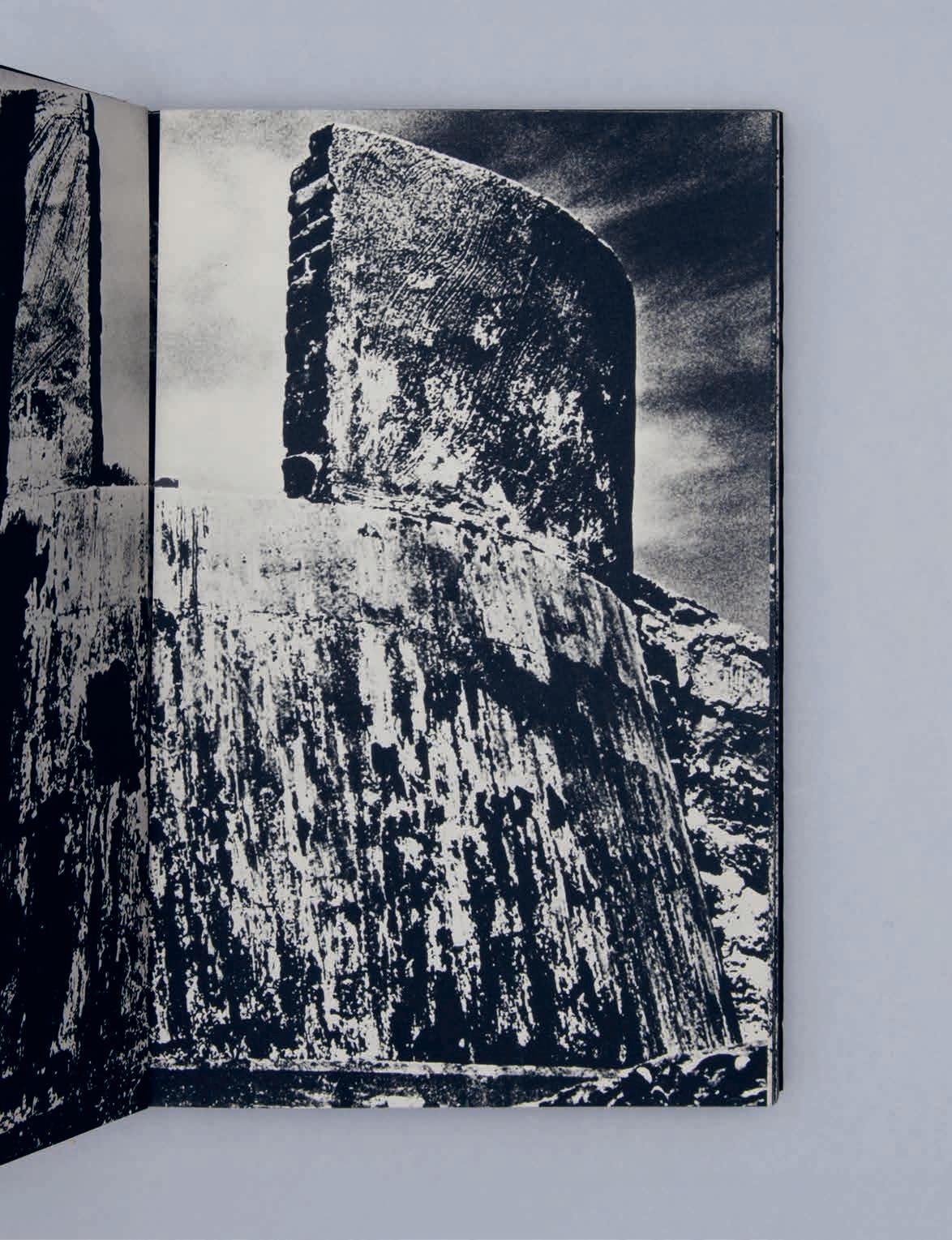
First edition; 4to (225 x 150 mm, 8¾ x 6 in); black-andwhite photographs printed in gravure by Seikosha, text by Oe Kenzaburo, design by Sugiura Kohei and Ishio Toshiro; black endpapers, black paper-covered boards, printed black and grey spine label, photo-illustrated dust-jacket, minor wear to extremities, illustrated card portfolio, publisher's printed cardboard slipcase, spine lightly toned, minor wear, tri-fold tan printed text sheet, recto printed in Japanese verso in English laid in, previous owner's name on front free endpaper dated 66/1/10, near-fine; [98]pp (including 45 gatefolds).
The Book of 101 Books pp174–7; The Photobook: A History I, pp286–7; Auer Collection p445; The Open Book pp212–3; Japanese Photobooks of the 1960s and ’70s pp86–93; The Japanese Photobook 282.

61 SIGNED REVIEW COPY
KERTÉSZ , André. Day of Paris. Photographs of Paris by Andre Kertesz. George Davis, editor. New York, J.J. Augustin Publisher, 1945. [ref. 111544] £2500
An advance review copy, signed by André Kértesz, who came to Paris from Budapest in 1925 and lived there until 1936 when he left for New York to work with the Keystone Agency. A dispute with the nephew of Keystone’s founder, Bert Garai, led to Kertész abandoning his contract, and the subsequent lack of money and the outbreak of the Second World War made his return to Paris impossible. Kértesz’s photographs are arranged loosely in three chapters: morning, afternoon, and night, with a dust-jacket design by Alexey Brodovitch, who’d given him work at Harper’s Bazaar. Day of Paris is an undoubtedly nostalgic look at life in pre-war Paris by one of the most influential photographers working there in the twenties and thirties. First edition, an advance review copy, signed by Kertesz in a later hand on the title-page; 8vo (241 x 180 mm, 9½ x 7 in); black-and-white photographs printed in relief halftone; plain endpapers, toned, olive cloth-covered boards, titles stamped in black on spine and upper side, lightly toned, white photoillustrated dust-jacket designed by Alexey Brodovitch, printed in black, light wear to extremities, light creasing to head of spine, abrasion to lower panel, publisher’s review slip laid in, a close to near-fine copy; [iv], 148pp.
Regards à travers Le Livre 81; The Book of 101 Books pp114-5; The Photobook: A History I, p200; The Open Book pp138-9; Auer Collection p306; Paris: Les Livre de photographie p260.
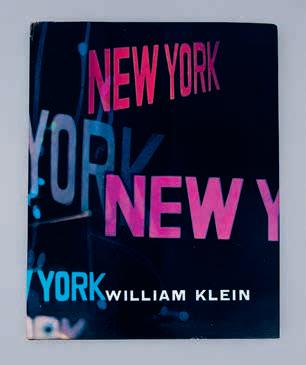
62
CHANCE WITNESS REVEALS
KLEIN , William. Life is Good & Good for You in New York Trance Witness Revels. Paris, Éditions du Seuil, Album Petite Planète 1, 1956. [ref. 111373] £4500
Life is Good & Good For You in New York changed the parameters of what a book of photographs could be, representing William Klein’s attempt to capture the kinetic quality of 1950s New York. After serving in the army towards the end of the Second World War, Klein moved to Paris in 1949 on the G.I. Bill and spent six years living there after studying painting, including a brief time with Fernand Léger. In 1954, Alexander Lieberman invited him back to New York to join the Vogue art department as a design assistant. Klein returned to New York. He didn’t take the role with Vogue but spent eight months taking photographs while rediscovering New York. Rejecting traditional ideas of sharpness, brightness, and composition, Klein experimented with the layout using the Vogue darkrooms and Photostat, which allowed him to try many ideas, such as cutting, pasting, and playing with scale and sequencing, quickly and easily.
Neither Vogue nor any American publisher was interested in these photographs. Klein returned to Paris, where he showed them to Chris Marker, then an editor at Éditions du Seuil. The publication of Life is Good & Good For You In New York was the first of several collaborations with Chris Marker. Six years later, Klein and his wife Janine appeared as ‘men of the future’ in Marker’s seminal film La Jetée (1962), with Klein providing the English narration.
First edition; 4to (276 x 204 mm, 10¾ x 8 in); black-andwhite photographs printed in gravure by Roto-Sadag, Geneva; photo-illustrated endpapers, black cloth-covered boards, titles stamped in white on spine, colour illustrated dust-jacket, light wear, laminate lifting at spine with light rubbing and creasing to head, 16pp stapled leaflet of illustrated captions laid in as issued, oxidation to staples, fine in a near-fine dust-jacket; 189, [3]pp.
Regards à travers Le Livre 117; The Book of 101 Books pp140–2; The Photobook: A History I, p243; The Open Book pp164–5; Errata Editions: Books on Books no.5; New York in Photobooks pp66–73.
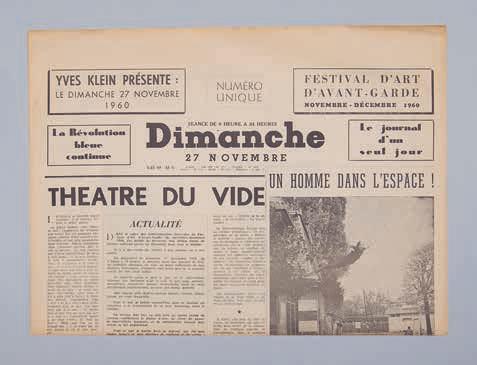
63
KLEIN , Yves. Dimanche 27 Novembre 1960. Numéro Unique. Paris, self-published, 1960. [ref. 111767] £2750
Yves Klein produced this publication for the Festival d’Art d’Avant-Garde in Paris, displaying it on newsstands for one day. The previous month, Klein hired photographers Harry Shunk and Jean Kender to photograph him re-creating a jump from a second-floor window that he claimed to have executed successfully earlier that year. A group of Klein’s judo friends were positioned below the window, holding a stretched tarpaulin to catch him as he fell. The final image, a photomontage composed of two frames removing the tarpaulin, is printed with the headline ‘Un homme dans l’espace!’ and a caption reading ‘Le peintre de l’espace se jette dans le vide (A Man in Space! The Painter of Space throws himself into the void).’ Elsewhere in the publication, contents include colour theory, immateriality, and judo material.
First edition; newspaper (560 x 382 mm, 22 x 15 in) machinefolded in half as issued; black-and-white photographs printed in offset, minor toning, short tears at horizontal fold, an excellent copy; [4]pp.
Extra Art 253; Artists’ Magazines pp254.

64 SIGNED
LARTIGUE , Jacques Henri. Diary of a Century. New York, The Viking Press, 1970. [ref. 110781]
£1500
Signed by Lartigue, who in 1901, aged seven, was given a largeplate camera by his father and, the following year, received a Brownie No.2 handheld camera. He immediately started photographing his family life, sporting events, and modern inventions, including early planes and automobiles, as he and his prosperous family travelled throughout Europe. Lartigue continued photographing throughout his youth and had taken many of his best-known photographs by the age of thirteen. In 1962, a selection of his pictures were exhibited in Paris, and the following year, John Szarkowski mounted an exhibition at the Museum of Modern Art in New York. [With] a copy of The Museum of Modern Art Bulletin, Volume XXX, No. 1, 1963, in which Szarkowski writes, ‘The vigor and freedom of Lartigue’s photographs grew from a commitment not to photography but to life. His understanding of the medium, though intense and certain, was neither broad nor subtle. His was an achievement of love and genius, uncomplicated by aesthetic theory or professional ambition... Lartigue looked into the eyes of a changing world, and what he saw there he recorded with a prophetic freshness of vision.’
First edition, signed on the title page; 4to (330 x 251 mm, 13 x 10 in); black and white photographs printed in gravure, endpapers feature reproductions of pages from his diary, edited by Richard Avedon, designed by Bea Feitler; brown cloth-covered boards, titles stamped in gold on spine and in blind on upper side, fine in a near-fine metallic gold printed and embossed dust-jacket which is lightly rubbed and scratched, as often, with one short tear and toning to verso; [254]pp.
Regards à travers Le Livre 160; The Book of 101 Books pp200-1; The Open Book pp264–5; Auer Collection p517.

65
WITH A PRINT OF THE COVER IMAGE LINK , O Winston. “Night Trick” on the Norfolk and Western Railway. [With] J. R. Harrell, Powhatan Arrow engineer, taken in Shaffers Crossing roundhouse, Roanoke, Virginia. Roanoke, Virginia, Norfolk and Western Railway, 1957; c.1955. [ref. 110759] £5000
O. Winston Link’s first publication with a vintage print of the cover image. In the mid-1950s, Norfolk & Western was one of the few remaining American railroad companies that continued to
use steam instead of diesel-powered engines. Between 1955 and May 1960, when the last steam engine ran, Link documented the final years of the steam engine and the erosion of the American rural landscape. While working as a successful, technically accomplished industrial photographer, he experimented with complicated lighting set-ups to photograph trains at night in his spare time. Having a lifelong love of trains, he submitted a proposal to the head of the Norfolk & Western Railway asking permission to photograph at night the trains, people and buildings along the route, which ran from Norfolk, Virginia, to Cincinnati and Columbus and the North-South lines, which crossed it. ‘Night Trick’ is the name given to the night shift by those railmen working it.
First edition, with a vintage print of the cover image; oblong 4to (215 × 278 mm, 8½ x 11 in); black-and-white photographs and a map printed in relief halftone; wire-stitched photo-illustrated wrappers printed in yellow; light wear along spine and edges, handling marks and light rubbing to lower side, a very good copy; [16]pp.
‘J. R. Harrell, Powhatan Arrow engineer’: vintage gelatin silver print, (image: 193 × 242 mm, 7½ x 9½ in; sheet slightly larger, rough cut along bottom edge); Link’s early ‘Owl’ studio hand stamp, his copyright stamp, and an inventory notation in pencil, on verso, crease across bottom right corner, light handling marks, some mirroring.

66
THE FIRST PUBLICATION OF A RAYOGRAPH
[MAN RAY ]. RAVAL , Marcel (editor). Les Feuilles Libres no. 26 Quatrième année Avril-Mai 1922. Paris, Librairie Stock, 1922. [ref. 111378] £500
This issue of Les Feuilles Libres contains the first publication of one of Man Ray’s rayographs, preceding Les Champs Délicieux (1922) by several months. In the accompanying text, ‘An Open Letter to M. Man Ray, American Photographer,’ Jean Cocteau writes that with the rayographs, Man Ray has ‘accomplished an ironic reversal of the avant-garde axiom according to which photography has freed painters from the task of realistic representation, thus enabling them to pursue abstraction’ (translated in Photography in the Modern Era p1).
Serial publication; 8vo (220 x 183 mm, 8¾ x 7¼ in); illustrations based on drawings by Picasso within the text, and a laid in plate with a tipped in Rayograph by Man Ray printed in relief halftone, texts by Marcel Proust, Jean Cocteau, Max Jacob,
Max Ernst and Paul Eluard, Jean Epstein, Blaise Cendrars, André Lhote, and others, light foxing to preliminary and end pages; white printed wrappers, text in black, light wear with professional repair; [ii], [82]pp (numbered 75-156).
Photography in the Modern Era pp1–3.
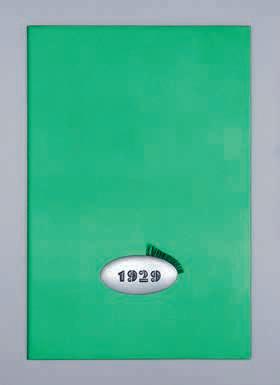
67 ONE OF A SMALL NUMBER OF AUTHOR’S COPIES ON GREEN PAPER IN A BINDING BY JEAN DE GENET
[MAN RAY]; PÉRET, Benjamin and ARAGON , Louis. 1929. Bruxelles, Éditions de la Revue Variétés, 1929. [ref. 95020] £19,500
One of a small number of author’s copies on green paper, printed aside from the edition mentioned in the colophon, which was limited to 215 copies. 1929 features twelve erotic surrealist poems by Benjamin Péret and Louis Aragon. The book is divided in two: the ‘premier semestre’ features six works by Péret for January – June, with six by Aragon for July – August, the ‘deuxième semestre.’ These poems are illustrated by four of Man Ray’s explicit photographs, captioned ‘Printemps,’ ‘Été,’ ‘Automne,’ and ‘Hiver,’ one of which appears to feature his lover, Kiki de Montparnasse.
A year after its creation in 1928, Paul-Gustave Van Hecke’s Belgian avant-garde magazine Variétés (May 1928–April 1930) began to experience financial difficulties. 1929 was seemingly conceived and sold in an attempt to raise funds to print a special issue (June 1929) devoted to surrealism, which André Breton and Louis Aragon edited, featuring work by Péret, Aragon, Man Ray and others. French customs officers intercepted 1929 at the Belgian border, destroying many copies as they made their way to Paris.
The present copy was displayed as part of the Tate Modern exhibition Surrealism: Desire Unbound in 2001, then at The Metropolitan Museum of Art, New York, in 2002 (p336 in the exhibition catalogue), though it had yet to be bound by Jean de Genet at that time. The catalogue states that this is the only known example on green paper.
First edition, one of a small number of copies on green paper reserved for the authors; 4to (300 x 200 mm, 11¾ x 7¾ in); 4 tipped in black-and-white photographs by Man Ray printed in relief halftone, poems by Benjamin Péret and Louis Aragon, margins toned; original green printed wrappers, title in black,
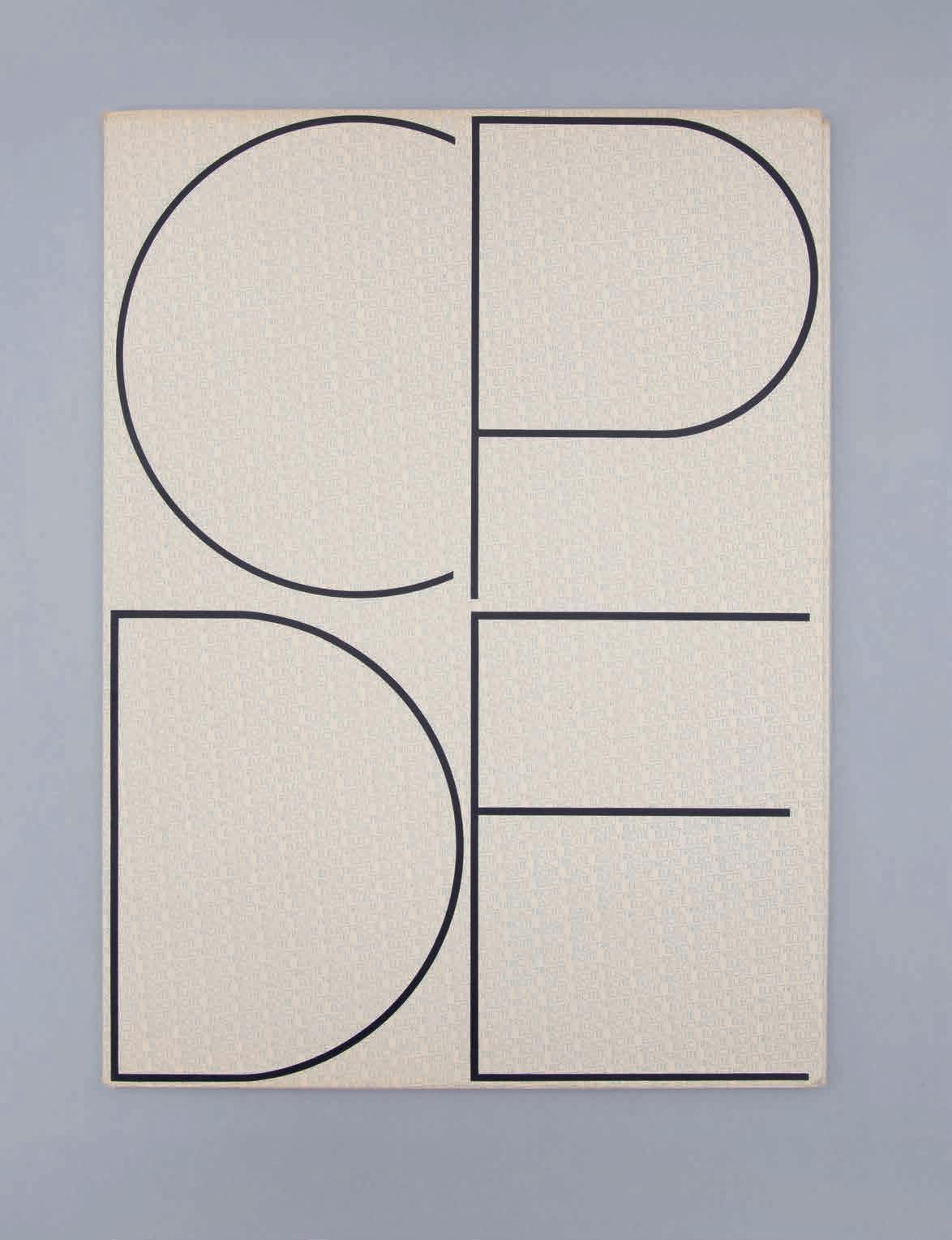
toned and frayed, in a binding by Jean de Genet of iridescent green calf over flexible boards, ovoid eye in silver calf with ‘1929’ in dark grey curved figures in relief bordered with large false eyelash mounted on upper board, lined with navy blue suede, binders mark dated 2003 to verso of upper board, housed in black paper over board drop back box with navy blue suede lining, silver lettering on calf spine; [28]pp.
Provenance: D. Gransart, Galerie Obsis (catalogue TateMOMA); Artcurial (9 June 2004, lot 28).
Dada and Surrealism Reviewed 9.101; Les livres de l’Enfer 937; Surrealism: Desire Unbound p33, p134, p336; Bibliographie des ouvrages érotiques II, 1986; L’Enfer de la bibliothèque. Éros au secret. B.n.F., 243, p421; The Photobook: A History II, p138; Auer Collection p138; Paris: Les Livre de photographie pp47.
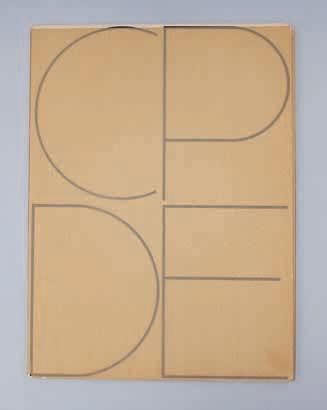
68
ONE OF THE MOST BEAUTIFUL AND SOUGHT-AFTER COMPANY PHOTOBOOKS
MAN RAY. Électricité. Dix rayogrammes de Man Ray et un texte de Pierre Bost. Paris, La Compagnie Parisienne de Distribution d’électricité (CPDE), 1931. [ref. 110985]
£50,000
Man Ray’s Électricité is one of the most beautiful and soughtafter company photobooks. It was produced for CPDE, the Parisian electrical company, to showcase the various applications of electricity within the home. This cogent suite of photographs utilizes the techniques for which Man Ray is best known: solarisation, montage, and the photogram. The resulting images rank among his most significant works.
First edition, number 439 of 500 copies; folio (378 x 282 mm, 15 x 11 in); [8]pp booklet with text by Pierre Bost and ten rayographs printed in gravure by Alb. Jarach et P. Chambry tipped onto paper mounts with printed glassine sleeves, tiny chip to corner of one mount; printed folding case, white with ‘électricité’ repeated in blue and ‘CPDE’ in black on front, numbered inside, glassine dust-jacket, lightly toned with a couple of minor nicks, with the original numbered cardboard slipcase, worn, Compagnie Parisienne de Distribution d’électricité compliments card laid in as issued, a fine copy.
The Photobook: A History II, pp182–3; Paris: Les Livre de photographie p101.

69
[MARSHALL PLAN]. Electriciteit. Marshall Plan Picture News
103. Paris, VIU OSR Visual Information Unit / Office of the Special Representative, printed by Georges Lang, 1950. [ref. 111309] £1500
This mobile poster exhibition was produced by the Visual Information Unit of the Office of the Special Representative (OSR) in Paris, the European headquarters of the Marshall Plan Organisation. It was part of a coordinated campaign to present the virtues of the Marshall Plan, which saw the United States provide economic assistance to restore Europe’s industrial and agricultural production, its economic infrastructure and to expand trade in the aftermath of the Second World War.
This example deals with electric power projects, their relation to European integration, and electricity’s various uses and benefits for agriculture, industry, and the home. It comprises twelve folded sheets, with a poster printed on each side, resulting in four illustration series being obtained by turning the pages differently. The design allows for presenting four combinations in an easily portable format and is highly suitable for simple exhibition purposes. These posters were displayed in schools, workplaces, factories, fairgrounds, village halls, shops, and town squares. Other Marshall Plan Picture News editions were devoted to themes including housing, agriculture, health, fishing and processing plants. The output of the Visual Information Unit received attention from important design periodicals at the time. A 1951 article in Graphis titled ‘Marshall Plan: Design in the Service of European Cooperation’ gives an overview of some of its projects and reproduces the cover of Picture News 103.
First edition; folio (481 x 301 mm, 19 x 11¾ in) 13 folded sheets, title sheet followed by 12 numbered leaves, each page lettered A-D with circular perforations to facilitate display; black-andwhite photographs and photomontages printed in black, orange, and green in relief halftone by Georges Lang, Paris, text in Dutch, occasional staining, some sheets toned, very good; [52]pp.
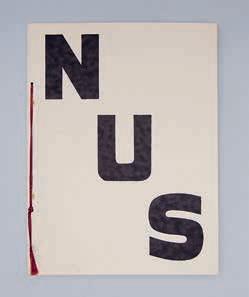
70
MASCLET, Daniel (editor). Nus [cover title] Daniel Masclet
Presente La Beaute de la Femme. Album du Premier Salon
International du Nu Photographique Paris 1933. Paris, Daniel Masclet, 1933. [ref. 111708]
£750
Daniel Masclet was a talented musician before following a career as a photographer and writer. In 1933, he organised the first ‘Salon International du Nu Photographique’ in Paris. This catalogue, issued to coincide with the exhibition, features female nudes selected by Masclet to fulfil both technical and artistic criteria. The contributors include Frantisek Drtikol, Man Ray, Moholy-Nagy, Laure Albin-Guillot, Yva, George Platt Lynes and other leading photographers of the time.
First edition; 4to (314 x 238 mm, 12¼ x 9¼ in); black-andwhite photographs printed in gravure by Braun & Cie, foreword by Daniel Masclet; printed cream wrappers bound with burgundy thread, title in black on upper side, two small spots to upper side at spine otherwise fine; [vi], 96, [4]pp.
Ralph Eugene Meatyard was an optician by trade. He photographed mainly on the weekends and mostly in and around Lexington, Kentucky, where he raised his family. In this, his best-known work, he cast his wife Madelyn as the maskwearing central character Lucybelle Crater, a name adapted from a character in Flannery O’Connor’s short story The Life You Save May Be Your Own (1953). Meatyard photographs his wife standing with several similarly masked friends and family members, including Jonathan Williams, who posthumously published this book. In the final photograph, Meatyard assumes the persona.
First edition; 4to (266 x 228 mm, 10½ x 9 in); black-and-white photographs printed in offset, minor foxing to edges and top edge of preliminary pages; cream endpapers, toned with binder’s glue showing through, beige cloth-covered boards, titles stamped in black on spine and upper side, light foxing to joints, photoillustrated dust-jacket, white, text in black, near-fine; [ii], 84, [2]pp.
The Book of 101 Books pp230–1; Auer Collection p577.
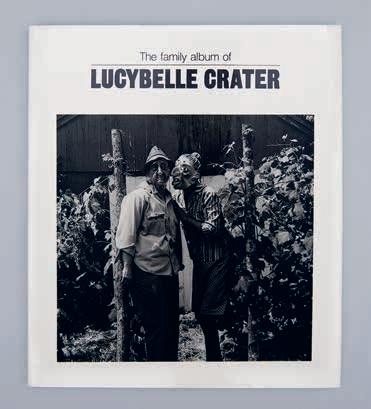
Paris: Les Livre de photographie pp133–5. 71
MEATYARD, Ralph Eugene The Family Album of Lucybelle Crater. With texts by Jonathan Greene, Ronald Johnson, Ralph Eugene Meatyard, Guy Mendes, Thomas Meyer, and Jonathan Williams. North Carolina, The Jargon Society, 1974. [ref. 111663]
£350
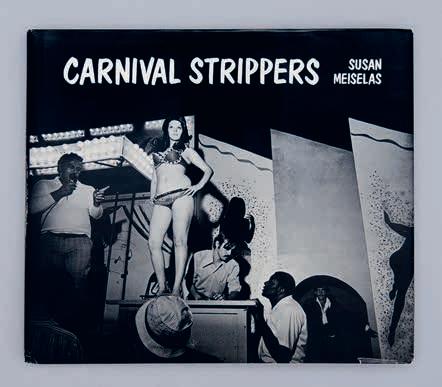
72
MEISELAS , Susan. Carnival Strippers. New York, Farrar, Straus and Giroux, 1976. [ref. 111666] £675
For this, her first major series, Susan Meiselas, photographed and interviewed dancers, audience members, and stage managers who worked in and visited the strip shows at travelling carnivals in and around New England. Carnival Strippers was published the same year Meiselas joined Magnum Photos.
First edition; (221 x 258 mm, 8¾ x 10¼ in); black-and-white photographs printed in offset; black endpapers, silver papercovered boards, titles stamped in silver to spine and upper side, head and foot of spine tapped, photo-illustrated dust-jacket, minor wear to extremities, nick with crease to bottom edge of upper panel, light creasing to head and foot of spine panel, rubbing and marking to lower panel, near-fine in an excellent dustjacket; [ii], 150pp.
The Book of 101 Books pp238–9; Auer Collection 599; The Open Book pp312–3; What They Saw: Historical Photobooks by Women pp234–5.

73
PRESENTATION COPY
MODEL , Lisette. Lisette Model. Designed by Marvin Israel with a preface by Berenice Abbott. Millerton, New York, Aperture, 1979. [ref. 111720] £750
Presentation copy of Lisette Model’s first monograph, inscriberd: ’To Edna / My first interviewer when I did / not know what I was doing – / With all my love from / Lisette / November 1979’.
Edna ‘Bennie’ Bennett, was a photographer, writer, naturalist, an editor of US Camera and contributor to Aperture, and later a used bookseller on Long Island, and a friend of Lisette Model and Berenice Abbott (see item 02).
First edition, presentation copy inscribed on the half-title; folio (377 x 231 mm, 14¾ x 9 in); black-and-white photographs printed in offset, light toning to edges, occasional light foxing; endpapers grey on one side cream on the other, photo-illustrated paper-covered boards, printed in grey and black, cocked, corners tapped, dust-jacket printed in imitation of boards, handling marks, light foxing to verso, minor wear to edges, an excellent copy; 112pp.
The Book of 101 Books pp242–3; Auer Collection p617; What They Saw: Photobooks by Women pp254–5.

74
WITH THE PUBLISHER’S SCARCE WRAPAROUND BAND
MOHOLY-NAGY, L[aszlo]; ROH , Franz (editor). 60 Fotos
herausgegeben von Franz Roh. 60 photos edited by Franz Roh. 60 photographies publiées par Franz Roh. Fototek 1. Berlin,
Klinkhardt & Biermann, 1930. [ref. 111374] £2750
The first monograph of Moholy-Nagy’s photographs, with the publisher’s scarce wraparound band, which exists in three versions: German, French, and English. This book was supposed to be a part of a much larger series of books titled Fototek, but only the first two were published due to the economic and political circumstances in Germany at the time. The second volume, also titled 60 Fotos, is devoted to Aenne Biermann, with future unrealized titles announced at the rear, to include ‘The Monsterous – Kitsch in Photography’; ‘Photomontage edited by Jan Tschichold’; ‘The Police Photograph’; ‘El Lissitsky 60 Fotos and Typofotos’; ‘The Sport Photograph’; and ‘100 years of Nude Photography’, a note also states that several others were being planned. The series was edited by Franz Roh and designed by Jan Tschichold.
Roh and Tschichold had previously collaborated on FotoAuge (see item 93), the book issued to accompany the Film und Foto exhibition in Stuttgart. Sales of the two Fototek volumes were sluggish, and the financial difficulties that Klinkhardt & Biermann encountered due to the economic crisis led to the sale of the publishing house. In March 1932, Franz Roh wrote to the photographer Moi Ver that he still hoped to be able to include his work in a later volume of the Fototek series but that negotiations with the new owners were ongoing. The following March, he again wrote to Moi Ver, stating that he hoped to continue the series with another publisher, adding that he had asked Laszlo Moholy-Nagy to come on board as a co-editor. However, shortly after this, the Nazi Party came to power, and the political and cultural changes in Germany made it impossible to continue a series like Fototek.
First edition with the scarce wraparound band; 8vo (249 x 175 mm, 9¾ x 7 in); black-and-white photographs printed in relief halftone by F. Bruckmann AG, Munich, text in German, English, and French, design by Jan Tschichold; photo-illustrated wrappers printed in yellow and black, publisher's green printed wraparound band, minor wear, in a custom drop spine box by Julie Nadot, fine; 11, [60], [5]pp.
Regards à travers Le Livre 33; Fotografia Pública 586; Auer Collection p158; Autopsie II, pp332–43.

75 PRESENTATION COPY
MOHOLY-NAGY, L[aszlo]; ROH , Franz (editor). 60 Fotos
herausgegeben von Franz Roh. 60 photos edited by Franz Roh. 60 photographies publiées par Franz Roh. Fototek 1. Berlin,
Klinkhardt & Biermann, 1930. [ref. 111545] £650
The first monograph of Moholy-Nagy’s photographs, presentation copy inscribed: ‘für herr sandels mit / besten gruss[?] / Moholy-Nagy / 25/XI/37’. Moholy-Nagy was appointed director of The New Bauhaus: American School of Design in Chicago, with classes beginning in October 1937, on the recommendation of Walter Gropius, who had just accepted a position at Harvard. Moholy-Nagy had spent the previous two years in London and the year before that in Amsterdam after leaving Berlin in 1933.
First edition, presentation copy inscribed by Moholy-Nagy on the first page; 8vo (249 x 175 mm, 9¾ x 7 in); black-andwhite photographs printed in relief halftone by F. Bruckmann AG, Munich, text in German, English, and French, design by Jan Tschichold, foxing and toning to preliminary and end pages; photoillustrated wrappers printed in yellow and black, spine toned with wear and loss to head, foot, and middle, chip to lower side at head, lower wrapper split, small label to verso of upper wrapper; 11, [60], [5]pp.
Regards à travers Le Livre 33; Fotografia Pública 585; Auer Collection p158; Autopsie II, pp332–43.

76
WITH THE SCARCE DUST-JACKET [MOÏ-VER] (pseud. RAVIV-VOROBEICHIC, Moshé). The Ghetto Lane in Wilna. 65 Pictures by M. Vorobeichic. Preface by S. Chneour. Publisher: Dr. Emil Schaeffer. Zurich & Leipzig, Orell Fussli Verlag, 1931. [ref. 106541] £1500
Moï-Ver made the photographs for this, his first book in the Jewish quarter of Vilnius, where he was born and raised. In 1927, he attended classes at the Bauhaus in Dessau before going to Paris to study at the École Technique de Photographie et de Cinematographie. Both his photographs and the layout employ New Vision techniques such as unconventional angles, doubleprinting, repetition, and montage to create a visually stunning book that documents a way of life that was to be destroyed by Nazi Germany a decade later. This is the most sought-after book in the Orell Füssli’s Schaubücher series. It was issued simultaneously in German/Hebrew, English/Hebrew, and
German/Yiddish versions.
First edition, English/Hebrew issue; 12mo (189 x 127 mm, 7½ x 5 in); 64 pages of black-and-white photomontages and photographs printed in relief halftone, text in English (left to right) and Hebrew (right to left), stamped ‘Printed in Switzerland’ opposite title-page; plain endpapers, quarter orange cloth, photoillustrated paper-covered boards printed in black and orange, titles stamped in black on spine, light wear to extremities, slightly bowed, publisher’s plastic dust-jacket, shrunken and chipped as usual, near-fine in the sarce dust-jacket; 7, [1], [64], 6, [2]pp.
[German/Hebrew issue] Regards à travers Le Livre 46; The Photobook: A History I, p130; Auer Collection p168.
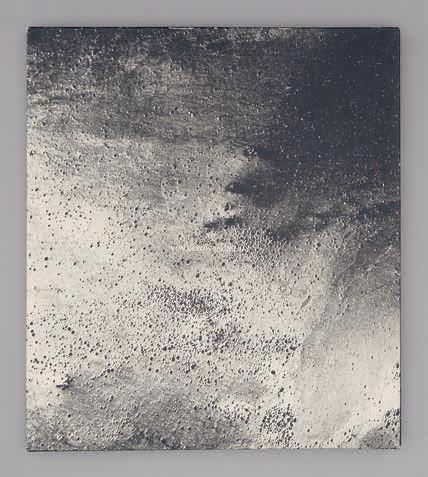
77
MORINAGA , Jun. River, its shadow of shadows. Tokyo, Yugensha / Kazuhiko Motomura, 1978. [ref. 111196] £850
Morinaga Jun was born in Nagasaki, where the atomic bomb killed his father and older sister. In 1960, the year he graduated from Nihon University College of Art, he began making abstract photographs of the pollution and decay along Tokyo’s muddy rivers, continuing to work on the project over the following three years. The origin of this series is closely related to his memories of his father and sister, and these photographs became River, its shadow of shadows. Shortly after beginning this series, Morinaga met and showed his work to W. Eugene Smith, who was impressed and hired Morinaga to work as an assistant on a commission for Hitachi that would become Japan: Chapter of Image (1963). Morinaga’s photographs of these Tokyo rivers foreshadow Smith’s decision to document the catastrophic fallout from polluted waters in Minamata (see item 99).
Smith’s initial living costs in Japan whilst working on the Minamata project were covered by Motomura Kazuhiko, publisher of Morinaga’s River, its shadow of shadows and three books by Robert Frank. Motomura met and befriended Morinaga while studying at the Tokyo College of Photography. Through Morinaga, Motomura met W. Eugene Smith, and then he met Robert Frank through Smith as a favour in return for
helping Smith with the Minamata work. Motomura was an important collector of photographs and photography books and a tireless champion of Japanese photographers, promoting their work and supporting their books and exhibitions.
First edition, 500 copies; folio (300 x 270 mm, 11¾ x 10¾ in); black-and-white photographs printed in offset, texts by Miyabi Ichikawa, Koichi Tanigawa, Seigow Matsuoka, and Jun Morinaga in Japanese, text by W. Eugene Smith in Japanese and English, design by Kohei Sugiura and Hitoshi Suzuki, occasional light dust speckle marks spotted out by hand by Motomura; grey cloth-covered boards, titles stamped in white on spine and sides, publisher’s photo-illustrated paper-covered board slipcase, minor wear to extremities, original shipping carton with staining to one side, fine; [170]pp (incl. 20 folding).
Japanese Photobooks of the 1960s and ’70s pp218–21; The Japanese Photobook 484.

78
MORIYAMA , Daido. Shashin yo Sayonara [Bye Bye Photography]. Tokyo, Shashin Hyoron-sha, 1972. [ref. 111556] £6000
Presentation copy, inscribed to Hilary Gerrard. Shashin yo Sayonara is the central book of the Provoke movement, born out of Moriyama’s perceived limitations of Provoke’s manifesto and photography as a medium. The resulting combination of images re-photographed from newspapers, magazines, television screens, other people’s negatives, and his own pictures composed mainly of out-takes, scratched frames, and blurred images was sequenced by two editors at Shashin Hyoron-sha in a seemingly random order to create a visual manifestation of the overpowering density of life in modern Japan.
First edition, presentation copy inscribed by Moriyama in black ink on the title-page; 4to (230 x 181 mm, 9 x 7¼ in); blackand-white photographs printed in gravure, transcript of a conversation between Moriyama Daido and Nakahira Takuma, minor spotting to top edge; plain endpapers, ghost mark from bookseller’s label, printed wrappers, black, grey, and blue, minor reading crease, printed white dust-jacket, text in black, blue, and grey, trivial wear along spine-fold, publisher’s red order slip laid in, fine; 308, [2]pp.
Provenance: Hilary Gerrard (author’s inscription).
The Book of 101 Books pp218–221; The Photobook: A History I, pp298–9; Auer Collection p543; For a New World to Come 172; The Japanese Photobook 256.

79
MORIYAMA , Daido. Kariudo / A Hunter. Tokyo, Chuo-koronsha, 1972. [ref. 111557] £2750
Moriyama produced three books in the first half of 1972: Shashin yo Sayonara [Bye, Bye Photography], Kagero [Mayfly], and the present work Kariudo / A Hunter. Realising three books in such a short period left Moriyama feeling something he likens to a crisis in creative confidence. As a result, he scaled back his photographic work for several years. A Hunter was published as the final book in Chuo-koron-sha’s 10-volume series of monographs by contemporary Japanese photographers. It contains a tightly sequenced selection of Moriyama’s best photographs from 1968-1971 and was published as he was in the middle of his most creative period. Moriyama was an admirer of Jack Kerouac’s On the Road (1957) and dedicated A Hunter to the beat writer.
First edition; 4to (256 x 216 mm, 10 x 8½ in); black-and-white photographs printed in offset, texts by Tadanori Yokoo and Yamagishi Shoji in Japanese and English, light foxing to top edge and end pages, offsetting to one page; plain endpapers, lightly foxed, printed white paper-covered boards, text in black, leaning slightly, dust-jacket printed in green and red, minor wear to edges, publisher’s printed wraparound band, grey, corner of flap turned, original fitted acetate dust-jacket, lightly rubbed, nearfine; [120]pp.
Auer Collection p542; The Photobook: A History I, p300; The Japanese Photobook 429.

PRESENTATION COPY
MORRIS , Wright. The Inhabitants. Text and Photographs by Wright Morris. New York and London, Charles Scribner’s Sons and Charles Scribner’s Sons, Ltd., 1946. [ref. 111547] £875
Presentation copy inscribed: ‘For / Lambert Davis / who should have had his hand / as well as his name / in this book / Wright Morris / Bryn Mawr / Sept. 22, 1946’. After which, a pencil note is added stating that Lambert Davis was Morris’s editor at Harcourt Brace for his first book.
Wright Morris was born and grew up in Omaha, Nebraska. Later, after leaving the Midwest, he began to write reminiscences of the people and landscape in his journal. In 1938, he made a cross-country trip from California to Philadelphia and was struck by the houses, barns, churches, grain elevators and other rural pre-war buildings that dotted the Midwest landscape. In 1941, he was given a Guggenheim Fellowship grant to work on The Inhabitants, which pairs photographs of exterior views and details of these buildings with short pieces of prose relating to these photographs. At the time of publication, there were few precedents for such a combination of text and photographs. A description on the rear panel states: ‘To get the full impact of the book … the photographs and the text must be considered as one–they must be “taken in” concurrently. The pictures do not “illustrate” the text, they are part of it, and the same is true of the “soundtrack”–the words.’
First edition, presentation copy inscribed on the dedication page; 4to (279 x 227 mm, 11 x 9 in); black-and-white photographs printed in relief halftone, occasional light foxing; black coated endpapers, tan cloth-covered boards, titles stamped to spine in black and to upper side in blind, outline of ’The’ in the title on the upper board outlined in ink, lightly toned and marked, hinges starting, photo-illustrated dust-jacket printed in green and black, light wear, small chip to lower panel, light creasing to head of spine, a very good copy in a near-fine supplied jacket; [112]pp.
Provenance: Lambert Davis (author’s inscription).
Regards à travers Le Livre 88; The Book of 101 Books pp122–3; Auer Collection p318.
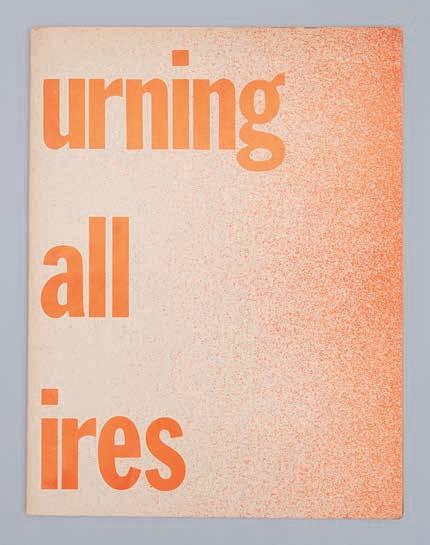
81
NAUMAN , Bruce. Burning Small Fires. San Francisco, selfpublished, 1968. [ref. 111665] £5750
This artists’ book comprises a bound folded poster showing fifteen photographs of burning pages from Ed Ruscha’s second book Various Small Fires and Milk (1964).
First edition; single sheet (1253 x 936 mm, 49¼ x 36¾ in machine-folded to 313 x 235 mm, 12¼ x 9¼ in); 15 black-and-white photographs printed in offset, occasional wear at folds; mounted into printed card covers, minor wear to head and one corner, near-fine.
Book as Artwork pp66; Bruce Nauman: Prints 1970 – 89, A Catalogue Raisonné p130; Esthétique du Livre d’Artiste pp338.

82
INSCRIBED BY RINGO STARR AND HIS GIRLFRIEND TO HIS MANAGER
NEWTON , Helmut. White Women. New York, Stonehill, 1976. [ref. 110935] £2500
Presentation copy of Helmut Newton’s White Women, inscribed in the year of publication by Ringo Starr and his girlfriend Nancy Lee Andrews to Hilary Gerrard, Ringo’s manager for over thirty years and a director of the Beatles company Apple Corps: ‘January 19, 1976 / Dear Hil– / Sure hope this book / brings a grin to your face. / [signed] Ringo xxx & Nancy xx’.
First edition, inscribed to Hilary Gerrard by Nancy Lee Andrews and Ringo Starr, in Nancy’s hand and signed by Ringo, with a photographic portrait of Nancy laid in; 4to (305 x 226 mm, 12 x 9 in); black-and-white and colour photographs printed in offset, design by Bea Feitler, minor toning to edges, occasional light stain in margins; blue endpapers, light blue cloth-covered boards, titles stamped to spine and upper side in silver, minor toning at head of spine, photo-illustrated price-clipped dustjacket, lightly rubbed, wear to extremities, chip to head of spine, near-fine in a very good dust-jacket; [128]pp.
Provenance: Hilary Gerrard (inscription by Ringo Starr).

83 SIGNED
PARR , Martin. The Last Resort. Photographs of New Brighton. By Martin Parr text by Ian Walker. Wallasey, Promenade Press, 1986. [ref. 111721] £675
Martin Parr made this series of colour photographs between 1983 and 1985 in New Brighton, a British seaside town near Liverpool, using a medium format camera and daylight flash. They are an early example of his characteristic use of saturated colour.
First edition, signed on first page; oblong 4to (230 x 297 mm, 9 x 11¾ in); colour photographs printed in offset; illustrated wrappers, printed in blue green, orange, yellow, and red, fine; [88]pp.
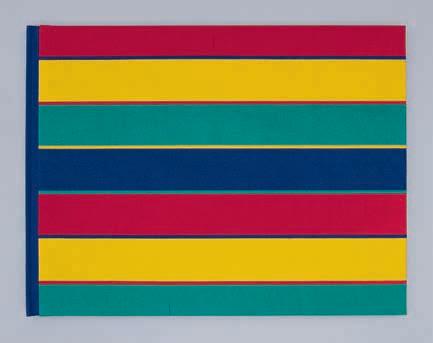
84
ONE OF 250 COPIES – SIGNED
PARR , Martin. West Bay. Photographs by Martin Parr poems by eight contemporary poets. Steventon, Oxfordshire, The Rocket Press, 1997. [ref. 111722] £1200
Martin Parr made these photographs in West Bay, a small Dorset seaside town near Bridport, over the 1996 August Bank Holiday weekend. West Bay was the first series where Parr employed his now characteristic combination of a ring flash and a macro lens. The edition is stated as 250 copies, but according to the publisher, only 175 copies were completed as the bindery went into receivership during production.
First edition, number 48 of 250 copies, signed on the limitation page; oblong folio (310 x 415 mm, 12¼ x 16¼ in); 24 colour photographic plates tipped in, poems by Fergus Allen, Kate Clanchy, Phili Gross, Sophie Hannah, Geoffrey Hoare, Alice Oswald, Roger McGough, and Vicki Raymond; plain endpapers, Bognor Regis deckchair canvas-covered boards, blue cloth spine titled in blind, original blue cloth-covered board slipcase, titles stamped in blind on sides, light marking and dust-soiling, nearfine;l [64]pp.

85
INSCRIBED TO JOHN HAYWARD
PENROSE , Roland. The Road is Wider than Long. An Image Diary from the Balkans July–August 1938. Series of Surrealist Poetry edited by E.L.T. Messens No.1. London, London Gallery Editions, 1939. [ref. 111740] £2750
Presentation copy, inscribed to editor, critic, anthologist, and bibliophile John Hayward: ‘to John Hayward / [drawing of a compass] / the vertical compass the / unfailing guide / affectionately Roland Penrose’. With two additional manuscript lines of poetry added to another page.
The Road is Wider than Long is a surrealist love poem with photographs originally presented by Penrose to Lee Miller in manuscript form. Penrose and Miller met in Paris in 1937 and soon began a romantic relationship. They travelled through Greece, Romania, and Bulgaria together the following year, each taking photographs, and Penrose based this book on his journals from the trip. In 1938, Penrose launched the London Gallery with Belgian artist E.L.T. Mesens, which became a centre for Surrealism in England. The Road is Wider than Long was published by the London Gallery as the first in a proposed series, interrupted by the war in Europe, of surrealist poetry edited by Mesens.
First edition, number 128 of 510 copies, presentation copy inscribed on the half-title with two additional lines added in manuscript; 8vo (216 x 167 mm, 8½ x 6½ in); black-and-white photographs printed in relief halftone at the Bradley Press, text in black and red; original gelatin silver photograph endpapers, imitation wood paper-covered boards, titles to spine and upper side in blue, cover designed by Hans Bellmer, light wear to extremities, an excellent copy; [52]pp.
Provenance: John Hayward (author’s inscription).
Regards à travers Le Livre 51; Auer Collection p271.
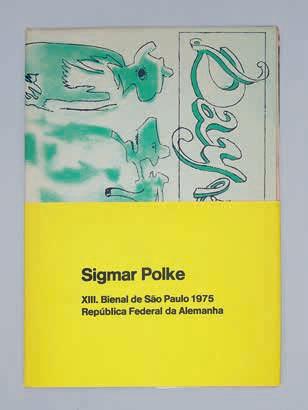
86
POLKE , Sigmar; [DUCHOW, Achim et al]. Day by Day They Take Some Brain Away XIII. Bienal de São Paulo. Köln, Weinand KG, 1975. [ref. 110754] £1675
This artists’ newspaper was issued to mark Sigmar Polke’s participation in the 13th Bienal de Sao Paulo, where he represented West Germany with Georg Baselitz and Blinky Palermo. The printed yellow band was created after publication at the request of the Brazilian government. The title Day by Day They Take Some Brain Away derives from a line in ‘All the Madmen,’ a song by David Bowie from his 1970 album The Man Who Sold the World. In Alibis, the catalogue that accompanied Polke’s 2014 retrospective at the Museum of Modern Art, New York, Jutta Koether writes about this publication: ‘He had decided to produce a sort of magazine that would illustrate his relation, rife with contradictions, to the world, to society, and to West German culture, and his discontent with the contribution he himself had made up to that point.’
In 1976, to commemorate the West German pavilion at the previous year’s Bienal São Paulo, the Bonner Kunstverein at the Rheinisches Landesmuseum staged an exhibition titled Baselitz, Palermo, Polke, Beitrag der Bundesrepublik Deutschland zur Biennial São Paulo, 1975. For this occasion, some remaining uncirculated copies of Day by Day… were issued in a printed cardboard folder with the catalogues by Georg Baselitz and Blinky Palermo.
First edition, one of 800 copies; tabloid (417 x 296 mm, 16½ x 11¾ in); colour and black-and-white photographs, drawings, and newspaper clippings printed in offset, edited and with an introductory essay by Evelyn Weiss in German and Portuguese, design by Sigmar Polke, Achim Duchow et al.; 14 loose folded sheets, newspaper folded horizontally as issued, minor wear to spine at fold, yellow printed wraparound band with the circular sticker, near-fine; [28]pp. In a lightly worn printed folder with the Georg Baselitz and Blinky Palermo catalogues.
Sigmar Polke Catalogue Raisonné 46; Alibis pp188–195; Artists Who Make Books pp218–221.


87
[PROTEST BOOK]. HAMAYA , Hiroshi. Ikari to kanashimi no kiroku [A Record of Grief and Anger]. Tokyo, Kawade Shobo Shinsha, 1960. [ref. 111106] £450
Hamaya Hiroshi is best known for his studies of the landscape, daily life, and customs and folklore in rural parts of Japan, as demonstrated in his books Yukiguni (Snowland, 1956) and Ura Nihon (Japan’s Black Coast, 1957). A Record of Grief and Anger is his documentation of the protests that took place outside the National Diet Building in Tokyo against a passage in the 1960 renewal of the Treaty of Mutual Cooperation and Security (Anpo) between the United States and Japan, which allowed the presence of US military bases in Japan. Between 20 May, when the security treaty was approved, and 22 June 1960, millions of people took part in a series of demonstrations organised by the Zengakuren student association, the Japanese Communist Party, the Japan Socialist Party, and the Japan Labor Unions General Council, who united to organise some of the largest protests in Japan’s history. Sympathy towards the protester’s cause led Hamaya to photograph the Anpo demonstrations in great detail. On 15 June, demonstrators attempted to storm the National Diet Building and met with a strong police presence, during which a female literature student named Kanba Michiko was beaten to death.
First edition; 8vo (257 x 181 mm, 10 x 7¼ in); black-and-white photographs printed in gravure, design by Sugano Umezaburo; photo-illustrated wrappers, light wear, publisher’s printed wraparound band, near-fine; [104]pp.
The Photobook A History III, p53; Provoke: Between Protest and Performance 2; The Japanese Photobook 187.

88 [PROTEST BOOK]. 10.21 towa nanika [What is October 21?].
Tokyo, The 10.21 towa nanika Publishing Committee, 1969. [ref. 110663] £2250
In the late 1960s, the student protest movement reached its peak in Japan, and a number of remarkable books were published during this period. 10.21 towa nanika is particularly valuable as a social and historical record because the students themselves created it. The title 10.21 towa nanika refers to the nationwide rally on 21 October 1968 to mark International Anti-War Day. The demonstrations were highly coordinated and took place in over 500 locations in nearly 50 cities throughout Japan. It includes photographs taken by students at these events and others during various student movement activities throughout 1967-68. The students who contributed photographs were mostly amateurs and did not have access to the appropriate equipment or film. In addition to this, the pictures were often taken at night and under challenging circumstances. Consequently, the images are mostly out of focus and grainy, prompting comparisons, which some have argued are coincidental, with the photography of the Provoke movement. Provoke founder Takuma Nakahira was heavily involved in the student protest movement, so whether or not there was any influence on the style of photography, there was undoubtedly an ideological link.
First edition; 8vo (210 x 150 mm, 8¼ x 6 in); black-and-white photographs printed in offset; photo-illustrated wrappers, printed in red and black, fine; [96]pp.
Japanese Photobooks of the 1960s and ’70s pp144–9; The Photobook: A History III, p59; For a New World to Come 353; Provoke: Between Protest and Performance pp102–109; The Japanese Photobook 199.

COMPLETE SET OF PROVOKE – VOL II INSCRIBED BY TAKANASHI [PROVOKE]. NAKAHIRA , Takuma; TAKANASHI , Yutaka; TAKI , Koji; OKADA , Takahiko; MORIYAMA , Daido. Provoke / Purovoku: shisho no tame no chohatsuteki shiryo kikan dai 1-go [Provokative Materials for Thought. Quarterly. No. 1]; Provoke / Purovoku: shisho no tame no chohatsuteki shiryo kikan dai 2-go [Provokative Materials for Thought. Quarterly. No. 2]; Provoke / Purovoku: shisho no tame no chohatsuteki shiryo kikan dai 3-go [Provokative Materials for Thought. Quarterly. No. 3]; [with] Amano Michie. Mazu tashikarashisa no sekai o sutero. Shashin to gengo no shiso [First, Abandon the Realm of Verisimilitude. Thoughts on Photography and Language]. Tokyo, Provokesha, 1968, 1969, 1969; & 1970. [ref. 111558] £15,000
Provoke was co-founded by Nakahira, Tatsuma, Okada Takahiko, Takanashi Yutaka, and Taki Koji, with Moriyama Daido joining them for the second issue. The group disbanded after publication of Provoke 3, and the following year issued First, Abandon the Realm of Verisimilitude (Provoke 4 & 5) as a summary of their activities, reproducing five photographic sequences and six texts. Taki's introduction to Provoke 1 serves as a manifesto for the group:
‘Photographs alone are not ideas. They cannot encompass the totality of a concept, nor have they the interchangeability of language. Yet, because of their irreversible physicality – moments of reality clipped by the camera – photographs inhabit a world that lies behind language, at times provoking the world of ideas. When this happens, language can overcome its own rigid conventions, transforming into new words, new meanings. Today, as words are severed from their material base, their reality, to flutter in space, we photographers must use our own eyes to grasp fragments of reality far beyond the reach of pre-existing language, presenting materials that actively oppose words and ideas. Thus we have to swallow a certain degree of embarrassment in order to give PROVOKE the subtitle: materials to provoke thought.’
First edition, inscribed by Takanashi Yutaka below the introduction; 4to (210 x 210 mm, 8¼ x 8¼ in); texts by Taki Koji and Okada Takahiko, black-and-white photographs by Nakahira Takuma, Takanashi Yutaka, and Taki Koji in relief halftone; selfendpapers, white printed wrappers, text in black, toned and soiled, handling creases to lower side, a very good copy; [ii], 68, [2]pp.
‘Provoke No. 2’: First edition; 4to (242 x 180 mm, 9½ x 7 in); text by Okada Takahiko, black-and-white photographs by Moriyama Daido, Taki Koji, Nakahira Takuma, and Takanashi Yutaka in relief halftone printed by Toppan Printing Co., Ltd.; self-endpapers, grey printed wrappers, text in black, light wear to extremities, light rubbing along spine-fold, handling creases and marks, without the band, a very good copy; 107, [2]pp.
‘Provoke No. 3’: First edition; 4to (240 x 184 mm, 9½ x 7¼ in); texts by Gozo Yoshimasu, Okada Takahiko, and Taki Koji, photographs by Moriyama Daido, Taki Koji, Nakahira Takuma, Takanashi Yutaka in relief halftone printed by Ichimura Genshokuban Insatsu, Tokyo; red printed wrappers with flaps, text in black, fine; 110, [2]pp (incl. 2 folding).
‘Amano Michie’: First edition; 8vo (205 x 144 mm, 8 x 5¾ in); texts by Amano Michie and Okada Takahiko, photographs by Moriyama Daido, Nakahira Takuma, Takanashi Yutaka, and Taki Koji in relief halftone printed by Seiwa, Tokyo, lightly toned, light spotting to top edge, errata slip; self-endpapers, photo-illustrated wrappers, printed in burgundy, light wear to bottom edge, minor creasing to spine, photo-illustrated dust-jacket, printed in red and black, light toning, minor wear to extremities, without the band, a very good copy; [ii], 340, [8]pp.
The Open Book pp240–1, pp242–3, pp244–5, pp252–3; The Japanese Photobook 251, 252, 253, 254.

90
RASCH , Heinz und Bodo (editors). Gefesselter Blick [The Captivated Gaze]. 25 kurze Monografien und Beiträge über neue Werbegestaltung. Mit Unterstützung des ‘Ringes der Werbegestalter des Schweizer Werkbundes’ u.a. herausgegeben und mit einer Einleitung versehen von Heinz und Bodo Rasch. Stuttgart, Wissenschaftlicher Verlag Dr. Zaugg & Co., 1930. [ref. 111011] £5750
Gefesselter Blick was published with the support of Der Ring Neue Werbegestalter [The Circle of New Advertising


Designers], an exhibiting society founded by Kurt Schwitters in 1928 dedicated to promoting modern graphic design. Heinz and Bodo Rasch edited this anthology of modernist advertising design and typography, collecting a statement and examples of work from 26 leading graphic artists and designers. In their introduction, they provide one of the earliest, clearest statements about graphic design, which they describe as a more or less dense grid of images, like film.
'Film is function interpreted by images... Text is simply a film made up of symbolic signs... Images are supported by text; text is supported by images. This mixture of image and word is graphic design's chief field of activity' (translated in Swiss Graphic Design 30).
This important publication features the work of Otto Baumberger, Willi Baumeister, Max Bill, Max Burchartz, Johannes Canis, Walter Cyliax, Walter Dexel, Cesar Domela, Hermann Elias, Werner Gräff, John Heartfield, Franz Krause, Geschwister Leistikow, El Lissitzky, Robert Michel, MoholyNagy, Brüder Rasch, Hans Richter, Paul Schuitema, Kurt Schwitters, Mark Stam, Karel Teige, G. Trump, Jan Tschichold, Vordemberge-Gildewart, and Piet Zwart.
First edition; 4to (261 x 211 mm, 10¼ x 8¼ in); black-and-white or black-white-and-red illustrations printed in relief halftone, light toning to edges; black cloth-covered flexible lower board and spine, original celluloid upper cover over red half-width printed title leaf, short split but holding firm, spine lightly faded, split to centre of lower joint, celluloid lightly rubbed and age-toned, light spotting to endpaper, a very good copy; 111, [1]pp.
Swiss Graphic Design p30-1; Autopsie, II pp350-373.

91
PRESENTATION COPY
RISTELHUEBER , Sophie. Beyrouth. Paris, Editions F. Hazan, 1984. [ref. 111743] £650
Presentation copy, inscribed: ‘Pour Jacquot, / un petit livre / typique des [...] ... / Avec toute l’affection / de Sophie. / Le 28.04.84’. Whilst studying at the Sorbonne, Sophie Ristelhueber became interested in the Nouveau Roman writing of authors
such as Alain Robbe-Grillet, whose descriptions of objects and surfaces became central elements in this new style. Since the 1980s, her work has engaged with the ambiguity of real and collective emotions surrounding wars and conflict. Interested in the traces of history, Ristelhueber addresses these cycles of destruction and the violence they inflict on the earth’s surface, leaving wounds like scars on a body. Her books and exhibitions have explored these metaphoric landscapes in many conflict areas, including Beirut, Kuwait, former Yugoslavia, and Iraq. Beyrouth was issued to accompany an exhibition of these photographs of shell-damaged buildings at L’Institut français d’architecture, Paris (27 March – 14 April 1984), the exhibition announcement card for the preview is laid in to this copy.
First edition, presentation copy inscribed on the title-page; 8vo (210 x 141 mm, 8¼ x 5½ in); black-and-white photographs printed in offset, design by Dominique Carré; white photoillustrated wrappers, text in black, minor soiling, gentle vertical bend, printed glassine dust-jacket, toned, minor wear to edges, short tear to rear, crease to front flap, exhibition announcement card laid in, very good; 67, [5]pp.

92
RISTELHUEBER , Sophie. Every One. Paris, published with the support of the Association Francaise d’Action Artistique, Ministère des Affaires Etrangères, 1994. [ref. 111764] £500
In July 1991, Ristelhueber travelled to the Balkans with writer Jean Rolin when the Yugoslav Wars were beginning. Two years later, and after much thought, she started work on Every One, for which she photographed post-surgical scars in a Parisian hospital, looking for shapes of stitches, cuts and wounds that would speak clearly about the conflict in the Balkans. This artists book was issued in French and English versions to accompany exhibitions at the Centraal Museum of Utrecht (25 March – 12 June 1994) and at the Arlogos Gallery in Nantes (5 November – 17 December 1994).
First edition; 12mo (140 x 90 mm, 5½ x 3½ in); black-and-white photographs, text extract from ‘History of the Peloponnesian War’ by Thucydides in English, printed in offset on bible paper by Imprimerie Blanchard Fils, Paris; blue textured wire-stitched wrappers, titles to front in red; fading to the front and rear towards spine as often, due to the sensitive covers, a very good copy; [64]pp.
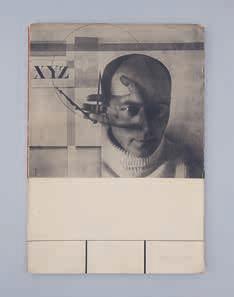
ROH , Franz (editor). Foto-Auge. Stuttgart, Akademischer verlag dr. Fritz Wedekind & Co., 1929. [ref. 110760] £2500
Foto-Auge is the key survey of New Vision photography and an exemplary example of the New Typography, referred to in a contemporary review by Walker Evans in Hound and Horn (OctDec 1931) as a ‘nervous and important book’.
Franz Roh and Jan Tschichold conceived the idea for this anthology during a joint visit to the Film und Foto exhibition at the Deutsche Werkbund, Stuttgart (18 May-7 July 1929), which travelled to Zurich, Vienna, Danzig (now Gdansk, Poland), Agram (now Zagreb, Croatia), Tokyo and Osaka. This pivotal exhibition was principally organised by Laszlo Moholy-Nagy with advisers including Edward Weston, Piet Zwart, and El Lissitzky, proposing work from their respective countries. The official Film und Foto catalogue was not illustrated, and Werner Gräff’s book Es kommt der neue Fotograf! (1929), published to coincide with the exhibition, only included a few exhibited images due to an early print deadline. Recognising the need for a visual record of this important show, Roh and Tschichold selected 76 works for their book. Roh and Tschichold continued their collaboration with the Fototek monographs on MoholyNagy (see items 74 & 75) and Aenne Biermann the following year. In an essay titled ‘The Value of Photography’ written for Hand und Maschine (Feb 1930), Roh wrote:
‘Of the people who reject the Werkbund exhibition, almost all are unused to today’s tighter, more constructive vision, not only in photography but in painting, architecture, and sculpture. Daring camera angles are taken for “mannerisms” (the usual objection to anything new). Photography is put to its best purpose, however, when it does not show things as they have been perceived for generations, but instead presents new approaches that are bolder and not yet exhausted.’
First edition; 4to (290 x 205 mm, 11½ x 8 in); black-and-white photographs and illustrations printed in relief halftone, essay and captions by Roh in German, French, and English, design by Jan Tschichold, old adhesive tape marks to inside covers and to first and last pages, tape and tape mark to margin of one page, occasional minor foxing; photo-illustrated and embossed card covers, folded in at spine and wire-stitched, spine printed in red and black; light wear, minor soiling and spotting, short tears to spine-folds at foot, a very good copy of a book that is prone to wear, with none of the usual fading to the red spine; 94pp.
Regards à travers Le Livre 30; Fotografia Pública 182-6; The Photobook: A History I, pp98-9; The Open Book pp82-3; Auer Collection p140; Autopsie II, pp330-49.

94
SANDER , August. Antlitz der Zeit. Sechzig Aufnahmen
Deutscher Menschen des 20. Jahrhunderts von August Sander. Mit einer einleitung von Alfred Döblin. München, Transmare Verlag, Kurt Wolff Verlag, 1929. [ref. 110993] £5000
These photographs, with their combination of stark objectivity and sympathy for the human condition, stand out as high points of photographic portraiture. They exerted a profound influence on later generations of photographers, among them Walker Evans, Diane Arbus, and Bernd & Hilla Becher, and collectively proposed the idea of the archive as a mode of artistic enquiry.
August Sander was one of the most significant portrait photographers working in Germany during the 1920s and 1930s. In the early 1920s, he moved away from the atmospheric, pictorialist style that characterised his earlier work in favour of an objective approach to his subjects. In 1924, Sander began Menschen des 20. Jahrhunderts [People of the Twentieth Century], an 'ambitious long-term project' to compile a comprehensive, inclusive visual record of the German people. Antlitz der Zeit [Face of Our Time] is the first published version of this series and the only version supervised by Sander in his lifetime. His inclusion of German citizens of various faiths, such as well as the unemployed, the disabled and other marginalised elements of German society, incurred the disapproval of the National Socialist party, and in 1936 the Nazis confiscated and destroyed unsold copies of Antlitz der Zeit and all of the printing plates.
First edition; 4to (286 x 214 mm, 11¼ x 8½ in); black-and-white photographs printed in relief halftone, minor toning to edges; plain endpapers, yellow cloth-covered flexible boards, spine and front stamped in dark grey, bottom edge a little dust-soiled, printed dust-jacket, lightly soiled, several small chips to edges and spine, splits to flap-folds, spotting to lower panel, a near-fine copy in a very good dust-jacket; 17, [1], [122]pp.
The Book of 101 Books pp52-3; The Photobook: A History I, p124; The Open Book pp84-5; Auer Collection p139; Autopsie I, pp302-9
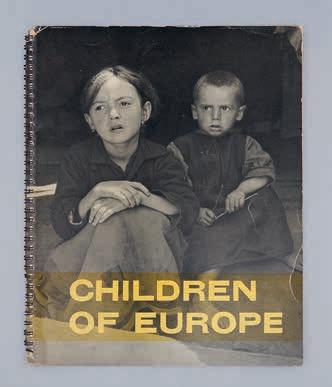
95
SEYMOUR , David [‘Chim’, born Dawid SZYMIN]. Children of Europe. Photos by David Seymour. Publication No 403 of the United Nations Educational, Scientific and Cultural Organisation. Paris, UNESCO, 1949. [ref. 111219] £975
David ‘Chim’ Seymour made his reputation as a photojournalist with his extensive coverage of the Spanish Civil War; work characterised by his humanistic perspective and earlier training in the graphic arts. In 1947, he joined Robert Capa, Henri Cartier-Bresson, George Rodger, and William Vandivert as co-founding photographers of the Magnum photo agency. The following year, the United Nations Children’s Emergency Fund (UNICEF) commissioned Chim to photograph the orphans and other children who endured extreme physical and psychological stresses as a result of World War II.
Chim spent over six months working on the commission, travelling to Austria, Greece, Germany, Hungary, Italy, and Poland. A selection from this series was published in LIFE in December 1948, with the present book published the following year. Children of Europe was issued in English, French, and Spanish editions and was influential in building sympathy in America for the Marshall Plan to rebuild Europe (see item 69). The introduction, ‘Letter to a grown up,’ and captions are written from the perspective of a young narrator speaking on behalf of these children. It ends with a brief paragraph: ‘Share your world with us. We too shall be grown-up people in a few years. Do not abandon us a second time and make us lose forever our faith in the ideals for which you fought’.
First edition; 8vo (224 x 182 mm, 8¾ x 7¼ in); black-and-white photographs printed in gravure, introduction in English, captions in French, English, and Spanish, light toning, occasional tears to tabs; photo-illustrated wire spiral-bound card covers, printed in yellow, wear to edges with small loss at head and foot, handling creases, a very good copy, scarce; 60pp.
Magnum Photobook p11, pp21–3.

96
THREE BOOKS IN EDITIONS OF 20
SHORE , Stephen. Three iPhoto artists’ books: KT Ranch July 1969 [with] Merry Christmas. Los Angeles CA. 2005; [and]
Merry Christmas. Tivoli, NY December 2006. Tivoli, NY, selfpublished, 2003; 2006; 2006. [ref. 111835] £5000
A group of three of Stephen Shore’s artists’ books produced using Apple’s print-on-demand iPhoto software. Shore began making these books in the spring of 2003 and first exhibited them at 303 Gallery, New York, that Autumn. Each book is a visual record of Shore’s activities on a given day. The first book, KT Ranch, is interesting as it features archive photographs, an example of work made before Shore defined the parameters of the project: initially photographs taken over one day, he later refined it to be photographs taken during the course of one day on days when The New York Times deemed it appropriate to print a full-width six-column headline on its front page.
KT Ranch is not included in The Book of Books: Photographs by Stephen Shore (2012), the survey of this project published in an edition of 250. The other two books are featured, and these are inscribed to Bill Charles, an agent who represented Shore and other artists, including Joel Sternfeld, Jeff Mermelstein, Adam Broomberg & Oliver Chanarin, and Larry Sultan, for commercial work in the late twentieth and early twenty-first centuries. Added to the group is a book by John Midgeley, another photographer who worked with Bill Charles, which was also produced as an iPhoto book.
‘KT Ranch’: First edition, number 2 of 20 copies signed on the title-page; oblong 4to (215 x 278 mm, 8½ x 11 in); black-and-white photographs printed in digital offset; grey textured endpapers with ‘made on a mac’ printed on rear pastedown, black cloth-covered boards with photographic title label mounted on upper side, label marked, gallery label laid in at rear, light rubbing, near-fine; [24]pp.
‘Merry Christmas Los Angeles’: First edition, number 5 of 20 signed copies, presentation copy inscribed ‘For Bill / From Stephen’ on the title-page; oblong 4to (215 x 278 mm, 8½ x 11 in); colour photographs printed in digital offset; grey textured endpapers with ‘made on a mac’ printed on rear pastedown, burgundy cloth-covered boards with photographic title label mounted on upper side, fine; [20]pp.
‘Merry Christmas Tivoli’; First edition, number 4 of 20 signed copies, presentation copy inscribed ‘For Bill / Season’s Greetings
/ Stephen’ on the title-page; oblong 4to (215 x 278 mm, 8½ x 11 in); colour photographs printed in digital offset; grey textured endpapers with ‘made on a mac’ printed on rear pastedown, black cloth-covered boards with photographic title label mounted on upper side, minor rubbing, near-fine; [20]pp.
Provenance: Bill Charles (author’s presentation inscription).
The Book of Books: Photographs by Stephen Shore

97
SISKIND, Aaron. Aaron Siskind Photographs. Introduction by Harold Rosenberg. New York City, Horizon Press, 1959. [ref. 111670] £675
Aaron Siskind’s first monograph with a small group of exhibition ephemera including two Light Gallery invites addressed to his friend, Maria Lipkind (nee Cimino). After an initial career teaching English in public schools, Siskind joined and was actively involved in the New York Workers’ Film and Photo League (1932-35) and later the Photo League (1936-41). He distanced himself from these groups in the early-forties, saying that ‘the so-called documentary picture left me wanting something... For some reason or other, there was in me the desire to see the world clean and fresh and alive, as primitive things are clean and fresh and alive. He began experimenting with the medium’s capacity for abstraction, making photographs of rocks, rust, graffiti and peeling plaster, echoing and influenced by his association with Franz Kline and the emerging Abstract Expressionist painters.
First edition; 4to (331 x 254 mm, 13 x 10 in); black-and-white photographs printed in relief halftone, design by Ivan Chermayeff, minor toning to edges; tan endpapers, black cloth-covered boards, titles stamped in silver and red on spine and in silver on upper side, minor wear to corners, photo-illustrated dustjacket, printed in black and red, light wear to extremities, two short tears to top edge of upper panel, one with creasing, minor toning, light creasing to head of spine, with a leaf of paper laid in at title-page, also laid in are three exhibition invitations, one exhibition invitation/prospectus, and a press release, near-fine in an excellent dust-jacket; [112]pp.
The Book of 101 Books pp152–5; The Photobook: A History I, p250; The Open Book pp180–1.

98 WITH 20 ORIGINAL PHOTOGRAPHS AS OPPOSED TO 19
SMITH , Jack. The Beautiful Book. New York, Dead Language Press / Piero Heliczer, 1962. [ref. 110662] £20,000
Jack Smith is a key figure in the cultural history of Downtown New York; his influence is foundational in the history of experimental film, queer cinema, and performance art, helping transform the artistic landscape of New York. This copy of The Beautiful Book includes an additional image, meaning it contains 20 gelatin silver photographs instead of the usual 19 (18 photographs by Smith and one portrait of Smith by Ken Jacobs). Except for the additional photograph, the sequence of the images remains consistent with other copies but with one print orientated differently.
The Beautiful Book was produced in an intended but unrealised edition of 200 copies. Jack Smith, Piero Heliczer, and their associates assembled the books during the late spring and early summer of 1962 before shooting began on Smith's film Flaming Creatures (1963), one of the most notorious underground films of the 1960s, which became a test case of censorship laws. The Beautiful Book contains photographs taken during an extended series of photo sessions at Smith's Lower East Side apartment between 1961 and 1962. He planned to give them to Jonas Mekas's Film Culture magazine as a series titled ’16 Immortal Photographs'. However, Film Culture declined to publish the work, so Smith produced The Beautiful Book with Piero Heliczer's The Dead Language Press instead.
First edition, one of a planned edition of 200 copies; 4to (225 x 190 mm, 8¾ x 7½ in); 20 gelatin silver contact photographs (55 x 55 mm, 2¼ x 2¼ in) mounted on yellow pages, minor occasional mirroring; wire-stitched card covers printed in black and yellow after a design by Marian Zazeela, slight crease to foot of spine, stray ink marks to inside covers with minor offsetting to first and last pages, bottom wire pulling at spine, near-fine; [20pp].
Flaming Creature p77; The Open Book pp190–1.

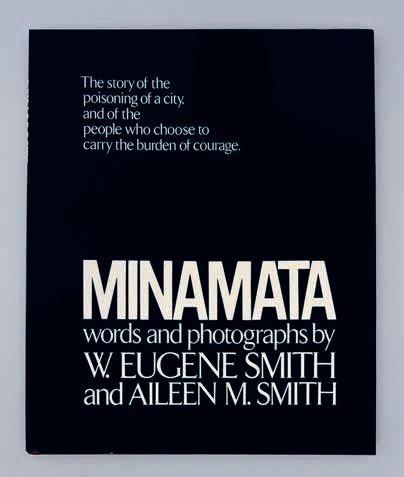
99
PRESENTATION COPY
SMITH , W. Eugene & M [IOKO], Aileen. Minamata. Words and photographs by W. Eugene Smith and Eileen M. Smith. and Winston, 1975. [ref. 111559] £675
Presentation copy, inscribed: ’To Tom, / W. Eugene Smith / Aileen Smith / June 17, 1975’. In December 1971, Eugene Smith and his wife Aileen moved to the town of Minamata in Kumamoto prefecture, Kyushu, Southern Japan, where they spent three years photographing and researching the devastating effects of mercury poisoning on the local populace caused by the Chisso Corporation factory dumping industrial waste into Minamata Bay and the Shiranui Sea, polluting the water and contaminating fish and shellfish, which members of the community subsequently ingested.
During their time in Minimata, Eugene Smith was intimidated and severely beaten by Chisso employees. ‘This is not an objective book,’ he writes. ‘The first word I would remove from the folklore of journalism is the word objective. That would be a giant step toward truth in the “free” press. And perhaps “free” should be the second word removed. Freed of these two distortions, the journalist and photographer could get to his real responsibilities. My belief is that my responsibilities within journalism are two. My first responsibility is to my subjects. My second responsibility is to my readers. I believe that if I fulfil those two responsibilities I will automatically have fulfilled my responsibilities to the magazine.’ Minimata is his last and arguably most important work.
First edition, presentation copy inscribed on the half-title; 4to (290 x 237 mm, 11½ x 9¼ in); black-and-white photographs; grey endpapers with minor fading to edges, burgundy leatherettecovered boards, titles stamped in white on spine and on upper side in blind, nicks to top edge, printed price-clipped dust-jacket, navy, minor rubbing to sides, nick to lower top edge, ex-libris of Tomas Van Blarcom[?] to front pastedown, near-fine; 192pp.
The Book of 101 Books pp232–3; Magnum Photobook pp66–7.
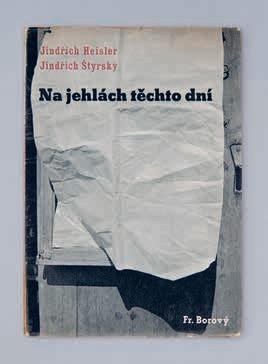
100
STYRSKY, Jindrich. Na jehlách těchto dní [On the needles of these days]. Prague, Fr. Borovy, 1945. [ref. 111548] £1250
First edition thus of this meditation on resistance, after the scarce original clandestine version with gelatin silver photographs produced by the artists in a small number of copies during the Nazi occupation of Czechoslovakia. During the war, Heisler, who was Jewish, was sheltered by Styrsky and his partner Toyen and then by Toyen alone after Styrsky died in 1942. Fr. Borovy issued this posthumous edition with gravure reproductions as soon as the war ended. Devoid of people, Styrsky’s photographs are drawn from three series he made in Paris and Prague between 1934 and 1935; his subjects include shop windows, mannequins, building facades and street signs. It is Heisler’s text which makes the book’s intention clear, ending with a passionate cry to rise against the Nazi occupation: ‘The fire, today so carefully locked up, will open out wide and will pass from hand to hand.’
First edition; 8vo (212 x 150 mm, 8¼ x 6 in); black-and-white photographs printed in gravure by Neubert a synové, design by Karel Teige, minor offsetting to facing pages; photo-illustrated wrappers printed in black and red, light wear to extremities, starting at head, a very good copy in the probably original, almost certainly contemporary, lightly worn tissue dust-jacket; 64, [4]pp.
The Book of 101 Books pp116–7; The Photobook: A History I, p197; The Open Book pp140–1; Czech and Slovak Photo Publications 268.

101
SUZUKI , Kiyoshi. Nagare no uta [A Flowing Song] / Soul and Soul. Tokyo, self-published, 1972. [ref. 111215] £1500
Soul and Soul is Suzuki Kiyoshi’s first book; it is a homage to his childhood home, which was close to the Joban coal mine in Fukushima Prefecture, one of the major coal mines in Japan, and a meditation on time. With energy use shifting towards oil, Suzuki witnessed the Japanese coal industry’s gradual decline after World War II.
Suzuki later befriended Robert Frank through Motomura Kazuhiko (see items 40, 41 & 99), and the two exchanged correspondence and photographs over many years. Like Frank, Suzuki developed a distinctly personal and somewhat cinematic aesthetic. His books are carefully sequenced, allowing for gradual unfolding narratives. Soul and Soul displays several traits that are consistent in his later books: a subjective relationship with his subject, layering of time, influences and referential images, and an interest in the way that chaos can permeate everyday life.
First edition; oblong 4to (203 x 227 mm, 8 x 9 in); black-andwhite photographs printed in relief halftone by Otake Bijutsu, Tokyo; light yellow endpapers, black cloth-covered boards, titles stamped in gold on spine, photo-illustrated dust-jacket, white, printed in black, light wear to extremities, nick to head of spine, short tear to top and to bottom edge of lower panel, fine in a nearfine dust-jacket; [92]pp.
Japanese Photobooks of the 1960s and ‘70s pp188–191; For a New World to Come 229; The Japanese Photobook 335.

102
TOMATSU, Shomei. 11-ji 02-fun (11:02) Nagasaki. Tokyo, Dojinsha, 1966. [ref. 111161] £1375
In 1961, Shomei Tomatsu began a series of close-up photographs of objects found at the explosion site at Nagasaki. These include a watch, stopped at precisely 11:02, a headless statue, and a warped glass bottle that serves as a horrific metaphor for all of the mined bodies and lost lives.
Tomatsa had initially intended for 11:02 Nagasaki to be the first in a series of four separate books, the others being ‘Osorezan: Countryside Politicians’, ‘Homes, Asphalt’, and ‘Occupation’. However, sales of 11:02 Nagasaki were poor, and the publisher, Shashin Dojinsha, collapsed soon after its publication. The remaining three volumes were never realised individually, but Tomatsu subsequently formed his own publishing company called Shaken, and in 1967, he published Nihon, which included photographs from these series. In 1968, he took the remaining unsold copies of 11:02 Nagasaki, changed the copyright page, and placed a sticker bearing the new publisher's name on the spine.
First edition, author’s hanko stamp; 4to (221 x 189 mm, 8¾ x 7½ in); black-and-white photographs printed in sheet-fed gravure, text by Tamaki Motoi and interviews with survivors; photo-illustrated paper-covered boards, minor foxing, light toning to spine, original printed cardboard slipcase, lightly worn, publisher’s brown printed insert laid in, without the acetate, nearfine; [172]pp.
The Photobook A History I,pp274–7; The Open Book 226–7; Auer Collection p454; The Japanese Photobook 293.
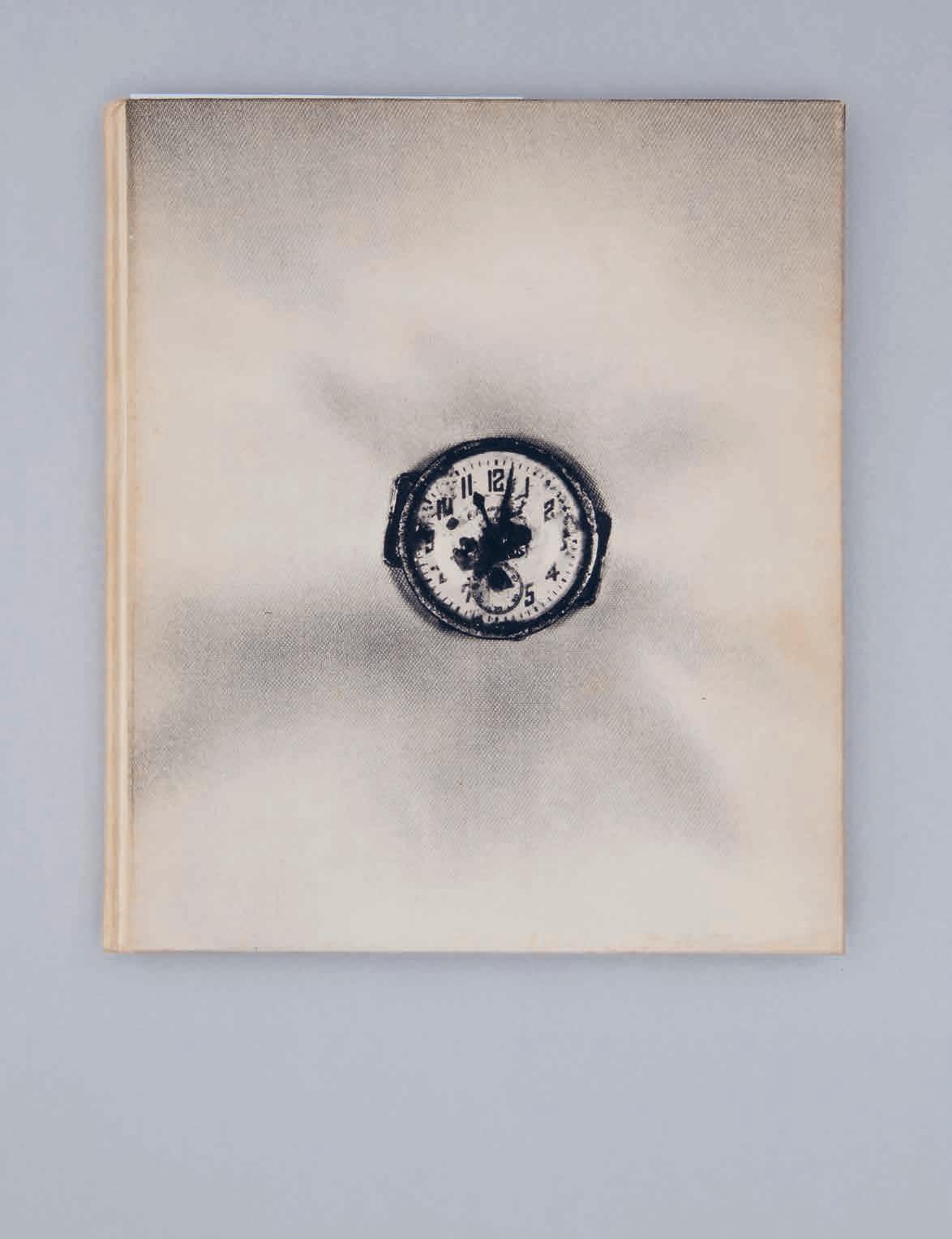
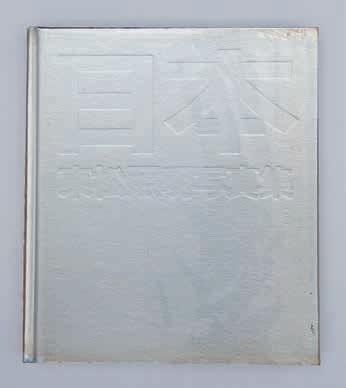
103
TOMATSU, Shomei. Nihon [Japan]. Tomatsu Shomei shashinshu, Tokyo, Shaken, 1967. [ref. 111061] £1250
Nihon is concerned with Japan’s post-war national identity. Tomatsu Shomei took most of the photographs between 1955 and 1967 while working for various publications. He had initially intended for the work published here to be issued in three separate books: ‘Osorezan: Countryside Politicians’, ‘Homes, Asphalt’, and ‘Occupation’, which were to follow 11:02 Nagasaki (1966). However, sales of 11:02 Nagasaki were poor, and the publisher, Shashin Dojinsha, collapsed soon after its publication. Tomatsu subsequently formed his own publishing company called Shaken to distribute the remaining copies of his Nagasaki book. In 1967, he published Nihon, which included photographs from the three previously proposed books divided into nine sections. Although many of the images had been previously published, in a text at the end, Tomatsu notes that in editing and sequencing this book, he has reframed some of the meaning in these photographs.
First edition; 4to (219 x 190 mm, 8½ x 7½ in); black-and-white photographs printed in gravure, texts by Fukushima Tatsuo, Isozaki Arata, Taki Koji, edges toned; blue endpapers with small bookseller’s ticket, silver cloth-covered boards, titles stamped in black on spine and on upper side in blind, publisher’s plastic dustjacket, chipped at top edge and head, spine toned, publisher’s printed blue sheet laid in, near-fine in a very good dust-jacket; [200]pp.
Auer Collection p479; Japanese Photobooks of the 1960s and ’70s pp94–101; Provoke: Between Protest and Performance 21 pp130–1; The Japanese Photobook 293.

104
TOMATSU, Shomei. Oh! Shinjuku. Tokyo, Shaken selfpublished, 1969 [ref. 111560] £1250
Shinjuku is a major commercial and administrative centre and was the centre of Japanese avant-garde art and theatre. Oh!
Shinjuku presents photographs taken during the large and violent student protests on October 21 1969, International Anti War Day (see item 88) with pictures depicting theatre performers, strippers, and pedestrians.
First edition; oblong 4to (187 x 259 mm, 7¼ x 10¼ in); blackand-white photographs printed in offset, light toning to edges, creasing to final leaf; photo-illustrated wrappers printed in grey and black, light wear to extremities, former owner's name to inside lower wrapper, close to near-fine; [102]pp.
The Photobook: A History I, p290; For a New World to Come 281; The Japanese Photobook 305.
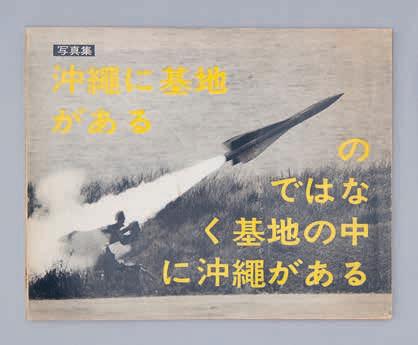
105
TOMATSU, Shomei. Shashinshu Okinawa, Okinawa, Okinawa. Tokyo, Shaken self-published, 1969. [ref. 111549] £1000
Okinawa, Okinawa, Okinawa is a politically driven book focusing on the continued presence of American military bases in Okinawa. While the United States occupation of Japan officially came to an end in 1952, Okinawa remained officially off-limits for Japanese nationals until it reverted to Japanese sovereignty in 1972. In the late 1950s, Shomei Tomatsu began a significant series photographing American military bases in Japan. In 1968, after being subjected to a vetting process given
to all Japanese citizens who wished to visit, he was granted access to travel to Okinawa for the first time. The photographs, many of which compare stylistically to the Provoke photographers, contrast aspects of traditional Japanese life with images of the US occupying forces and protests against their presence.
The text on the cover reproduces a slogan used by protesters: 'Okinawa ni kichi ga aru no dewa naku kichi no naka ni Okinawa ga aru' [It is not that there are military bases located in Okinawa, but rather, Okinawa is located within the military bases].
First edition; oblong 4to (261 × 210 mm, 10¼ x 8¼ in); blackand-white photographs printed in gravure by Gurabia Seikosha, Tokyo, light toning; photo-illustrated wrappers, printed in yellow and black, light wear to extremities, light rubbing, light marking on
lower side, publisher's ticket laid in, a very good copy in a custom paper-covered board slipcase and chemise; [96]pp.
For a New World to Come 282; The Japanese Photobook 235.
106
[
WARHOL , Andy]. FINKELSTEIN , Nathan Louis ‘Nat’. Publisher’s file photographs for Andy Warhol: The Factory Years 1964-1967. Printed 1980s. [ref. 101257] £6500
The publisher used these prints during preparation for Nat Finkelstein’s 1989 book Andy Warhol: The Factory Years 19641967.
20 gelatin silver photographs (89 x 127 mm, 3½ x 5 in or the reverse); in mounts.

[
WORKSHOP PHOTOGRAPHY SCHOOL]. TOMATSU, Shomei; MORIYAMA , Daido; ARAKI , Nobuyushi; HOSOE , Eikoh; FUKASE , Masahisa; YOKOSUKA , Noriaki et al. Workshop 1-8 [all published]. Tokyo, Workshop Shashin Gakko, September 1974-July 1976. [ref. 110755]
£8750
Workshop was the eponymous journal of Workshop Shashin Gakko. This independent photography school taught limitedenrolment classes by its co-founders, Tomatsu Shomei, Moriyama Daido, Araki Nobuyushi, Hosoe Eikoh, Fukase Masahisa, and Yokosuka Noriaki. Each photographer taught a workshop for a period of one year, with a strong emphasis on one-to-one teacher-student relationships. The journal actively explored new trends in photography through essays and criticism by members of the group and others. Issue 4 was edited by Araki and was based on the simple theme of ‘making photography,’ for this issue, he contributed an essay on how to shoot good portraits. Issue 6 was the most controversial issue, published in January 1976, which announced, ‘We Will Sell Photographs: An Exhibition of Photographs Selected by Twelve Photographers,’ which was issued to accompany an exhibition in February 1976 as an attempt to present photographs as commodities. At that time in Japan, as elsewhere, sales of photographs as works of art were virtually non-existent, and there was some resistance to the idea, most notably from Norio Asaki in Asahi Camera.
The Workshop Photography School lasted from April 1974 until March 1976, but one last journal issue was issued in July 1976. This eighth issue featured ‘A Roundtable Discussion with Names Withdrawn: Bashing Photography Magazines,’ in which the Workshop teachers set about challenging the conventional views of photography put forward by V and other photography magazines, as well as criticising popular photographers, including Kitai Kazuo and Shinoyama Kishin.
The school continued briefly as Araki’s Private Photo School until 1977, when Araki offered another one-year workshop. The Workshop Photography School paved the way for several independent galleries and organisations that followed, such as Image Shop Camp, Photo Gallery Prism, and Photo Gallery Put.
First editions; issue 1 loose sheets folded horizontally as issued (390 x 267 mm, 15¼ x 10½ in), issues 2-4 tabloids folded horizontally as issued (436 x 280 mm, 17¼ x 11 in), issues 5-8 narrow 4to (281 x 148 mm, 11 x 5¾ in); black-and-white photographs printed in offset; issues 1-4 lightly toned, occasional very minor spotting, issues 3 and 4 with light wear to edges and short tear to spine at fold, issues 5-8 wire-stitched photoillustrated wrappers, white printed in black, lightly rubbed, light handling marks, oxidation to staples, issue 8 with an abrasion to upper top right corner, an excellent to near-fine set; 16; 16; 16; 16; 72; 80; [72]; 72pp.
For a New World to Come 354–358.

A Book of Araki Books! 1970–2005, Kotaro, I., Tokyo 2006.
Alibis: Sigmar Polke 1963–2010, Halbreich, K. et al., New York 2014.
Artists’ Magazines: An Alternative Space for Art, Allen, G., Cambridge, Massachusetts 2011.
Artists Who Make Books, Roth, A., Aarons, P. and Lehmann, C., London 2017.
Auer, M. and M., 802 photo books from the M+M Auer Collection, Hermance 2007.
Autopsie: Deutschsprachige Fotobücher 1918–1945, 2 vols, Heiting, M., Göttingen 2012-2014.
Bernd und Hilla Becher: Printed Matter 1964–2013, Blaser, J.-C. and de Beaupré, A., Lausanne 2013.
Bibliographie des ouvrages érotiques II, Dutel, J.-P., Paris 2005.
Boltanski: Artist’s Books 1969–2007, Calle, B., Paris 2008.
Book as Artwork 1960–1972, Celant, G., London 1972.
Brassai: Letters to My Parents, Chicago 1997.
Bruce Nauman: Prints 1970–89 A Catalogue Raisonné, Cordes, C. et al., New York 1989.
Czech and Slovak Photo Publications, Heiting, M., Göttingen 2018.
Dada and Surrealism Reviewed, Ades, D., London 1978.
Errata Editions: Books on Books no. 5, no. 13, Ladd, J. et al., New York 2010-2012.
Esthétique du Livre d’Artiste 1960-1980, Moeglin-Delcroix, A., Paris 1998.
Eyes on Paris: Paris im Fotobuch 1890 bis heute, Koetzle, H.-M., Munich 2011.
Extra Art: A Survey of Artists’ Ephemera 1960-1999, Perez, P., Santa Monica 2001.
(Flaming Creature) Jack Smith: Flaming Creature, Leffingwell, E. et al., London 1997.
For a New World to Come: Experiments in Japanese Art and Photography 1968–1979, Nakamori, Y., Houston 2015.
Fotografía Pública: Photography in Print 1919 –1939, Fernandéz, H., Madrid 1999.
Imagining Paradise: The Richard and Ronay Menschel Library at George Eastman House Rochester, Foster, S., Heiting, M. and Stuhlman, R., Göttingen 2007.
In Numbers: Serial Publications by Artists, Aarons, P. and Roth, A., New York 2009.
Japanese Photobooks of the 1960s and ’70s, Kaneko, R. and Vartanian, I., New York 2009.
L’Enfer de la bibliothèque. Éros au secret. B.N.F., Quignard, M.-F., Paris 2007.
Les livres de l’Enfer, Pia, P., Paris 1998.
Magnum Photobook: The Catalogue Raisonné, Ritchin F. and Naggar, C., London 2016.
Paris: Les livres de photographie des années 1920 aux années 1950, Bouquret, C., Paris 2012.
Peter Henry Emerson with Camera and Pen: An Annotated Bibliography of His Major Word-Picture Publications by Kahan, R. and Colson, J., in The Library chronicle of the University of Texas at Austin, no.5 (1972):68–81.
Photographers of the Farm Security Administration: An Annotated Bibliography 1930–1980, Dixon, P., New York 1983.
Photography in the Modern Era: European Documents and Critical Writings 1913–1940, Phillips, C., New York 1989.
Provoke, Roth, A., New York 1999.
Provoke: Between Protest and Performance, Dufour, D. and Witkovsky, M., Göttingen 2016.
Regards sur un siècle de photographie à travers Le Livre, Sinibaldi, A. and Couturier, J.-L., Paris 1996.
Self Life Death: Nobuyoshi Araki, Kotaro, I., London 2005.
Sigmar Polke: The Editioned Works 1963–2000 Catalogue Raisonné, Becker, J. et al., Berlin 2000.
Steam Steel & Stars: America’s Last Steam Railroad, Link, O. W., New York 1987.
Surrealism: Desire Unbound, Mundy, J., Princeton 2001.
Swiss Graphic Design: The Origins and Growth of an International Style 1920–1965, Hollis, R., New Haven 2006.
Swiss Photobooks from 1927 to the Present, Pfrunder, P., Zurich 2012.
The Book of Books: Photographs by Stephen Shore, Rosenheim, G., London 2012.
The Book of 101 Books: Seminal Photographic Books of the Twentieth Century, Roth, A., New York 2001.
The Complete Works of Marcel Duchamp, Schwarz, A., New York 2000.
The Dutch Photobook: A Thematic Selection from 1945 Onwards, Gierstberg, F. and Suermondt, R., New York 2012.
The Japanese Photobook 1912–1990, Kaneko, R. and Heiting, M., Göttingen 2017.
The Open Book: A History of the Photographic Book from 1878 to the Present, Roth, A. et al., Gothenburg 2004.
The Photobook: A History, 3 vols, Parr, M. and Badger, G., London 2004–2014.
The Truthful Lens: A Survey of the Photographically Illustrated Book 1844–1914, Goldschmidt, L. and Naef, W., New York 1980.
What They Saw: Historical Photobooks by Women, Lederman, R. and Yatskevich, O., New York 2021.
Shapero Rare Books Ltd
105–106 New Bond Street
London W1S 1DN
+44 (0)20 7493 0876
rarebooks@shapero.com www.shapero.com
VAT Number GB 105 103 675
A member of the Scholium Group

Terms & Conditions
The conditions of all books has been described and all items in the catalogue are guaranteed to be complete unless otherwise stated. All prices are nett and do not include postage and packing. Invoices will be rendered in GBP (£) sterling. The title of goods does not pass to the purchaser until the invoice is paid in full.
Front & back cover – item 68
Inside front & back cover – item 04
NB Ilustrations are not equally scaled. Exact dimensions will be provided on request.
Catalogued by Oliver Wood
Edited by Jeffrey Kerr
Photographed by Natasha Marshall

